Don't wanna be here? Send us removal request.
Text
Assignment 12 Final Draft: Are You Scared Yet?

Figure 1. There Will Come Soft Rains by Sara Teasdale. (Personal Photo)
I’ve always been afraid of the end of the world. I would cry during a rainstorm or even if the sky became grey midday. I always felt, deep down, that a freak weather incident would be the way we would all go. Then, when I was in high school, I took an AP environmental science class and was enlightened by what I learned was going on in our world. I felt that my suspicions had been somewhat correct, in that if we don’t change the way we live, mother earth will wreak havock on the human population. And to be honest, I don’t blame her.
The chapter starts with a quote by Justin Trudeau, the Canadian Prime Minister, who said “No country would find 173 billion barrels of oil in the ground and just leave them there” (Lewis and Maslin 368). I wondered, why not? Why are we so conditioned to just continue to take and take with the assumption that because no human has laid their claim on it, that we have the right to take it? It seems unjust to me that we find ourselves so superior to all other life on earth.
This chapter outlines that there are “three possible futures: continued development of the consumer capitalist mode of living towards greater complexity; a collapse; or a new mode of living” (Lewis and Maslin 2018, 369). I personally hope we choose the third route, since the first one is unsustainable for our lives to continue, and the second implies death of the human race. The third option implies that what we spend our time doing would effectively change, and so would our planetary impacts.
Business as Usual
Historically, human societies have been adaptive to change, and this leads the authors to believe that we will rely on innovation and technological advancement to save us from the inconvenience of change. The book cites three major reasons why the current mode of living is unlikely to continue:
Positive feedback loops (problems building on more problems) drive the current system and end in fundamental changes.
The energy, information and collective human agency factors that underlie all human societies are changing at exponential rates.
There are core environmental challenges which may cause collapse.
The second reason stands out prominently. The world is more interconnected now than it has ever been, and it is easier for communication to have a farther reach. This suggests that greater numbers of people are able to take collective action than at any other time in history, and collective action often incites change. With more people and more connection, more ideas are produced. However, the ideas being produced currently are those which allow us to continue to live how we want to with no environmental consequence. These are ideas like green energy, which are meant to provide an infinite source of energy for people to continue consuming. Consumption is inherently unsustainable and can cause collapse at high levels. These are the consequences of the exponential growth we are experiencing.

Figure 2. Replacements for Plastic. (Personal Photo).
Collapse?
This begs the question, are we doomed for collapse? It seems that the greater power that humans have across the world, the greater the opportunity for such power to be damaging (Lewis and Maslin 2018, 378). As humans gain power, they also gain access to more technology and resources which have the capacity to ruin us. This is seen with our own country relying on “cheap” fuels to power us and keep us “efficient.” I quote these words because obviously coal is not cheap, when the full costs are considered and the efficiency of our country relies on cheap labor that laborers rarely reap the benefits of.
The book suggests that this is not even our biggest threat. “The central, pressing, existential threat to human civilization results from a core contradiction in today’s mode of living: it is powered by energy sources that are undermining the ability of today’s globally integrated network of cultures to persist” (Lewis and Maslin 2018, 378). Fossil fuels are considered a trap for progress because of the obstacles their emissions cause: climate change. “The rate and magnitude of climate change are closely correlated with the cumulative emissions of carbon dioxide” (Lewis and Maslin 2018, 379). But it’s not really the CO2 destroying the planet, it’s us. We emit the CO2 and are addicted to fossil fuels. This addiction must cease to exist in order for us to survive. We (humans) must stop, systemically.
A huge problem lies in what our leaders are telling us, which is different everywhere. In some places, there is a huge shift to green energy and lowering of individual and collective footprints. In other places, this is a niche “belief” of some sort. It also is confusing when there is no real physical marker for the change, since our leaders are preaching that we limit our atmospheric warming from 1.5ºC to 2ºC. It’s hard to track something we are avoiding, I think. It would be much better for leaders to try and lower the current warming, rather than stick to the status quo. Especially because these proposed metrics are too high in some areas of the world for survival. This is considered a shortfall of the Paris Climate Agreement; it is not comprehensive enough.
But as the chapter shows, event the current proposals are quite hard to reach, and will require “halving global greenhouse gas emissions in every decade going forward, doubling the share of renewables in the energy system every five years, ending deforestation, and reconfiguring agriculture and our diets (so we eat less beef and more plants)” (Lewis and Maslin 2018, 382).
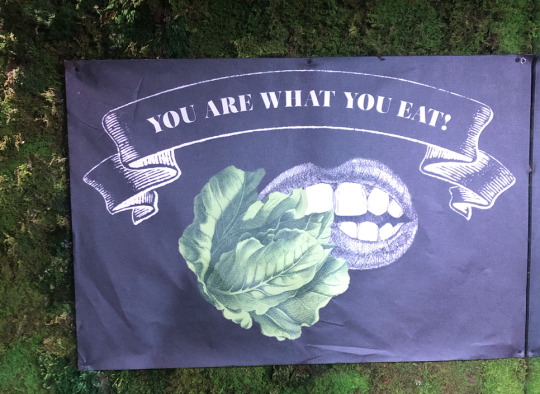
Figure 3. Flag from Arcadia Earth Exhibit. (Personal Photo).
Though we need to ban the use of fossil fuels everywhere, the only part I find fault with here is relying too heavily on green energy, because the configuration and support systems of the current green energy models still rely heavily on fossil fuels. Countries also don’t necessarily want to make the switch to clean energy because it costs more and does the same, if not a worse, job at providing livelihood. Fossil fuels have been long subsidized and these subsidies are hard to lift due to nationalization, that is, the state-owned oil companies make money for the governments that own them. Additionally, this plan overall is highly ambitious and requires all societies “to place the eradication of greenhouse gas emissions at the same level of importance as the pursuit of economic growth” (Lewis and Maslin 2018, 382). I wonder if this is truly possible is our ever growing capitalist society.
It is clear that the mode of living must change to avoid climate change and collapse. Otherwise, human societies will be unable to manage the consequences, and we will die. These consequences include, but are not limited to, food shortage (which will occur as a result of unpredictable climate ruining crops and our GMOs and pesticides have ruined the soil in irreversible ways), unlivable habitats (due to flooding as a result of sea level rise and unbearable heat), and of course civil unrest. The pentagon sees climate change as a threat multiplier, which means that the problems that already exist in our world will be exacerbated on unprecedented levels.
Equality is Necessary
I have long been weary of the communist socialist arguments toward climate change, thinking that agendas are being pushed that are unfavorable. However, I have come to realize that I have been privileged and conditioned to believe that capitalism is good because it has served me. I have been conditioned to believe that more is better.
Capitalism serves this message on a silver platter and has corrupted the human value system. In order to create a new mode of living, equality must exist in a variety of ways. Policies must limit climate change to avoid human suffering; we must focus on the human experience of all people, everywhere, and give value to all life. Everyone should also have access to information and education which will provide a more diverse global community to engage in collective action. Everyone in the global community should have access to healthy food; this should be a basic human right that is focused on more intently because food production currently is unbalanced and results in too much waste.
The unequal balance of economic power has historically favored the progress of the West and worsened the development of the global East. However, both East and West must work together to solve the climate crisis. The West has a larger debt to pay in this task because our emissions make up almost 100% of the emissions in the atmosphere. This was an interesting point since the textbook has repeatedly blamed poverty for rising temperatures. However, the West is hesitant to accept this reality, which presents a great challenge. The West is seemingly dependent on the East for resources, and they have become dependent on us for labor. This codependent relationship, as with any codependent relationship, is toxic and does not benefit either in the long-run. One way to reduce this dependency is with Universal Basic Income (UBI), which supports subsistence needs and covers healthcare. There would be no obligation to work, which would create an increase in autonomy and education. Equality is always a future aspiration, but it really shouldn’t be. We (the west) consume on irrational levels, so much that if global consumption was equal to that of the West, we would essentially be feeding the demand for 32 Billion people; this is impossible.

Figure 4. The Extinction Rebellion Protest. (DiCaprio, 2019).
It doesn’t help that the most comprehensive international document to date, the Paris Climate Agreement, has no clear penalties for countries who do not perform their pledged actions. This is so commonly a reason why nothing ever changes; there are no consequences for the status quo! If the Paris Agreement is truly implemented, the world will be transformed in ways that very few people understand or desire. Fossil fuel emissions won’t really be cut to zero, but rather managed in ways that aren’t truly sustainable and put a sort of band aid over the real issues.
The Stories We Tell Ourselves
The current story around climate action is that cutting fossil fuel emissions to zero is all good. However, the proposed methods of doing so are actually quite harmful to biodiversity and only exist to serve human nature. It is a convenient story which allows us to phase out of harmful choices, placing a large amount of ownness on the individual, rather than directly correlating the damage to fossil fuel industries. Using economic solutions to paint a picture of the future is ineffective because people exist in the physical state and numbers exist in the hypothetical. Policy-makers are relying on the economic story that is constantly told, that we are able to phase into a greener world, and that story is destructive to progress. It doesn’t accurately highlight the severity of the issues.
Something I also did not agree with in this chapter is the part about the materials revolution. While I think this type of revolution is definitely necessary, it still supports the culture of consumption, especially a centered reliance on recycling. Recycling is the least productive of the 4 R’s and requires a large amount of energy, which is exactly what we are trying to avoid. Rather than focusing on the elimination of waste or the recycling of waste, I think we should be focusing on the elimination of production of wasteful products. If we create products that people can reuse over and over again, then recycling ceases to be necessary. The story of recycling is damaging and continues to perpetuate environmental issues.
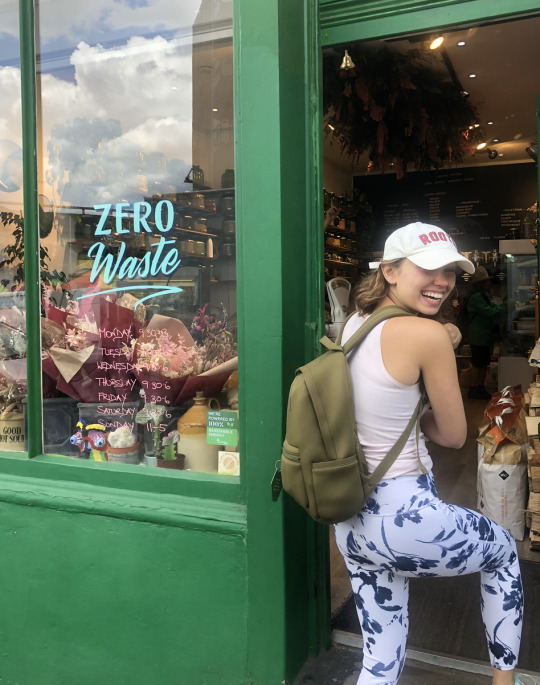
Figure 5. Zero Waste Store Liberté Chérie in London, England. (Personal Photo).
Another story we tend to tell ourselves is that of “deserving.” We say, “I’ve been active all week, I deserve an ice cream cone,” or “I have been studying all day, I deserve to watch a movie,” and especially “I have worked so hard, I deserve a vacation.” UBI, as mentioned above, breaks the link between work and consumption, which in turn lessens environmental impact. It does this by giving money with no expectation of anything in return, and by allowing people a stronger sense of free will. UBI is a controversial idea, but it really shouldn’t be. It has been shown that entrepreneurship, future planning, and environmental benefit increases with UBI; that doesn’t sound so bad.
We also have distanced ourselves from our food, in a way which causes us not to value it. Products are cheap, so they exist in surplus, but the environmental cost is high. Placing cheapness at the center of our perspective on food is damaging because we waste it since we don’t see a high value in it (similar to water). Yet another story we tell ourselves: food doesn’t matter, and we will always have it. How can that be true when the population is growing and we cannot survive without food? This is just one example of the values that must be transformed in order to create real radical change.

Figure 6. Outdoor Open Market in Nairobi, Kenya. (Personal Photo).
The planet can and will survive without us, but we cannot survive without it. I would like to believe we are experiencing some sort of transformation right now, while we are all stuck in our homes watching the world go on without us. We see pictures of massively lowered levels of pollution, and I hope we are acknowledging our destructive power. This is the first step, which hopefully can move us to transition to greener modes of life and economies. We need to rely less on innovation, and more on going back to basics and looking to nature to help.
Words: 2200
Question: Is it effective to be optimistic about the future of the human population? Can optimism create change?
References:
DiCaprio, Leonardo. [@leonardodicaprio]. (November 18, 2019). Gathering at India Gate in Dew Delhi to set up a panel to address Climate Change. [Instagram]. Retrieved from https://www.instagram.com/p/B5Av6eolKYJ/?igshid=1dtnvcp5xk0jw.
Lewis, S. and Mark Maslin. 2018. The Human Planet: How We Created The Anthropcoene. Connecticut: Yale University Press.
0 notes
Text
Assignment 11 Final Draft: How Can We Emphasize the Inherent Value of Water?
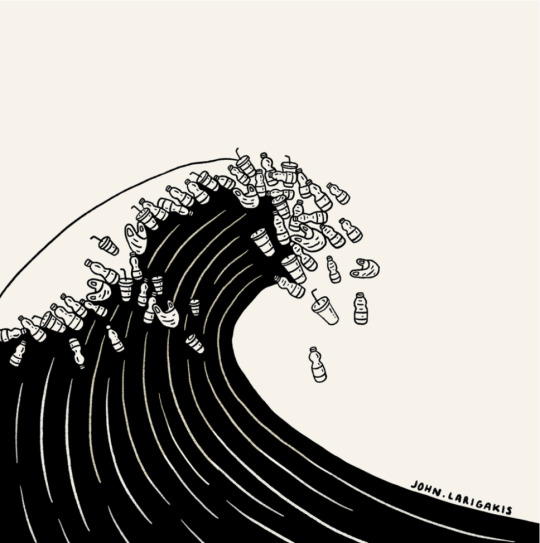
Figure 1. Plastic Wave (Larigakis, 2019).
“No Water, no life” -Sandra Postel (Miller and Spoolman 2016, 323). I always say, similar to Sandra, nothing else matters if we cannot breathe, and do not have clean water to drink. We cannot survive.
#WillWeHaveEnoughUsableWater?
“We are using available freshwater unsustainably by extracting it faster than nature can replace it, and by wasting, polluting and underpricing this irreplaceable natural resource” (Miller and Spoolman 2016, 325). Our planet is mostly water, and so are we. Though it is used for virtually every aspect of human life, it is poorly managed and too lowly valued, making it available at a low cost to many consumers. This low price encourages waste and pollution of the resource. Freshwater supplies are unevenly distributed across the globe, leaving one out of every ten people without access to clean water.
It is considered both a global health issue and an economic issue because while people do not have access to clean drinking water, it also is necessary for supporting livelihood which reduces poverty. Additionally, it is a national and global security issue due to rising tensions between nations over access to shared freshwater resources. Finally, it is of course an environmental issue because the overdraft of freshwater results in falling water tables, shrinking lakes, disappearing wetlands and pollution which degrades water quality and causes extinction of aquatic organisms and their ecosystem services. Less than 1% of the planet’s water is available as liquid freshwater in underground deposit, but it is continually recycled through the hydrologic cycle. This cycle is disrupted, however, by the pollution and overdraft of freshwater resources by humans. Additionally climate change and atmospheric warming is evaporating some of this water into the atmosphere. This means that wet areas will get wetter and drier areas will experience intense droughts.
#IsGroundwaterASustainableResource?
Groundwater is the freshwater stored underground and is a key component of freshwater capital. However, it is not a sustainable resource because it is being pumped from aquifers faster than it can be renewed by precipitation. The freshwater available from groundwater is used for a variety of activities that do not involve direct consumption, which is a waste. Over pumping aquifers for nonessential activity can be harmful to food production, rising food prices, and inequality.
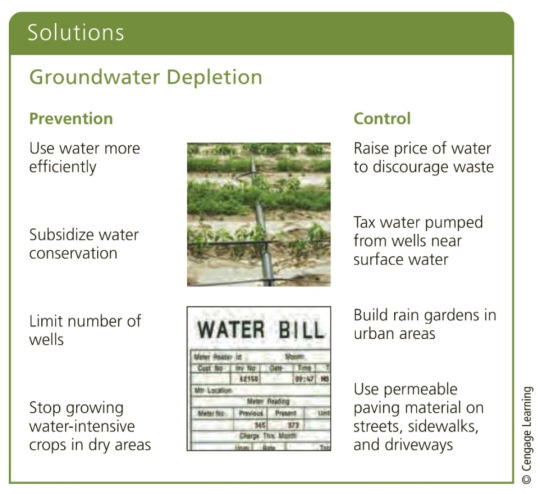
Figure 2. Ways to Prevent or Slow Groundwater Depletion (Miller and Spoolman 2016, 335).
As global shortages of freshwater become increasingly relevant, scientists are looking into tapping deep aquifers. There are five major problems associated with this idea:
The deep aquifers are nonrenewable.
Little is known about the consequences of pumping from deep aquifers.
No international treaties govern access of aquifers that flow between more than one country.
The financial costs of tapping deep aquifers are unknown.
The water may be salty and contaminated.
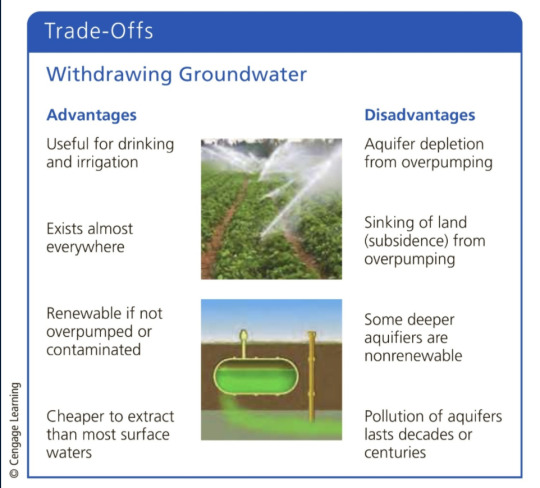
Figure 3. Trade-offs of Withdrawing Groundwater (Miller and Spoolman 2016, 327).
Overall this method is not worth the risks.
#HowCanWeIncreaseFreshwaterSupplies?
The dam-and-reservoir systems and water transfer projects have greatly expanded water supplies in some areas, but have degraded ecosystems and displaced communities in others.
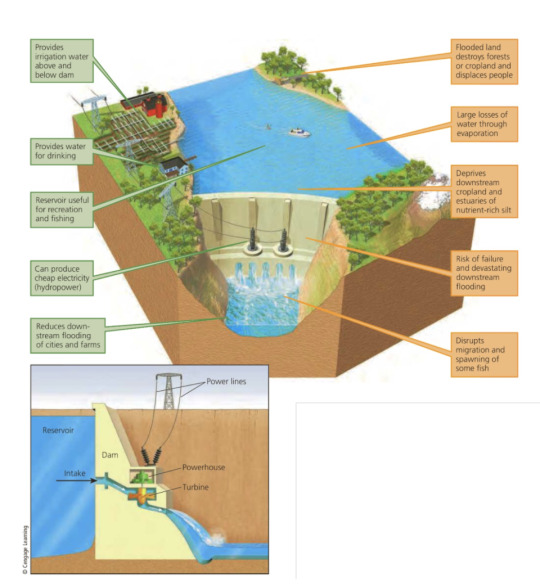
Figure 4. Trade-Offs of Large dam and reservoir systems (Miller and Spoolman 2016, 336).
While we can convert ocean water into freshwater, the energy and other costs are high and the process results in a salty brine that is almost impossible to dispose of.
#CanWaterTransfersExpandWaterSupplies?
In California, specifically, water transfer and irrigation is common for much of the dry state. This system supports half of the United States’ fruits and vegetables. However, these systems usually involve great water losses through evaporation and leaks. They also degrade ecosystems in areas from where the water is taken from. Federal and state governments usually subsidize water transfers and this promotes the inefficient and unsustainable use of large amounts of water to irrigate crops in desert-like areas.
If we are going to use these systems, we must enhance their efficiency in order to increase the water supply, especially in the wake of climate change, which will only make matters worse.
#HowCanWeUseFreshwaterMoreSustainably?
“We can use freshwater more sustainably by cutting water waste, raising water prices, slowing population growth, and protecting aquifers, forests and other ecosystems that store freshwater” (Miller and Spoolman 2016, 342). We should cut water waste through the implementation of full cost pricing; placing a higher value on water would make it less likely to be wasted.
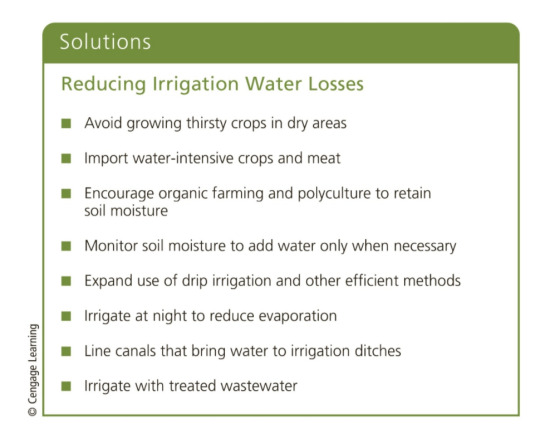
Figure 5. Ways To Reduce Freshwater Losses in Irrigation (Miller and Spoolman 2016, 345).
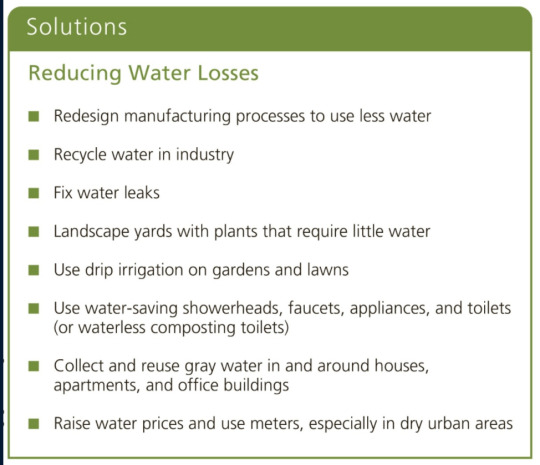
Figure 6. Ways to Reduce Freshwater Losses in Industries, Homes, and Businesses (Miller and Spoolman 2016, 347).
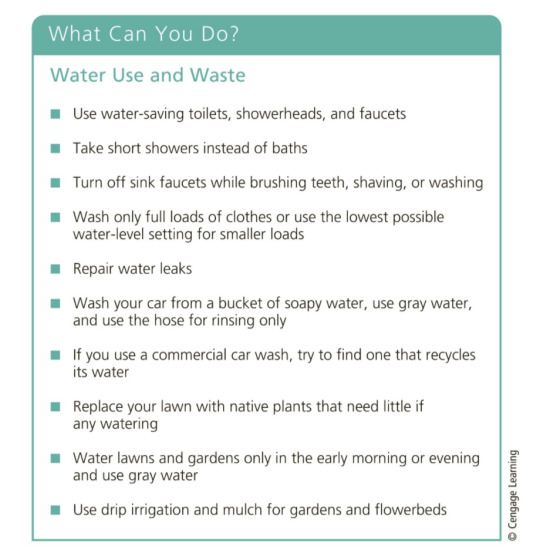
Figure 7. What We Can Do to Reduce Freshwater Use and Waste (Miller and Spoolman 2016, 348).
#HowCanWeReduceTheThreatOfFlooding?
We can reduce the threat of flooding by protecting more wetlands and natural vegetation in watersheds, and by avoiding building in vulnerable areas. Human activities contribute to flooding in many ways. We settle on floodplains to take advantage of their fertile soil, ample freshwater, and availability of nearby rivers for recreation and transportation. We have also attempted to narrow rivers and surround them with dikes, dams and levees which have left the bodies of water overwhelmed by heavy snowmelt and prolonged rain. While flooding is a threat to people, it actually provides many benefits to ecosystems. We can reduce flood risks to humans by channelizing streams to reduce upstream flooding, but this does eliminate aquatic habitats, reduces groundwater recharge and can lead to downstream flooding. Levees and flood walls can speed up a stream flow which can lead to flooding as well and does not protect against powerful floodwaters. Damming, which is most common, can also reduce the human threat of flooding, but has a number of drawbacks as well.
The most ecological approach is to preserve existing wetlands and restore degraded wetlands that lie in floodplains in order to take advantage of their natural services. We also should reduce our greenhouse gas emissions as they will cause sea levels to rise and flood coastal areas.
#WhatAreTheCausesAndEffectsOfWaterPollution?
The main cause of water pollution is human activity, specifically agricultural activities, industrial facilities, mining and untreated wastewater. Water pollution comes from both point and nonpoint sources. Point sources expel pollutants into bodies of surface water at specific locations, like drain pipes, ditches or sewer lines that are usually easy to identify, monitor and regulate. Nonpoint sources are broad and affect areas where rainfall or snowmelt washes pollutants off of the land into bodies of surface water. Another form of water pollution occurs when people discard plastics, which often ends up in bodies of water and can harm aquatic wildlife.
Water pollution can cause illness and even death in humans and other species, and also disrupts ecosystems.

Figure 8. Major Water Pollutants and Their Sources (Miller and Spoolman 2016, 545).
#WhatAreTheMajorPollutionProblemsInStreamsAndLakes?
The major pollution problems in streams and lakes include an overabundance of pollution itself, as many streams and rivers can naturally cleanse themselves of biodegradable wastes if we do not overload them or reduce their ability to flow. In more developed countries, some toxic, non-biodegradable inorganic and organic chemicals are added to these bodies of water by industries or mining operations (humans). In less developed countries, stream pollution occurs from sewage, industrial waste and trash (also humans). This can make the water too toxic to even touch.
Lakes and reservoirs are less effective at diluting pollutants than streams because they often contain stratified layers, rarely undergo vertical mixing and have low flow rates or no flow at all. Adding nutrients into lakes from human activity can disrupt their natural cycles. Many toxic chemicals and acids can enter lakes and reservoirs from the atmosphere causing eutrophication, that is, too many nutrients.
Prevention of pollution is the most effective method to solving the problem and is much less costly than cleanup.
#WhatAreTheMajorGroundwaterPollutionProblems?
The major groundwater pollution problem is the leakage of chemicals from agriculture, industry, transportation and homes which make it undrinkable. Groundwater pollution is considered a hidden problem because we cannot see it. Common pollutants such as fertilizers, pesticides, gasoline and organic solvents can leach into groundwater from various sources. Fracking is also a human activity which pollutes groundwater.
We are able to purify groundwater but prevention is a much less expensive and a much more effective solution. It can take anywhere from ten to thousands of years for contaminated groundwater to cleanse itself, and on a human scale, non-biodegradable wastes remain in the water permanently.
Bottled water is seen as an alternative to polluted groundwater sources. However, the United States is thought to have some of the world’s cleanest municipal drinking water systems. Yet, about half of all Americans are worried about getting sick from tap water contamination and so they choose bottled water. In the movie Tapped, Nestle was demonized as one of the many corporations who have claimed the rights to water in certain areas. In Maine, Nestle took advantage of an antiquated Absolute Dominion Law which states whoever had the biggest pump had ownership of the water. Well, Nestle has the biggest pump, and is taking advantage of local communities and harming their natural environment by over pumping groundwater. This is considered a microcosm for what is happening all around the world. The bottled water industry markets their products as “pure” and “safe,” which implies that tap water is somehow impure or unsafe, when in reality that is the case for much of bottled water. The plastics from the bottles can contain hormone disrupting chemicals such as BPA which can be harmful to human health. This is able to happen because the water bottle industry is highly unregulated by the FDA.
It is suggested that more people use their tap water system and push for government regulation and improvement of those systems to avoid the harmful effects that plastic can have on humans and the environment (Soechtig & Lindsey, 2009).
Health scientists cite three specific ways to strengthen the U.S. Safe Water Drinking Act (Miller and Spoolman 2016, 556):
Combine the drinking water systems that serve fewer than 3,300 people with larger systems to make it easier to meet federal standards.
Strengthen and enforce the requirements concerning public notification of violations of drinking water standards.
Ban the use of toxic lead in new plumbing pipes, faucets and fixtures and remove existing lead pipes.

Figure 9. PET plastic bottle. Personal Photo.
#WhatAreTheMajorOceanPollutionProblems?
The major ocean pollution problems include anthropogenic wastes such as oil, toxic chemicals and solid wastes which threaten aquatic organisms and ecosystems. Though the ocean is a vital resource to our survival, we treat it as the world’s largest landfill. Coastal areas receive the largest inputs of waste and pollutants, since 40% of the world's populations live in these areas. Furthermore, 80% of marine pollution originates on land. Most of the municipal sewage from coastal areas in less developed nations is dumped into the oceans untreated, which overwhelms the ability of coastal waters to degrade the waste. Additionally, cruise ships create a lot of pollution in oceans by dumping their wastes at sea and running on fossil fuels.
So much trash is dumped or blown into the ocean that they have begun to form in patches, or gyres. The garbage in these gyres eventually degrade into microplastics which can contain hazardous chemicals that easily leach into aquatic organisms and even eventually humans.
Chris Jordan describes these gyres as “a remote cluster of islands more than 2000 miles from the nearest continent, the detritus of our mass consumption surfaces in an astonishing place: inside the stomachs of thousands of dead baby albatrosses. The nesting chicks are fed lethal quantities of plastic by their parents, who mistake the floating trash for food as they forage over the vast polluted Pacific Ocean.”
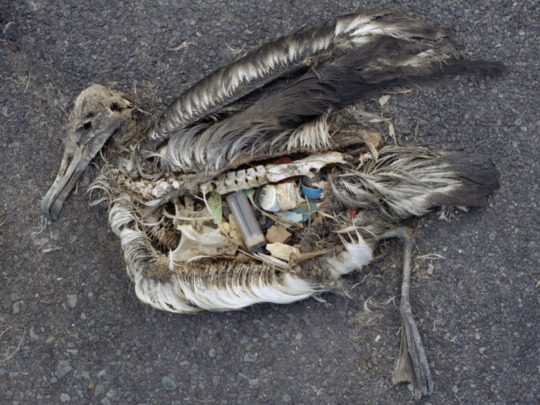
Figure 10. Midway: Message from the Gyre. (Jordan 2009)
Oil also presents a huge pollution problem; it reaches the ocean from natural and human activity. Oil kills many aquatic organisms and marine mammals. If the oil sinks to the ocean floor it can smother bottom dwelling organisms such as crabs and oysters, which makes them unfit for human consumption. Oil has also killed coral reefs.
The key to protecting oceans is to reduce pollution from the land, air and streams emptying into oceans.
#HowCanWeDealWithWaterPollution?
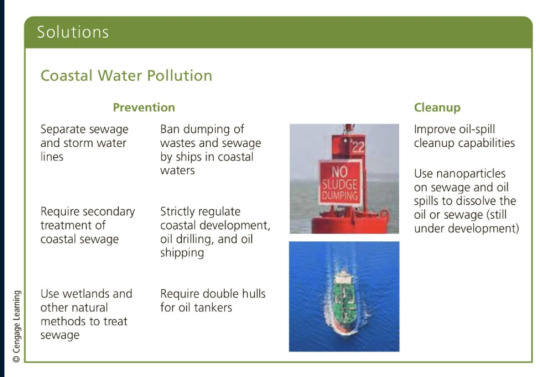
Figure 11. Methods for Dealing with Water Pollution (Miller and Spoolman 2016, 562).

Figure 12. Ways to Prevent or Reduce Water Pollution (Miller and Spoolman 2016, 568).
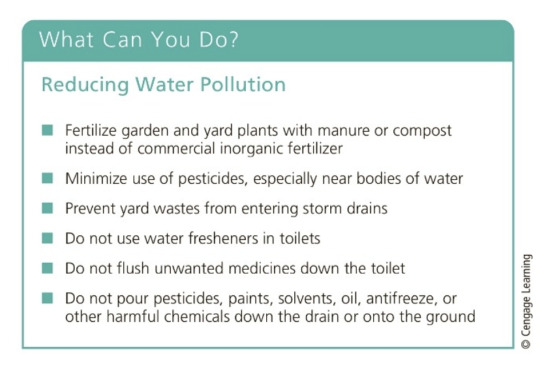
Figure 13. You Can Help Reduce Water Pollution (Miller and Spoolman 2016, 568).
My personal water footprint is 742 m³ per year. However, I’m not sure that’s really accurate because I don’t have a real yearly income as a college student. I have worked mostly short-term, part-time jobs. It was also a bit confusing because the calculator asked for the weight in kg, and so I just estimated, but it may not even be truly accurate. It seems that most of my footprint comes from food, which I was surprised by because I eat a plant-based diet. But I know agriculture is a huge part of water waste, as mentioned in the chapter.
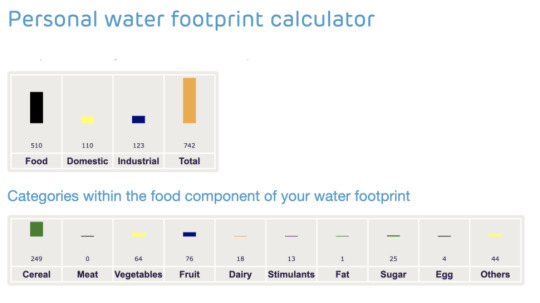
Figure 15. My Water Footprint.
Words; 2,175 Words
Question: What is the most immediate solution and how do we make it happen?
References
Jordan, Chris. "Midway: Message from the Gyre.” 2009. Midway: Message from the Gyre. Online Collection.
http://www.chrisjordan.com/gallery/midway/#CF000313%2018x24
Larigakis, John. “Plastic Wave.” 2019 .Online Collection. http://www.larigakis.com/illustration#/plasticwave/
Miller, G. Tyler, and Scott E. Spoolman. 2016. Living in the Environment: Nineteenth Edition, 323-568. Canada: Cengage Learning.
Soechtig, S. & Lindsey, J. (2009). Tapped. United States: Gravitas Adventures.
Water Footprint Network. “Personal Water Footprint Calculator.” Accessed April 19, 2020. https://waterfootprint.org/en/resources/interactive-tools/personal-water-footprint-calculator/
0 notes
Text
Assignment 12 First Draft: I’m Scared And You Should Be Too
The chapter starts with a quote by Justin Trudeau, the Canadian Prime Minister, who said “No country would find 173 billion barrels of oil in the ground and just leave them there” (Lewis and Maslin 368). I wondered, why not? Why are we so conditioned to just continue to take and take with the assumption that because no human has laid their claim on it, that we have the right to take it? It seems unjust to me that we find ourselves so superior to all other life on earth.
This chapter outlines that there are “three possible futures: continued development of the consumer capitalist mode of living towards greater complexity; a collapse; or a new mode of living” (Lewis and Maslin 2018, 369). I personally hope we choose the third route, since the first one is unsustainable for our lives to continue, and the second implies death of the human race. The third option implies that what we spend our time doing would effectively change, and so would our planetary impacts.
Business as Usual
Historically, human societies have been adaptive to change, and this leads the authors to believe that we will continue with business as usual, relying on innovation and technological advancement to save us from the inconvenience of change. The book cites three major reason why the current mode of living is unlikely to continue:
Positive feedback loops (problems building on more problems) drive the current system and end in fundamental changes.
The energy, information and collective human agency factors that underlie all human societies are changing at exponential rates.
There are core environmental challenges which may cause collapse.
The second reason stands out prominently. The world is more interconnected now than it has ever been, and it is easier for communication to have a farther reach. This suggests that greater numbers of people are able to take collective action than at any other time in history, and collective action often incites change. With more people and more connection, more ideas are produced. However, the ideas being produced currently are those which allow us to continue to live how we want to with no environmental consequence. These are ideas like green energy, which are meant to provide an infinite source of energy for people to continue consuming. Consumption is inherently unsustainable and can cause collapse at high levels. These are the consequences of the exponential growth we are experiencing.
Collapse?
This begs the question, are we doomed for collapse? It seems that the greater power than humans have across the world, the greater the opportunity for such power to be damaging (Lewis and Maslin 2018, 378). As humans gain power, they also gain access to more technology and resources which have the capacity to ruin us. This is seen with our own country relying on “cheap” fuels to power us and keep us “efficient.” I quote these words because obviously coal is not cheap, when the full costs are considered and the efficiency of our country relies on cheap labor that laborers rarely reap the benefits of.
The book suggests that this is not even our biggest threat. “The central, pressing, existential threat to human civilization results from a core contradiction in today’s mode of living: it is powered by energy sources that are undermining the ability of today’s globally integrated network of cultures to persist” (Lewis and Maslin 2018, 378). Fossil fuels are considered a trap for progress because of the obstacles their emissions cause: climate change. “The rate and magnitude of climate change are closely correlated with the cumulative emissions of carbon dioxide” (Lewis and Maslin 2018, 379). But it’s not really the CO2 destroying the planet, it’s us. We emit the CO2 and are addicted to fossil fuels. This addiction must cease to exist in order for us to survive.
A huge problem lies in what our leaders are telling us, which is different everywhere. In some places, there is a huge shift to green energy and lowering of individual and collective footprints. In other places, this is a niche “belief” of some sort. It also is confusing when there is no real physical marker for the change, since our leaders are preaching that we limit our atmospheric warming from 1.5ºC to 2ºC. It’s hard to track something we are avoiding, I think. It would be much better for leaders to try and lower the current warming, rather than stick to the status quo. Especially because these proposed metrics are too high in some areas of the world for survival.
But as the chapter shows, event the current proposals are quite hard to reach, and will require “halving global greenhouse gas emissions in every decade going forward, doubling the share of renewables in the energy system every five years, ending deforestation, and reconfiguring agriculture and our diets (so we eat less beef and more plants)” (Lewis and Maslin 2018, 382).
Though we need to ban the use of fossil fuels everywhere, the only part I disagree with here is relying too heavily on green energy, because the configuration and support systems of the current green energy models still rely heavily on fossil fuels. Countries also don’t necessarily want to make the switch to clean energy because it costs more and does the same, if not a worse, job at providing livelihood. Fossil fuels have been long subsidized and these subsidies are hard to lift due to nationalization, that is, the state-owned oil companies make money for the governments that own them. Additionally, this plan overall is highly ambitious and requires all societies “to place the eradication of greenhouse gas emissions at the same level of importance as the pursuit of economic growth” (Lewis and Maslin 2018, 382). I wonder if this is truly possible is our ever growing capitalist society.
It is clear that the mode of living must change to avoid climate change and collapse. Otherwise, human societies will be unable to manage the consequences, and we will die. These consequences include, but are not limited to, food shortage (which will occur as a result of unpredictable climate ruining crops and our GMOs and pesticides have ruined the soil in irreversible ways), unlivable habitats (due to flooding as a result of sea level rise and unbearable heat), and of course civil unrest. The pentagon sees climate change as a threat multiplier, which means that the problems that already exist in our world will be exacerbated on unprecedented levels.
Equality is Necessary
I have long been weary of the communist socialist arguments toward climate change, thinking that agendas are being pushed that are unfavorable. However, I have come to realize that I have been privileged and conditioned to believe that capitalism is good because it has served me. I have been conditioned to believe that more is better.
Capitalism serves this message on a silver platter and has corrupted the human value system. In order to create a new mode of living, equality must exist in a variety of ways. Policies must limit climate change to avoid human suffering; we must focus on the human experience of all people, everywhere, and give value to their lives as well as our own. Everyone should also have access to information and education which will provide a more diverse global community to engage in collective action. Everyone in the global community should have access to healthy food; this should be a basic human right that is focused on more intently because food production currently is unbalanced and results in too much waste.
The unequal balance of economic power has historically favored the progress of the West and worsened the development of the global East. However, both East and West must work together to solve the climate crisis. The West has a larger debt to pay in this task because our emissions make up almost 100% of the emissions in the atmosphere. This was an interesting point since the textbook has repeatedly blamed poverty for rising temperatures. However, the West is hesitant to accept this reality, which presents a great challenge. The West is seemingly dependent on the East for resources, and they have become dependent on us for labor. This codependent relationship, as with any codependent relationship, is toxic and does not benefit either in the long-run. One way to reduce this dependency is with Universal Basic Income (UBI), which supports subsistence needs and covers healthcare. There would be no obligation to work, which would create an increase in autonomy and education. Equality is always a future aspiration, but it really shouldn’t be. We (the west) consume on irrational levels, so much that if global consumption was equal to that of the West, we would essentially be feeding the demand for 32 Billion people; this is impossible.
It doesn’t help that the most comprehensive international document to date, the Paris Climate Agreement, has no clear penalties for countries who do not perform their pledged actions. This is so commonly a reason why nothing ever changes; there are no consequences for the status quo! If the Paris agreement is truly implemented, the world will be transformed in ways that very few people understand or desire. Fossil fuel emissions won’t really be cut to zero, but rather managed in ways that aren’t truly sustainable and put a sort of band aid over the real issues.
The Stories We Tell Ourselves
The current story around climate action is that cutting fossil fuel emissions to zero is all good. However, the proposed methods of doing so are actually quite harmful to biodiversity and only exist to serve human nature. It is a convenient story which allows us to phase out of harmful choices, placing a large amount of ownness on the individual, rather than directly correlating the damage to fossil fuel industries. Using economic solutions to paint a picture of the future is ineffective because people exist in the physical state and numbers exist in the hypothetical. Policy-makers are relying on the economic story that is constantly told, that we have to phase into a greener world, and that story is destructive to progress. It doesn’t accurately highlight the severity of the issues.
Something I also did not agree with in this chapter is the part about the materials revolution. While I think this type of revolution is definitely necessary, it still supports the culture of consumption, especially a centered reliance on recycling. Recycling is the least productive of the 4 R’s and requires a large amount of energy, which is exactly what we are trying to avoid. Rather than focusing on the elimination of waste or the recycling of waste, I think we should be focusing on the elimination of production of wasteful products. If we create products that people can reuse over and over again, then recycling ceases to be necessary. The story of recycling is damaging and continues to perpetuate environmental issues.
Another story we tend to tell ourselves is that of “deserving.” We say, “I’ve been active all week, I deserve an ice cream cone,” or “I have been studying all day, I deserve to watch a movie,” and especially “I have worked so hard, I deserve a vacation.” UBI, as mentioned above, breaks the link between work and consumption, which in turn lessens environmental impact. It does this by giving money with no expectation of anything in return, and by allowing people a stronger sense of free will. UBI is a controversial idea, but it really shouldn’t be. It has been shown that entrepreneurship, future planning, and environmental benefit increases with UBI; that doesn’t sound so bad.
We also have distanced ourselves from our food, in a way which causes us not to value it. Products are cheap, so they exist in surplus, but the environmental cost is high. Placing cheapness at the center of our perspective on food is damaging because we waste it since we don’t see a high value in it. Yet another story we tell ourselves: food doesn’t matter, and we will always have it. How can that be true when the population is growing and we cannot survive without food? This is just one example of the values that must be transformed in order to create real radical change.
The planet can and will survive without us, but we cannot survive without it. I would like to believe we are experiencing some sort of transformation right now, while we are all stuck in our homes watching the world go on without us. We see pictures of massively lowered levels of pollution, and I hope we are acknowledging our destructive power. This is the first step, which hopefully can move us to transition to greener modes of life and economies. We need to rely less on innovation, and more on going back to basics and looking to nature to help.
Words: 2130
Question: Is it effective to be optimistic about the future of the human population? Can optimism create change?
References:
Lewis, S. and Mark Maslin. 2018. The Human Planet: How We Created The Anthropcoene. Connecticut: Yale University Press.
0 notes
Text
Assignment 10 Final Draft: Are We Willing to be Inconvenienced For Sustainability?

According to physicist Albert Einstein, ‘A clever person solves a problem; a wise person avoids it’” (Miller and Spoolman 2016, 596). This is a perfect analysis of a zero waste lifestyle; zero wasters avoid making trash as a whole rather than looking for solutions of where to put it.
In my opinion, chapter 17 was a weird chapter because it focused highly on the effects of hazards on humans, and not the environment. It didn’t feel like it belonged in this text. Both chapters cited very controversial examples of responsible waste management/recycling, in my opinion. But, I digress. Here’s what I got out of it.
#WhatMajorHealthHazardsDoWeFace?
We face major health hazards from biological, chemical, natural and cultural factors along with our lifestyle choices. Biological hazards include bacteria, viruses, parasites, protozoa and fungi. Chemical hazards include harmful chemicals in air, water, soil and human-made products. Natural hazards include fire, earthquakes, volcanic eruptions, floods, tornadoes and hurricanes. Cultural hazards include unsafe working conditions, criminal assault and poverty. Lifestyle choice hazards include smoking, poor food choices and unsafe sex. The hazard of Coronavirus which we are facing right now is a biological hazard.
#HowDoBiologicalHazardsThreatenHumanHealth?
Biological hazards can be highly contagious, passing from one person to another, but they don’t have to be. The book talks about how the risks of these hazards, like infectious diseases are declining, but still remain relevant in less developed countries. That’s a bit ironic right now because of Coronavirus. The book also mentions how climate change amplifies the effects of these hazards due to their tendency to breed rapidly in warmer climates. This is a bit terrifying with summer approaching. Another major issue threatening humans is that some of the bacteria which causes infectious diseases have become immune to antibiotics, which makes them more difficult to treat and easier to spread. The spread is also made easier by population growth, which forces higher person-to-person interaction as cities become more dense.
Some believe the Coronavirus originated from bats in a Chinese province. If that is true, it wouldn’t be the first time a disease spread from one animal to another (us). There is a whole field of medicine called Ecological Medicine which studies this connection. Their findings have shown that it is increasingly important to regulate the consumption and trade of exotic animals to prevent the spread of infectious disease. However, in reality, I can see how this can be quite difficult and can come off as colonialistic, in imposing western culture on different cultural norms than our own.

Figure 1. Solutions to Infectious Diseases (Miller and Spoolman 2016, 452.)
#HowDoChemicalHazardsThreatenHumanHealth?
Some chemicals in the environment can cause cancers and birth defects, and disrupt the human immune, nervous and endocrine systems. Toxic chemicals can cause temporary or permanent damage or even death to humans. The EPA has found that almost ½ of the fish tested in 500 US lakes and reservoirs had above safe levels of mercury (Miller and Spoolman 2016, 453). Mercury is a toxic metal naturally released into the air. However, ⅔ of the mercury existing in our atmosphere comes unnaturally from human activity: coal, industrial plants, cement kilns, smelters and solid-waste incinerators. Since Mercury is an element, it cannot be broken down, and it builds up in whatever area it comes to pollute. Humans are exposed to mercury through the food we eat or the air we breathe. This exposure to mercury can cause reduced IQs and nervous system damage.
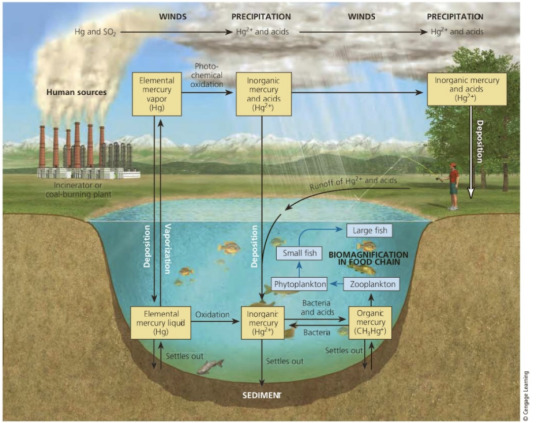
Figure 2. Movement of Different Forms of Mercury Through the Environment (Miller and Spoolman 2016, 454).
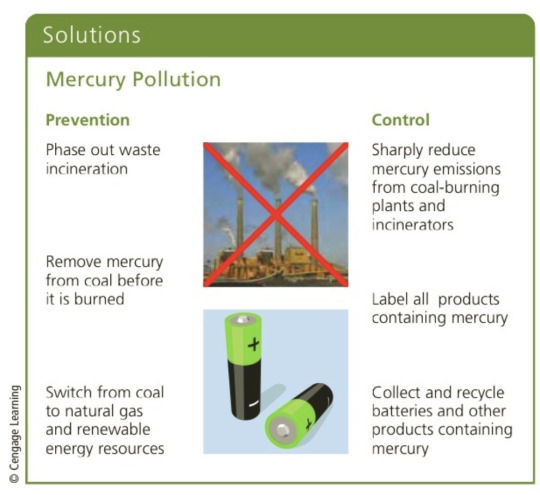
Figure 3. How to Prevent/Control Mercury Inputs (Miller and Spoolman 2016, 454).
Certain chemicals can affect the endocrine system because they have structures which mimic natural hormones. This can allow them to disrupt sexual development and reproduction. Some of these chemicals, or hormone disruptors, include the ones which are used to make plastics more flexible. Specifically, BPA has been a controversial material used in plastics, because research has shown that low levels of BPA can cause brain damage, early puberty, decreased sperm count, cancer, heart disease, type 2 diabetes, liver damage, impaired immune function, impotence and obesity. Consumers have the power to choose BPA free products, but some manufacturers have just replaced the chemical with a similar synthetic, which defeats the purpose.
The book suggests that a simple way to help ourselves is to just switch to cleaner products. However, the book fails to recognize this is not accessible for many people in the US, because “clean” products tend to be more expensive.

Figure 4. Ways to Limit Exposure to Hormone Disruptors (Miller and Spoolman 2016, 455).
#HowCanWeEvaluateRisksFromChemicalHazards?
Scientists use animal testings, case reports, and epidemiological studies to estimate the toxicity of chemicals. They evaluate dosage, solubility, persistence, and biological magnification, to name a few factors. There are many ethical factors which go into animal testing, and since more humane options exist, consumers have the option to buy products that do not test on animals.
“‘Toxicologists know a great deal about a few chemicals, a little about many, and next to nothing about most’” (Miller and Spoolman 2016, 459). Though toxicologists are working hard to evaluate these risks, they overall recommend pollution prevention to reduce our exposure to harmful chemicals. Living in a developed country, we have all likely been exposed to potentially harmful chemicals, but we should avoid it whenever possible.
The book specifically cites 3M and Dupont as business leaders in chemical recycling, which is laughable. Both Dupont and 3M have been involved in environmental scandals of their own, ruined communities, and then tried to deny it when the time came to own up. I can’t fathom why the book would cite these two as examples of responsible businesses following the precautionary principle.
In order to follow the precautionary principle we (businesses, government, individuals) must:
assume new chemicals and technologies could be harmful unless proven otherwise
remove the existing chemicals and technologies that have been assumed safe thus far from the market until proven so
The European Union has already begun to apply the precautionary principle through pollution prevention by phasing out the dirty dozen.
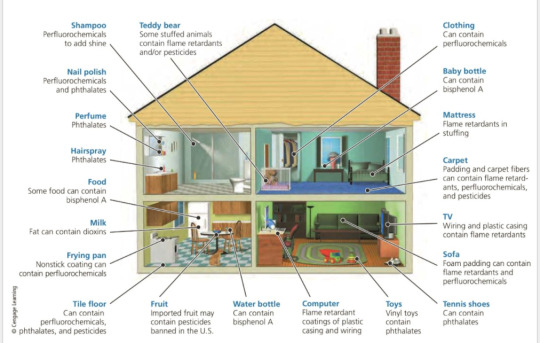
Figure 5. Potentially Harmful Chemicals Found in the Home (Miller and Spoolman 2016, 460).
#HowDoWePercieveAndAvoidRisks?
We can avoid risks by becoming informed, thinking critically and making conscious choices. The best ways to avoid individual health risks are to avoid smoking, lose excess weight, reduce consumption of sugary foods, eat a variety of fruits and vegetables, exercise regularly, drink little to no alcohol, avoid excessive sunlight and practice safe sex. Technological risks can be difficult to estimate due to their complexity. But we can do so by calculating their probability of success (Reliability=Tech Reliability x Human Reliability).
Designer William Mcdonough came up with the cradle-to-cradle approach to the life-cycle of products; “we should think of products as part of a continuing cycle instead of becoming solid wastes that end up as litter or being burned or deposited in landfills” (Miller and Spoolman 2016, 574). This is a form of biomimicry, a cycle which replicates the cycle of nature. This way of thinking has also been called closed-loop, and needs to be implemented at the design stage of a product, planning out every step of consumption.
It is important to note that some people are unable to avoid risks. The poor and unimmunized are particularly susceptible to disease. There's a privilege to being able to avoid contact, as in many areas people live with many members of their family in tight quarters and are unable to avoid contact with germs. This fact outlines how for some communities, even if you know the risks, you might still just have to live with them. The cycle of poverty is also worsened during a pandemic due to lower level client facing jobs increasing the susceptibility to disease. The poor are also less likely to receive medical assistance and less likely to have health insurance. The intersection of vulnerabilities is an important factor to consider when avoiding risk. The basic rule of thumb is, the more vulnerable you are before a disaster, you are exponentially more after the fact.
#WhatEnvironmentalProblemsAreRelatedToSolidAndHazardousWastes?
Solid waste contributes to pollution and contains valuable resources that could be reused or recycled. Municipal solid waste (MSW) is what we throw out in our lives everyday–huge amounts of trash. We also produce industrial waste through agriculture, mining and industry. Without humans, this problem of this type of waste wouldn’t exist, because the natural wastes of one organism become nutrients or raw materials for another. We will always produce some waste, due to the law of conservation of matter, but cradle-to-cradle design could help reduce our waste and environmental harm by 80%. The United States produces the most waste in the world, “enough MSW to fill a bumper-to-bumper convoy of garbage trucks long enough to circle the earth’s equator almost six times” (Miller and Spoolman 2016, 576).
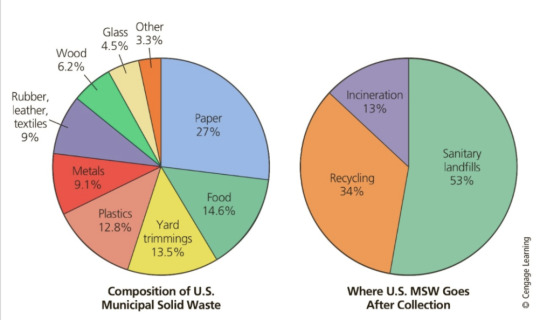
Figure 6. Composition of MSW in the US and Where It Goes After Collection (Miller and Spoolman 2016, 576).
Many people have the misconception that landfills operate as huge compost piles where biodegradable waste will eventually break down in a short time. But in reality, decomposition takes a long time in a landfill due to lack of sunlight, water, and air.
Hazardous waste contributes to pollution, natural capital degradation, health problems and premature deaths. This type of waste is corrosive, toxic, flammable, can be explosive and cause disease. The two major types of hazardous wastes are organic compounds and toxic heavy metals. E-waste is a large source of this type of waste. Much of e-waste is shipped to foreign countries where the labor is cheap and environmental regulations are lax. “More developed countries produce 80-90% of the world’s hazardous wastes, and the United States is the largest producer” (Miller and Spoolman 2016, 577). This means as human societies progress, we degrade the environment that allowed us to do so.
#HowShouldWeDealWithSolidWaste?
We should deal with solid waste by reducing our production of it, reusing or recycling it and safely disposing of it. Waste management is imperative to dealing with solid waste, but prevention and reduction are more effective. Integrated waste management combines all of these approaches, and is the most realistic.
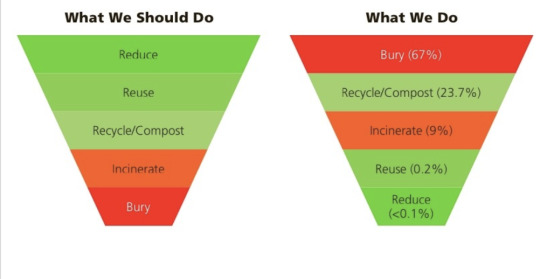
Figure 7. Priorities Recommended by the US National Academy of Sciences for Dealing with MSW compared with The Reality (Miller and Spoolman 2016, 579).
The 4 R’s by priority are
Refuse: Don’t use it.
Reduce: Use less of it.
Reuse: use it over and over.
Recycle: Upcycle, compost, and follow local recycling rules.
The question becomes, is it the responsibility of individuals to take these actions, or the responsibility of the system to change and make it really easy for individuals to do so? I think a combination of both. Producers of trash tend to focus on source separation as the most cost effective form of recycling. However, this puts a lot of owness on the consumer to be knowledgable on their local recycling practices.
6 Strategies that industries and communities can use to reduce resource use, waste and pollution:
Change industrial processes to eliminate or reduce harmful chemical use.
Redesign manufacturing processes and products to use less material and energy.
Develop products that are easy to repair, reuse, remanufacture, compost or recycle.
Establish cradle-to cradle responsibility laws.
Eliminate and/or reduce unnecessary packaging.
Use fee-per-bag solid waste collection systems.
#WhyAreWeRefusingReducingReusingAndRecyclingSoImportant?
We refuse, reduce, reuse and recycle what we use to decrease our consumption of matter and energy resources, reduce pollution and natural capital degradation and save money.
Questions to ask yourself to avoid a throwaway economy:
Do I really need this? (refuse)
How many of these do I actually need? (reduce)
Is this something I can use more than once? (reuse)
Can this be converted into the same or a different product when I am done with it? (recycle)

Figure 8. Some Ways to Reuse (Miller and Spoolman 2016, 582).
Businesses are also forming out of people’s desire to avoid waste, such as rental clothing, furniture and child’s toys. Additionally recycling businesses are arising to give people points for recycling, or to recycle non recyclable products. Terracycle is a company that partners with brands to recycle their packaging in order to divert it from a landfill (Terracycle 2020).
Recycling is a complex and expensive process, so it is not the most sustainable form of waste diversion. Additionally, incorrect sorting for recycling is ineffective.
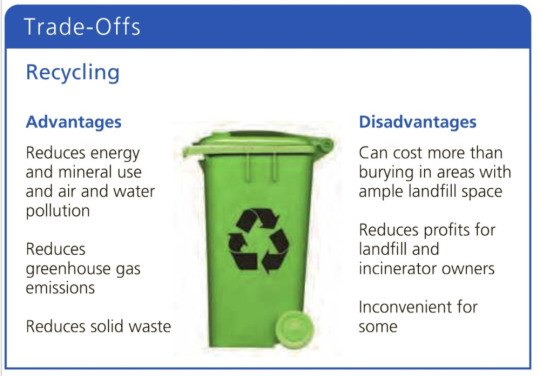
Figure 9. Advantages and Disadvantages of Recycling (Miller and Spoolman 2016, 585).
#WhatAreTheAdvantagesAndDisadvantagesOfBurningOrBuryingSolidWaste?

Figure 10. Trade-Offs of Burning Solid Waste (Miller and Spoolman 2016, 587).
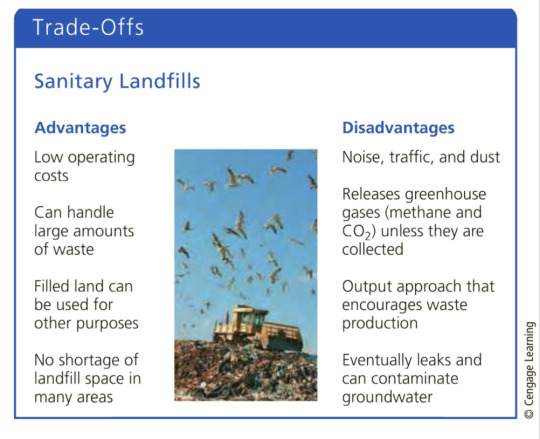
Figure 11. Trade-Offs of Landfills (Miller and Spoolman 2016, 588).
#HowShouldWeDealWithHazardousWaste?
We should deal with hazardous waste by producing less of it, reusing or recycling it, converting it to less hazardous materials, and safely storing it. Most countries follow these priorities poorly. The long-term solution is prevention, but short term the other options will suffice. Hazardous waste can be detoxified physically, chemically or biologically. Additionally plasma gasification can be used to treat the waste, but it is quite expensive. Burial of hazardous waste is the most common form of storage in the United States and abroad due to low cost. But the environmental costs of leakage into groundwater are high. The current regulation for this type of storage is inadequate. Actually, 95% of the hazardous and toxic wastes produced in the United States are unregulated, and even less are regulated in less developed countries. The consequences of this is that about $1.7 trillion is spent on the cleanup of toxic waste, not including legal fees. And we pay for it through our taxes!
#HowCanASocietyShiftToALowWasteEconomy?
“Shifting to a low waste economy will require individuals and businesses to reduce resource use and to reuse and recycle most solid and hazardous wastes at local, national and global levels” (Miller and Spoolman 2016, 594). Bottom-up campaigns are essential in the process including sit-ins, concerts, protests, rallies, and petitions. Manufacturers of waste feel that it needs to be managed, while citizens feel that waste needs to be reduced; it is a constant struggle.
3 Factors hinder reuse and recycling
The market prices of products are not applying full-cost pricing.
The economic playing field is uneven because resource extraction usually receives more subsidies than reuse and recycling industries.
The demand and the price paid for recycled goods fluctuates since it isn’t a high priority for consumers.
We can reverse these factors by attaching deposit fees or fee-per bag charges and governments can pass laws requiring companies to take back, recycle and/or reuse packaging and e-waste. Overall, a change in mindset must be adopted to the way in which we consume in the following ways.
We must understand:
Everything is connected.
There is no “throw away” for our wastes.
Producers and polluters should pay for their produced wastes.
We can mimic nature by reusing, recycling, composting or exchanging MSW.
(Miller and Spoolman 2016, 596).
Additionally, I watched No Impact Man for this post, where Colin Beavin asks, what if we tried not to hurt the environment? And what are we willing to give up to do so? He spent a year living zero waste, only buying food within a 250 mile radius, and only traveling by foot and bike. He shopped at local farmers markets, turned off his electricity, homemade cleaning products and in the end adopted a different mindset towards life. Beavin began to understand the disconnection between humans and nature through consumption. Personally, I have been pursuing zero waste for 3 years, and even I thought the guy was a bit extreme. His critics felt the same way. In the film, Beavin noted how some environmentalists had reached out to him saying he was giving the rest of us a bad rep. But I think it’s important for people to understand the validity of the experiment, and how little thought goes into most peoples’ everyday impact. This strikes a nerve in American culture because we are a society built on American corporate capitalism. Through No Impact Man, Beavin also balanced the question of individual versus collective action. Some other critics said if we could do it without government and business aid, then what’s the problem? I think the problem is that living how Colin lived is seen as extreme and unrealistic for most people due to the inconveniences it causes. Individual action requires people to be engaged, and creates the demand for the world to look differently.

Figure 12. Zero Waste. Personal Photo.
Word Count: 3000 Words
Question: How can zero-waste lifestyles be more attractive and accessible?
Works Cited
Miller, G. Tyler, and Scott E. Spoolman. 2016. Living in the Environment: Nineteenth Edition, 441-596. Canada: Cengage Learning.
Wurmfeld, E. (Producer), & Gabbert, L. (Director). (2009). No Impact Man [Motion Picture]. Toronto, ON : Mongrel Media.
Terracyle. 2020. “About Terracycle.” Accessed April 6, 2020. https://www.terracycle.com/en-US/about-terracycle?utm_campaign=admittance&utm_medium=menu&utm_source=www.terracycle.com
0 notes
Text
Assignment 11 First Draft: How Can We Emphasize the Inherent Value of Water?
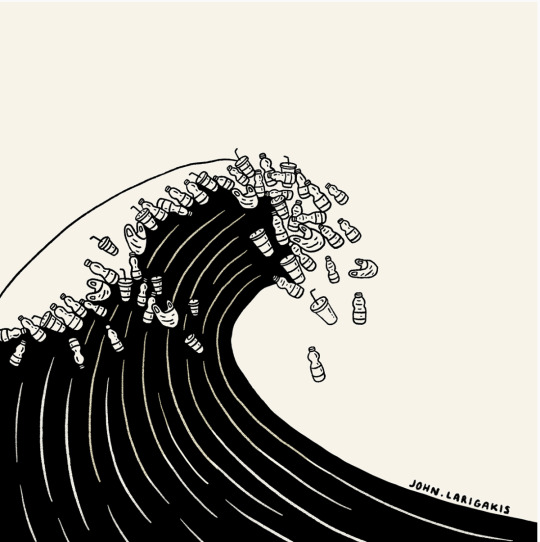
Figure 1. Plastic Wave (Larigakis, 2019).
“No Water, no life” -Sandra Postel (Miller and Spoolman 2016, 323).
#WillWeHaveEnoughUsableWater?
“We are using available freshwater unsustainably by extracting it faster than nature can replace it, and by wasting, polluting and underpricing this irreplaceable natural resource” (Miller and Spoolman 2016, 325). Our planet is mostly water, and so are we; we could not survive without it. Though it is used for virtually every aspect of human life, it is poorly managed and valued too low, making it available at too low of a cost to many consumers. This low price encourages waste and pollution of the resource. Freshwater supplies are unevenly distributed across the globe, leaving 1 out of every ten people without access to clean water. It is considered both a global health issue and an economic issue because while people do not have access to clean drinking water, it also is necessary for supporting livelihood which reduces poverty. Additionally, it is a national and global security issue due to rising tensions between nations over access to shared freshwater resources. Finally, it is of course an environmental issue because the overdraft of freshwater results in falling water tables, shrinking lakes, disappearing wetlands and pollution which degrades water quality and extinction of aquatic organisms and their ecosystem services. Less than 1% of the planet’s water is available as liquid freshwater in underground deposit, but it is continually recycled through the hydrologic cycle. This cycle is disrupted, however, by the pollution and overdraft of freshwater resources. Additionally climate change and atmospheric warming is evaporating some of this water into the atmosphere. This means that wet areas will get wetter and flooding will occur and drier areas will experience intense droughts.
#IsGroundwaterASustainableResource?
Groundwater is the freshwater stories in underground spaces and is a key component of freshwater capital. However, it is not a sustainable resource because it is being pumped from aquifers faster than it can be renewed by precipitation. The freshwater available from groundwater is used for a variety of activities that do not involve direct consumption, which is a waste. Over pumping aquifers for nonessential activity can be harmful to food production, rising food prices, and inequality.

Figure 2. Ways to Prevent or Slow Groundwater Depletion (Miller and Spoolman 2016, 335).
As global shortages of freshwater become increasingly relevant, scientists are looking into tapping deep aquifers of groundwater. There are five major problems associated with this idea:
The deep aquifers are nonrenewable.
Little is known about the consequences of pumping from deep aquifers.
No international treaties govern access between aquifers that flow between more than one country.
The costs of tapping deep aquifers are unknown.
The water may be salty and contaminated.

Figure 3. Trade-offs of Withdrawing Groundwater (Miller and Spoolman 2016, 327).
#HowCanWeIncreaseFreshwaterSupplies?
The dam-and-reservoir systems and water transfer projects have greatly expanded water supplies in some areas, but have degraded ecosystems and displaced communities in others.
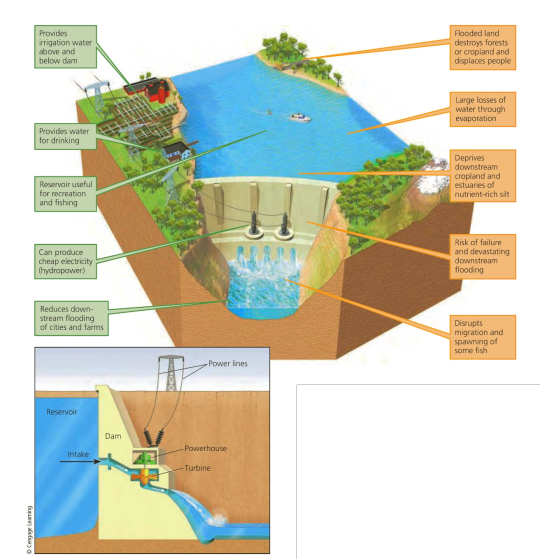
Figure 4. Trade-Offs on Large dam and reservoir systems (Miller and Spoolman 2016, 336).
While we can convert ocean water into freshwater, the energy and other costs are high and results in a salty brine that is almost impossible to dispose of.
#CanWaterTransfersExpandWaterSupplies?
Water transfers have expanded water supplies in some areas, but disrupted others. In California specifically water transfer and irrigation is common for much of the dry state. This system supports half of the United States’ fruits and vegetables. However, these systems usually involve great water losses through evaporation and leaks. They also degrade ecosystems in areas from where the water is taken. Federal and state governments usually subsidize water transfers and this promotes the inefficient and unsustainable use of large amounts of water to irrigate crops in desert-like areas. If we are going to use these systems, we must enhance their efficiency in order to increase the water supply, especially in the wake of climate change which will only make matters worse.
#HowCanWeUseFreshwaterMoreSustainably?
“We can use freshwater more sustainably by cutting water waste, raising water prices, slowing population growth, and protecting aquifers, forests and other ecosystems that store freshwater” (Miller and Spoolman 2016, 342). We should cut water waste through the implementation of full cost pricing, which would place a higher value on water which would leave it less likely to be wasted.

Figure 5. Ways To Reduce Freshwater Losses in Irrigation (Miller and Spoolman 2016, 345).

Figure 6. Ways to Reduce Freshwater Losses in Industries, Homes, and Businesses (Miller and Spoolman 2016, 347).

Figure 7. What We Can Do to Reduce Freshwater Use and Waste (Miller and Spoolman 2016, 348).
#HowCanWeReduceTheThreatOfFlooding?
We can reduce the threat of flooding by protecting more wetlands and natural vegetation in watersheds, and by avoiding building in vulnerable areas. Human activities contribute to flooding in many ways. We settle on floodplains to take advantage of their fertile soil, ample freshwater, and availability of nearby rivers for recreation and transportation. We have also attempted to narrow rivers and surround them with dikes, dams and levees which have left the bodies of waters overwhelmed by heavy snowmelt and prolonged rain. While flooding is a threat to people, it actually provides many benefits to ecosystems. We can reduce flood risks to humans by channelizing streams to reduce upstream, but this does eliminate aquatic habitats, reduces groundwater recharge and can lead to downstream flooding. Levees and flood walls can speed up a stream flow which can lead to flooding as well and do not protect against powerful floodwaters. Damming, which is most common, can also reduce the human threat of flooding, but has a number of drawbacks as well. The most ecological approach is to preserve existing wetlands and restore degraded wetlands that lie in floodplains in order to take advantage of their natural services. We also should reduce our greenhouse gas emissions as they will cause sea levels to rise and flood coastal areas.
#WhatAreTheCausesAndEffectsOfWaterPollution?
The main cause of water pollution is human activity, specifically agricultural activities, industrial facilities, mining and untreated wastewater. Water pollution comes from both point and nonpoint sources. Point sources expel pollutants into bodies of surface water at specific locations, like drain pipes, ditches or sewer lines that are usually easy to identify, monitor and regulate. Nonpoint sources are broad and affect areas where rainfall or snowmelt washes pollutants off of the land into bodies of surface water. Another form of water pollution occurs when people discard plastics, which often ends up in bodies of water and can harm aquatic wildlife.
Water pollution can cause illness and even death in humans and other species, and also disrupts ecosystems.

Figure 8. Major Water Pollutants and Their Sources (Miller and Spoolman 2016, 545).
#WhatAreTheMajorPollutionProblemsInStreamsAndLakes?
The major pollution problems in streams and lakes include an overabundance of pollution itself, as many streams and rivers can cleanse themselves of biodegradable wastes if we do not overload them or reduce their ability to flow. In more developed countries, some toxic, non-biodegradable inorganic and organic chemicals are added to these bodies of water by industries or mining operations (humans). In less developed countries, stream pollution occurs from sewage, industrial waste and trash. This can make the water too toxic to even touch.
Lakes and reservoirs are less effective at diluting pollutants than streams because they often contain stratified layers and rarely undergo vertical mixing and they have low flow rates or no flow at all. Adding nutrients into lakes from human activity can disrupt their ecosystems. Many toxic chemicals and acids can enter lakes and reservoirs from the atmosphere causing eutrophication, that is, too many nutrients. Prevention of pollution is the most effective method to solving the problem and is much less costly than cleanup.
#WhatAreTheMajorGroundwaterPollutionProblems?
The major groundwater pollution problems include the leakage of chemicals from agriculture, industry, transportation and homes which make it undrinkable. Groundwater pollution is considered a hidden problem because we cannot see it. Common pollutants such as fertilizers, pesticides, gasoline and organic solvents can leach into groundwater from various sources. Fracking is also a human activity which pollutes groundwater.
We are able to purify groundwater but prevention is a much less expensive and a much more effective solution. It can take anywhere from ten to thousands of years for contaminated groundwater to cleanse itself, and on a human scale, non-biodegradable wastes remain in the water permanently.
Bottled water is seen as an alternative to polluted groundwater sources. However, the United States is thought to have some of the world’s cleanest municipal drinking water systems. Yet, about ½ of all Americans are worried about getting sick from tap water contaminations and so they choose bottled water. In the movie Tapped, nestle was demonized as one of the many corporations who have claimed the rights to water in certain areas. In Maine, Nestle took advantage of an antiquated absolute dominion law which states whoever had the biggest pump had ownership of the water. Well, Nestle has the biggest pump, and is taking advantage of local communities by harming their natural environment by over pumping groundwater. This is considered a microcosm for what is happening all around the world. The bottled water industry markets their products as “pure” and “safe,” which implies that tap water is somehow impure or unsafe, when in reality that is the case for much of bottled water. The plastics from the bottles can contain hormone disrupting chemicals such as BPA which can be harmful to human health. This is able to happen because the water bottle industry is highly unregulated by the FDA. It is suggested that more people use their tap water system and push for government regulation and improvement of those systems to avoid the harmful effects that plastic can have on humans and the environment from pollution (Soechtig & Lindsey, 2009).
Health scientists cite three specific ways to strengthen the U.S. Safe Water Drinking Act (Miller and Spoolman 2016, 556):
Combine the drinking water systems that server fewer than 3,300 people with larger systems to make it easier to meet federal standards.
Strengthen and enforce the requirements concerning public notification of violations of drinking water standards.
Ban the use of toxic lead in new plumbing pipes, faucets and fixtures and remove existing lead pipes.
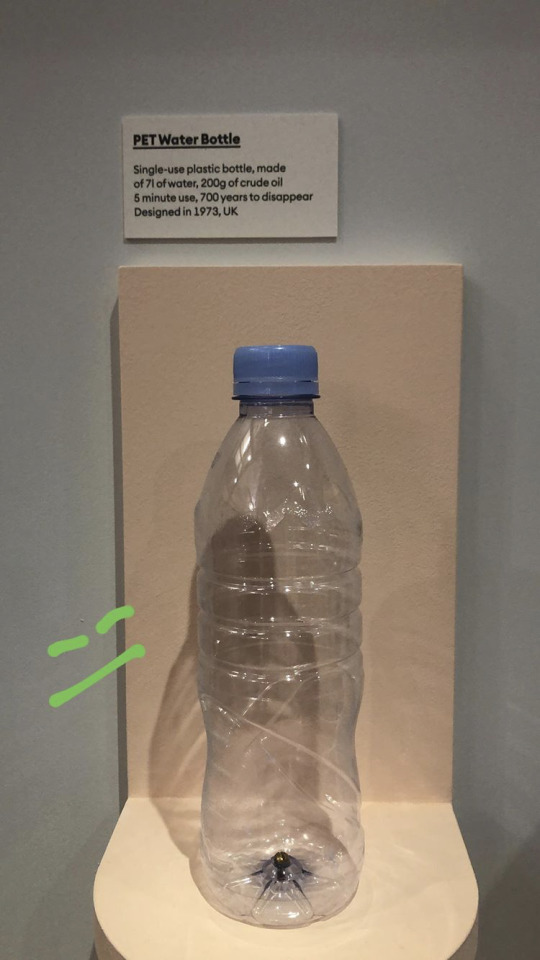
Figure 9. PET plastic bottle. Personal Photo.
#WhatAreTheMajorOceanPollutionProblems?
The major ocean pollution problems include anthropogenic wastes such as oil, toxic chemicals and solid wastes which threaten aquatic organisms and ecosystems. Though the ocean is a vital resource to our survival, we treat it as the world’s largest landfill. Coastal areas receive the largest inputs of waste and pollutants, since 40% of the world's populations live in these areas. Furthermore, 80% of marine pollution originates on land. Most of the municipal sewage from coastal areas in less developed nations is dumped into the oceans untreated, which overwhelms the ability of coastal waters to degrade the waste. Additionally, cruise ships create a lot of pollution in oceans by dumping their wastes at sea and running on fossil fuels.

Figure 10. Residential Areas, Factories, and Farms all Contribute to the Pollution of Coastal Waters. (Miller and Spoolman 2016, 558)
So much trash is dumped or blown into the ocean that they have begun to form in patches, or gyres. The garbage in these gyres eventually degrade into microplastics which can contain hazardous chemicals which easily leach into aquatic organisms and even eventually humans.
Chris Jordan describes these gyres as “a remote cluster of islands more than 2000 miles from the nearest continent, the detritus of our mass consumption surfaces in an astonishing place: inside the stomachs of thousands of dead baby albatrosses. The nesting chicks are fed lethal quantities of plastic by their parents, who mistake the floating trash for food as they forage over the vast polluted Pacific Ocean.”

Figure 11. Midway: Message from the Gyre.
Oil also presents a huge pollution problem; it reaches the ocean from natural and human activity. Oil kills many aquatic organisms and marine mammals. If the oil sinks to the ocean floor it can smother bottom dwelling organisms such as crabs and oysters, which makes them unfit for human consumption. Oil has also killed coral reefs. The key to protecting oceans is to reduce pollution from the land, air and streams emptying into oceans.
#HowCanWeDealWithWaterPollution?

Figure 12. Methods for Dealing with Water Pollution (Miller and Spoolman 2016, 562).

Figure 13. Ways to Prevent or Reduce Water Pollution (Miller and Spoolman 2016, 568).

Figure 14. You Can Help Reduce Water Pollution (Miller and Spoolman 2016, 568).
My personal water footprint is 742 m³ per year. per year. However, I’m not sure that’s really accurate because I don’t have a real yearly income as a college student. I have worked mostly short-term, part-time jobs. It was also a bit confusing because the calculator asked for the weight in kg, and so I just estimated, but it may not even be truly accurate. It seems that most of my footprint comes from food, which I was surprised by because I eat a plant-based diet. But I know agriculture is a huge part of water waste, as mentioned in the chapter.

Figure 15. My Water Footprint.
Words; 2,175 Words
Question: What is the most immediate solution?
References
Jordan, Chris. "Midway: Message from the Gyre.” 2009. Midway: Message from the Gyre. Online Collection.
http://www.chrisjordan.com/gallery/midway/#CF000313%2018x24
Larigakis, John. “Plastic Wave.” 2019 .Online Collection. http://www.larigakis.com/illustration#/plasticwave/
Miller, G. Tyler, and Scott E. Spoolman. 2016. Living in the Environment: Nineteenth Edition, 323-568. Canada: Cengage Learning.
Soechtig, S. & Lindsey, J. (2009). Tapped. United States: Gravitas Adventures.
Water Footprint Network. “Personal Water Footprint Calculator.” Accessed April 19, 2020. https://waterfootprint.org/en/resources/interactive-tools/personal-water-footprint-calculator/
0 notes
Text
Assignment 10 First Draft: Are We Willing to be Inconvenienced For Sustainability?

According to physicist Albert Einstein, ‘A clever person solves a problem; a wise person avoids it’” (Miller and Spoolman 2016, 596).
Chapter 17 was a weird chapter because it focused highly on the effects of hazards on humans, and not the environment. It didn't feel like it belonged in this text. Chapter 21 cited very controversial examples of responsible waste management/recycling, in my opinion.
#WhatMajorHealthHazardsDoWeFace?
We face major health hazards from biological, chemical, natural and cultural factors along with our lifestyle choices. Biological hazards include bacteria, viruses, parasites, protozoa and fungi. Chemical hazards include harmful chemicals in air, water, soil and human-made products. Natural Hazards include fire, earthquakes, volcanic eruptions, floods, tornadoes and hurricanes. Cultural hazards include unsafe working conditions, criminal assault and poverty. Lifestyle choice hazards include smoking, poor food choices and unsafe sex.
#HowDoBiologicalHazardsThreatenHumanHealth?
Biological hazards can be highly contagious, passing from one person to another, but they don’t have to be. The book talks about how the risks of these hazards, like infectious diseases are declining, but still remain relevant in less developed countries. That’s a bit ironic right now because of the global pandemic, Coronavirus. The book also mentions how climate change amplifies the effects of these hazards due to their tendency to breed rapidly in warmer climates. This is a bit terrifying as summer is approaching. Another major issue threatening humans is that some of the bacteria which causes infectious diseases have become immune to antibiotics, which makes them more difficult to treat and easier to spread. The spread is also made easier by population growth, which forces higher person-to-person interaction as cities become more dense.
Some believe the Coronavirus originated from bats in a Chinese province. If that is true, it wouldn’t be the first time a disease spread from one animal to another (us). There is a whole field of medicine called Ecological Medicine which studies this connection. Their findings have shown that it is increasingly important to regulate the consumption and trade of exotic animals to prevent the spread of infectious disease. However, in reality, this can be quite difficult and can come off as colonialistic, in imposing western culture on different cultural norms than our own.

Figure 1. Solutions to Infectious Diseases (Miller and Spoolman 2016, 452.)
#HowDoChemicalHazardsThreatenHumanHealth?
Some chemicals in the environment can cause cancers and birth defects, and disrupt the human immune, nervous and endocrine systems. Toxic chemicals can cause temporary or permanent damage or even death to humans. The EPA has found that almost ½ of the fish tested in 500 US lakes and reservoirs had above safe levels of mercury (Miller and Spoolman 2016, 453). Mercury is a toxic metal naturally released into the air. However, ⅔ of the mercury existing in our atmosphere comes unnaturally from human activity: coal, industrial plants, cement kilns, smelters and solid-waste incinerators. Since Mercury is an element, it cannot be broken down, and it builds up in whatever area it comes to pollute. Humans are exposed to mercury through the food we eat or the air we breathe. This exposure to mercury can cause reduced IQs and nervous system damage.

Figure 2. Movement of Different Forms of Mercury Through the Environment (Miller and Spoolman 2016, 454).

Figure 3. How to Prevent/Control Mercury Inputs (Miller and Spoolman 2016, 454).
Certain chemicals can affect the endocrine system because they have structures which mimic natural hormones. This can allow them to disrupt sexual development and reproduction. Some of these chemicals, or hormone disruptors, include the ones which are used to make plastics more flexible. Specifically, BPA has been a controversial material used in plastics, because research has shown that low levels of BPA can cause brain damage, early puberty, decreased sperm count, cancer, heart disease, type 2 diabetes, liver damage, impaired immune function, impotence and obesity. Consumers have the power to choose BPA free products, but some manufacturers have just replaced the chemical with a similar synthetic, which defeats the purpose.

Figure 4. Ways to Limit Exposure to Hormone Disruptors (Miller and Spoolman 2016, 455).
#HowCanWeEvaluateRisksFromChemicalHazards?
Scientists use animal testings, case reports, and epidemiological studies to estimate the toxicity of chemicals. They evaluate dosage, solubility, persistence, and biological magnification, to name a few factors. There are a lot of ethical factors which go into animal testing, and since more humane options exist, consumers have the option to buy products that do not test on animals.
“‘Toxicologists know a great deal about a few chemicals, a little about many, and next to nothing about most’” (Miller and Spoolman 2016, 459). Though toxicologists are working hard to evaluate these risks, they overall recommend pollution prevention to reduce our exposure to harmful chemicals. Living in a developed country, we have all likely been exposed to potentially harmful chemicals, but we should avoid it whenever possible.
The book specifically cites 3M and Dupont as business leaders in chemical recycling, which is laughable. Both Dupont and 3M have been involved in environmental scandals of their own, ruined communities, and then tried to deny it when the time came to own up. I can’t fathom why the book would cite these two as examples of responsible businesses following the precautionary principle.
In order to follow the precautionary principle we (businesses, government, individuals) must:
assume new chemicals and technologies could be harmful unless proven otherwise
remove the existing chemicals and technologies that have been assumed safe thus far from the market until proven so
The European Union has already begun to apply the precautionary principle through pollution prevention by phasing out the dirty dozen.

Figure 5. Potentially Harmful Chemicals Found in the Home (Miller and Spoolman 2016, 460).
#HowDoWePercieveAndAvoidRisks?
We can avoid risks by becoming informed, thinking critically and making conscious choices. The best ways to avoid individual health risks are to avoid smoking, lose excess weight, reduce consumption of sugary foods, eat a variety of fruits and vegetables, exercise regularly, drink little to no alcohol, avoid excessive sunlight and practice safe sex. Technological risks can be difficult to estimate due to their complexity. But we can do so by calculating their probability of success (Reliability=Tech Reliability x Human Reliability).
Designer William Mcdonough came up with the cradle-to-cradle approach to the life-cycle of products; “we should think of products as part of a continuing cycle instead of becoming solid wastes that end up as litter or being burned or deposited in landfills” (Miller and Spoolman 2016, 574). This way of thinking has also been called closed-loop, and needs to be implemented at the design stage of a product, planning out every step of consumption.
#WhatEnvironmentalProblemsAreRelatedToSolidAndHazardousWastes?
Solid waste contributes to pollution and contains valuable resources that could be reused or recycled. Municipal solid waste (MSW) is what we throw out in our lives everyday–huge amounts of trash. We also produce industrial waste through agriculture, mining and industry. Without humans, this problem wouldn’t exist, because the wastes of one organism become nutrients or raw materials for another. We will always produce some waste, due to the law of conservation of matter, but cradle-to-cradle design could help reduce our waste and environmental harm by 80%. The United States produces the most waste in the world, “enough MSW to fill a bumper-to-bumper convoy of garbage trucks long enough to circle the earth’s equator almost six times” (Miller and Spoolman 2016, 576).

Figure 6. Composition of MSW in the US and Where It Goes After Collection (Miller and Spoolman 2016, 576).
Many people have the misconception that landfills operate as huge compost piles where biodegradable waste will eventually break down in a short time. But in reality, decomposition takes a long time in a landfill due to lack of sunlight, water, and air.
Hazardous waste contributes to pollution, natural capital degradation, health problems and premature deaths. This type of waste is corrosives, toxic, flammable, can be explosive and cause disease. The two major types of hazardous wastes are organic compounds and toxic heavy metals. E-waste is a large source of this type of waste. Much of e-waste is shipped to foreign countries where the labor is cheap and environmental regulations are lax. “More developed countries produce 80-90% of the world’s hazardous wastes, and the United States is the largest producer” (Miller and Spoolman 2016, 577). This means as human societies progress, we degrade the environment that allowed us to do so.
#HowShouldWeDealWithSolidWaste?
We should deal with solid waste by reducing our production of it, reuse or recycle it and safely dispose of it. Waste management is imperative to dealing with solid waste, but prevention and reduction are more effective. Integrated waste management combines all of these approaches.

Figure 7. Priorities Recommended by the US National Academy of Sciences for Dealing with MSW compared with The Reality (Miller and Spoolman 2016, 579).
The 4 R’s by priority are
Refuse: Don’t use it.
Reduce: Use less of it.
Reuse: use it over and over.
Recycle: Upcycle, compost, and follow local recycling rules.
6 Strategies that industries and communities can use to reduce resource use, waste and pollution:
Change industrial processes to eliminate or reduce harmful chemical use.
Redesign manufacturing processes and products to use less material and energy.
Develop products that are easy to repair, reuse, remanufacture, compost or recycle.
Establish cradle-to cradle responsibility laws.
Eliminate and/or reduce unnecessary packaging.
Use fee-per-bag solid waste collection systems.
#WhyAreWeRefusingReducingReusingAndRecyclingSoImportant?
We refuse, reduce, reuse and recycle what we use to decrease our consumption of matter and energy resources, reduce pollution and natural capital degradation and save money.
Questions to ask yourself to avoid a throwaway economy:
Do I really need this? (refuse)
How many of these do I actually need? (reduce)
Is this something I can use more than once? (reuse)
Can this be converted into the same or a different product when I am done with it? (recycle)

Figure 8. Some Ways to Reuse (Miller and Spoolman 2016, 582).
Businesses are also coming out of people’s desire to avoid waste, such as rental clothing, furniture and child’s toys. Additionally recycling businesses are arising to give people points for recycling, or to recycle non recyclable products. Terracycle is a company that partners with brands to recycle their packaging in order to divert it from a landfill (Terracycle 2020).
Recycling is a complex and expensive process, so it is not the most sustainable form of waste diversion. Additionally, incorrect sorting for recycling is ineffective. It is recommended that households and businesses understand this issue and separate their trash into plastics, metals, glass, paper and compost. This puts a lot of owness on the consumer, which can empower them or make them feel inconvenienced.

Figure 9. Advantages and Disadvantages of Recycling (Miller and Spoolman 2016, 585).
#WhatAreTheAdvantagesAndDisadvantagesOfBurningOrBuryingSolidWaste?

Figure 10. Trade-Offs of Burning Solid Waste (Miller and Spoolman 2016, 587).

Figure 11. Trade-Offs of Landfills (Miller and Spoolman 2016, 588).
#HowShouldWeDealWithHazardousWaste?
We should deal with hazardous waste by producing less of it, reusing or recycling it, converting it to less hazardous materials, and safely storing it. Most countries follow these priorities poorly. The long-term solution is prevention, but short term the other options will suffice. Hazardous waste can be detoxified physically, chemically or biologically. Additionally plasma gasification can be used to treat the waste, but it is quite expensive. Burial of hazardous waste is the most common form of storage in the United States and abroad due to low cost. But the environmental costs of leakage into groundwater are high. The current regulation for this type of storage is inadequate. Actually, 95% of the hazardous and toxic wastes produced in the United States are unregulated, and even less are regulated in less developed countries. The consequences of this is that about $1.7 trillion is spent on the cleanup of toxic waste, not including legal fees. And we pay for it through our taxes!
#HowCanASocietyShiftToALowWasteEconomy?
“Shifting to a low waste economy will require individuals and businesses to reduce resource use and to reuse and recycle most solid and hazardous wastes at local, national and global levels” (Miller and Spoolman 2016, 594). Bottom-up campaigns are essential in the process including sit-ins, concerts, protests, rallies, and petitions. Manufacturers of waste feel that it needs to be managed, while citizens feel that waste needs to be reduced; it is a constant struggle.
3 Factors hinder reuse and recycling
The market prices of products are not applying full-cost pricing.
The economic playing field is uneven because resource extraction usually receives more subsidies than reuse and recycling industries.
The demand and the price paid for recycled goods fluctuates since it isn’t a high priority for consumers.
We can reverse these factors by attaching deposit fees or fee-per bag charges and governments can pass laws requiring companies to take back, recycle and/or reuse packaging and e-waste. Overall, a change in mindset must be adopted to the way in which we consume in the following ways.
We must understand:
Everything is connected.
There is no “throw away” for our wastes.
Producers and polluters should pay for their produced wastes.
We can mimic nature by reusing, recycling, composting or exchanging MSW.
(Miller and Spoolman 2016, 596).
Additionally, I watched No Impact Man for this post, where Colin Beavin asks, what if we tried not to hurt the environment? And what are we willing to give up to do so? He spent a year living zero waste, only buying food within a 250 mile radius, and only traveling by foot and bike. He shopped at local farmers markets, turned off his electricity, homemade cleaning products and in the end adopted a different mindset towards life. Beavin began to understand the disconnection between humans and nature through consumption. Personally, I have been pursuing zero waste for 3 years, and even I thought the guy was a bit extreme. His critics felt the same way. In the film, Beavin noted how some environmentalists had reached out to him saying he was giving the rest of us a bad rep. But I think it’s important for people to understand the validity of the experiment, and how little thought goes into most peoples’ everyday impact. This strikes a nerve in American culture because we are a society built on American corporate capitalism. Through No Impact Man, Beavin also balanced the question of individual versus collective action. Some other critics said if we could do it without government and business aid, then what’s the problem? I think the problem is that living how Colin lived is seen as extreme and unrealistic for most people due to the inconveniences it causes. Individual action requires people to be engaged, and creates the demand for the world to look differently.
Word Count: 2346 Words
Question: How can zero-waste lifestyles be more attractive and accessible?
Works Cited
Miller, G. Tyler, and Scott E. Spoolman. 2016. Living in the Environment: Nineteenth Edition, 441-596. Canada: Cengage Learning.
Wurmfeld, E. (Producer), & Gabbert, L. (Director). (2009). No Impact Man [Motion Picture]. Toronto, ON : Mongrel Media.
Terracyle. 2020. “About Terracycle.” Accessed April 6, 2020. https://www.terracycle.com/en-US/about-terracycle?utm_campaign=admittance&utm_medium=menu&utm_source=www.terracycle.com
0 notes
Text
Assignment 9 Final Draft: In Depth Analysis of Food Inc. and Symphony of Soil
The long-form documentary can be used to effectively tell stories that have been historically left untold. Symphony of Soil is an interactive documentary which relies largely on interviews from scholars in the field of geology and environmental studies. Food inc., on the other hand, is more of a reflexive documentary, which demands viewers to think about and criticize the current system. Both films strengthen the narrative that the current way in which most of the food–especially in this country–is farmed is unsustainable, unhealthy, and frankly, unsettling.
I thoroughly enjoyed both of these films as someone who has grown up having a close relationship with food. I was raised in a Jewish family, where part of the culture is thinking about our next meal, sometimes even while we are eating one. We were all big meat eaters until 2016, when my dad had to have an aortic bypass surgery at the age of 49. He would have been one in a long line of Cohen men who had experienced a heart attack before the age of 50, but his fitbit alerted him that his heart was skipping out of beat. He went to his doctor, who told him if he hadn’t checked in, he would have had a heart attack within the year. He had a buildup of plaque in his arteries, which were close to preventing blood flow. This is all a lot of information, but it changed us as a family, and definitely my personal eating habits. He stopped eating meat completely, and began pursuing a plant based diet to prepare and eventually heal from his surgery. It was around this time that I watched the documentary What the Health, which highlighted how certain food and medical industries are corrupt and not prioritizing the health of the American people. That documentary was so powerful, I also stopped eating meat altogether and paid attention to who was selling me my food, and who was telling me it was “good for me.” This is when I felt the power of the long-form documentary.
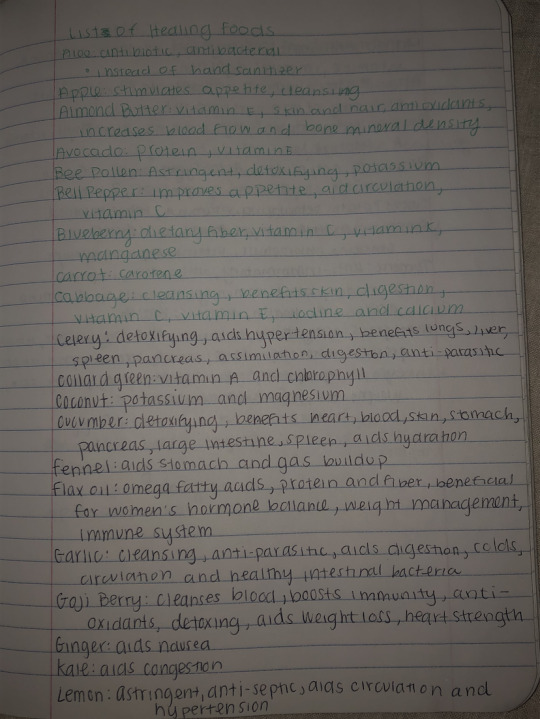
Personal Photo of healthy foods from 2016 with Healing properties.
Documentation of The Dance Between Soil, Food and Humans
The first film, Symphony of Soil captured many images and videos of different types of soil. It also portrayed the connection that humans have made with nature through visuals of the doctors and scientists in the film digging into soil and holding it in the palms of their hands. In reality, soil supports all life and holds us. The main idea with these visuals is that soil is concrete, so concrete, in fact, that we can hold it in the palms of our hands. This is an important factor, as many environmental issues are not taken seriously since they are somewhat less concrete and able to be seen, like climate change.
Every time a new expert talked about a new type of soil, the camera panned over different natural places, including but not limited to, Norway, Hawaii, India, California and New York. Paired with these landscapes were musical tracks that aimed to match the culture of the given setting. The film aimed to educate about soil as the foundation of human life, and this was achieved with visuals of man walking within nature beside scenes of animals walking within nature. These types of scenes helped curate the story of how nature is all connected–the ocean, the soil, animals, and organisms.
As the film progressed, it transformed into a story of how soil has been ruined by us, even though we think it exists for us. The viewer was told that older soil can support any kind of plant life, because it is very nutrient rich. However, agriculture requires constant tilling of the soil, which means it is reborn often. This is a result of the Green Revolution, which really wasn’t green at all; we began using chemicals on farms to increase output. We have increased the runoff of dangerous chemicals into waterways and onto other farms with unintended consequences of eventual decreased output. This lower output comes as a result of degraded soil by these chemicals. Organic farming, which is really just traditional farming, is the response to undo the green revolution and its effects on the soil. The film also suggests other solutions such as composting. But any solution serves as a means to the end of improving the quality of the soil. By the end of the film, the viewer is asked to change the way we think about soil: not as dirt, but rather as a material of life.
The other documentary, Food Inc., featured many different kinds of clips outlining the relationship between people and food. These clips included those of different kinds of factories, farms, restaurants and grocery stores, which helped explain how much of the industrial food industry uses greenwashing, with images of systems that no longer exist. Moreover, the footage has a revealing nature to it, and is organized in such a way which tells a story that most people are not aware of. This lends itself to the nature of the film, which asks consumers to be more aware of how our purchases affect the food and farming industry.
Food Inc. focuses on the fact that the way we eat has changed drastically in the last 50 years. Most of the food available to us is owned by a small group of national corporations. As the narrator tells us this, a scene of business men walking up to a factory in a field is played. Food Inc.’s purpose is to show the viewer how we have been distanced from our food, what we don’t know about it, and what we can do to make a difference. We are told over and over again in this film how big business has cut costs to produce the food put on our plates. Interviews are conducted with farmers stuck under the stronghold of these companies, with organic farmers, food experts and ethical corporations.
The narrative is split into nine digestible sections: fast food to all food, a cornucopia of choices, unintended consequences, the dollar menu, in the grass, hidden costs, from seed to supermarket, the veil, and shocks to the system. In the first section, the ethics of industrial farming are first called into question with information about the conditions of the animals and the workers. In this section, there were also captions of the fact that two of these companies (Tyson and Perdue) declined to be interviewed for the film. In the second section, the topic of corn was rampant, as it is in our food, though we are convinced otherwise through the illusion of diverse ingredients on our food labels. In the third section, e-coli was highlighted as a result of corn feed in animals, and if animals get e-coli, so do the crops which are fertilized by their wastes. Though the simple solution of using grass feed for 5 days would reduce e-coli in animals by 80%, the corporations prefer to invest in technological innovation, rather than taking it back to basics. In the fourth section, the unfortunate reality of price came into play with the fact that many people have to balance the cost of buying vegetables with the cost of medication for diseases that occur as a result of eating unhealthy. This idea is always crazy to me; when we talk about the fact that the people living in one of the most agricultural states in the country (California) can’t afford vegetables it sounds like a developing country, not one of the most developed ones. In the fifth section, more ethical issues were discussed, this time dipping into government subsidies working against the environment and supporting unsafe practices. In the sixth section, business was blamed for pollution, but also portrayed as a possible part of the solution. In the seventh section, Monsanto was featured as a company who has found legal ways to own certain crops, which endangers the livelihood of farmers. They also declined to be interviewed for the film. In the eighth section, the corruption of the American government by the aforementioned large corporations was revealed. In the final section, consumers were empowered to vote with our dollar when possible by purchasing organic products.
Reviews
Reviews of the Symphony of Soil included one by the Bard Center for Environmental Policy, which claimed that the film “put faith in her viewers’ intelligence by allowing science to play a central role in her film, avoiding the tendency of many environmental films to build their argument by demonizing the ‘other side’” (Macgregor 2013). Another review by Variety described it as, “a seemingly endless procession of organic farmers from Washington state to Wales to India wander their flourishing fields, displaying the fruits of the ‘dance with nature’ that is organic agriculture. With minor variations, all make the same strong case for a simple solution to soil exhausted by plowing, chemical fertilizers and pesticides: Give back to the soil what was taken from it and it will endlessly replenish itself” (Scheib 2013). I would agree with this review that the film was a bit repetitive, but definitely got the point across. The documentary aims to educate about what can be done for soil, and what soil does for us. There is no direct call-to-action, per say, but it is clear cannot ride the current path, as it will lead to an “imminent agricultural Armageddon, with its attendant barren soil, polluted waters and birth defects” (Scheib 2013). I wasn’t completely captured by the film, but I know the issues presented are important and the information seemed accurate based on the presentation of the facts by educated professionals.
Of Food Inc., one reviewer at the New York times said it was, “an informative, often infuriating activist documentary about the big business of feeding or, more to the political point, force-feeding, Americans all the junk that multinational corporate money can buy. You’ll shudder, shake and just possibly lose your genetically modified lunch” (Dargis 2009). However, the same reviewer also claimed it was “also over before the issues have really been thrashed through. And while I appreciate the impulse behind the final checklist that tells what viewers can do for themselves and the world (er, eat organic), given everything we’ve just seen, it also registers as far too depressingly little” (Dargis 2009). In another review by the Washington Post, a reviewer states, “Those expecting an unfair broadside against the food industry will be pleasantly surprised by “Food, Inc.” Instead of scoring cheap points by disgusting viewers with the messy inside workings of a slaughterhouse, director Robert Kenner sticks to relaying the facts” (Bunch 2009). The same review claimed that though “the documentary sometimes feels a little one-sided, lack of participation by companies such as Monsanto Co. and Tyson Foods Inc. ensured such a result” (Bunch 2009). I think both of these reviews are valid, as I felt similarly. I thought the documentary did a good job of bringing attention to the issues at hand in an organized and accessible manner. However, we can always say they could have done more. Personally, I found Food Inc. not only effective, but also entertaining.
Closing Thoughts
In conclusion, both films supported the narrative that the current way in which we are farming is unsustainable, unhealthy, and unsettling. Symphony of Soil used science to bring light to the basics of life and how humans have disrupted them. Food Inc. revealed lesser known facts about the way in which our food has changed in the past 50 years, and what we should do to change that. I preferred Food Inc., as I felt the narrative was easier to connect with and follow. It also had a clear call-to-action approach, which Symphony of Soil lacked. The problems outlined in Food Inc. feel more relevant than those in Symphony of Soil, and I think that is increasingly important in mobilizing public opinion and activism.
Word Count: ~1800 Words
Question: How can film/documentary be more widely accessible forms of knowledge?
Works Cited
Bunch, Sonny. 2009. “MOVIE REVIEW: 'Food, Inc.'” Accessed March 29, 2020.
https://www.washingtontimes.com/news/2009/jun/19/movie-review-food-inc/
Dargis, Manohla. 2009. “Meet Your New Farmer: Hungry Corporate Giant.” Accessed March 29, 2020. https://www.nytimes.com/2009/06/12/movies/12food.html
Garcia, Debora K.[กรมพัฒนาที่ดิน แชนแนล LDD Channel]. (2018, November 23). Symphony of Soil [Video file]. YouTube. https://www.youtube.com/watch?v=tDZVKMe2FTg
Kenner R. (Producer & Director). (2009). Food Inc. [Film]. Magnolia Pictures.
Macgregor, Marnie. 2013. “Film Review: Symphony of the Soil.” Accessed March 29, 2020. https://www.bard.edu/cep/blog/?p=4155
Scheib, Ronnie. 2013. “Film Review: ‘Symphony of the Soil.’” Accessed March 29, 2020. https://variety.com/2013/film/reviews/film-review-symphony-of-the-soil-1200725684/
0 notes
Text
Assignment 9 First Draft: In Depth Analysis of Symphony of Soil and Food Inc.
The long-form documentary can be used to effectively tell stories that have been historically left untold. Symphony of Soil is an interactive documentary which relies largely on interviews from scholars in the field of geology and environmental studies. Food inc., on the other hand, is more of a reflexive documentary, which demands viewers to think about and criticize the current system. Both films strengthen the narrative that the current way in which most of the food–especially in this country–is farmed is unsustainable, unhealthy, and frankly, unsettling.
Documentation of The Dance Between Soil, Food and Humans
The first film, Symphony of Soil captured many images and videos of different types of soil. It also portrayed the connection that humans have made with nature through visuals of the doctors and scientists in the film digging into soil and holding it in the palms of their hands. In reality, soil supports all life and holds us. The main idea with these visuals is that soil is concrete, so concrete, in fact, that we can hold it in the palms of our hands. This is an important factor, as many environmental issues are not taken seriously since they are somewhat less concrete and able to be seen, like climate change.
Every time a new expert talked about a new type of soil, the camera panned over different natural places, including but not limited to, Norway, Hawaii, India, California and New York. Paired with these landscapes were musical tracks that aimed to match the culture of the given setting. The film aimed to educate about soil as the foundation of human life, and this was achieved with visuals of man walking within nature beside scenes of animals walking within nature. These types of scenes helped curate the story of how nature is all connected–the ocean, the soil, animals, and organisms.
As the film progressed, it transformed into a story of how soil has been ruined by us, even though we think it exists for us. The viewer was told that older soil can support any kind of plant life, because it is very nutrient rich. However, agriculture requires constant tilling of the soil, which means it is reborn often. This is a result of the Green Revolution, which really wasn’t green at all; we began using chemicals on farms to increase output. We have increased the runoff of dangerous chemicals into waterways and onto other farms with unintended consequences of eventual decreased output. This lower output comes as a result of degraded soil by these chemicals. Organic farming, which is really just traditional farming, is the response to undo the green revolution and its effects on the soil. The film also suggests other solutions such as composting. But any solution serves as a means to the end of improving the quality of the soil. By the end of the film, the viewer is asked to change the way we think about soil: not as dirt, but rather as a material of life.
The other documentary, Food Inc., featured many different kinds of clips outlining the relationship between people and food. These clips included those of different kinds of factories, farms, restaurants and grocery stores, which helped explain how much of the industrial food industry uses greenwashing, with images of systems that no longer exist. Moreover, the footage has a revealing nature to it, and is organized in such a way which tells a story that most people are not aware of. This lends itself to the nature of the film, which asks consumers to be more aware of how our purchases affect the food and farming industry.
Food Inc. focuses on the fact that the way we eat has changed drastically in the last 50 years. Most of the food available to us is owned by a small group of national corporations. As the narrator tells us this, a scene of business men walking up to a factory in a field is played. Food Inc.’s purpose is to show the viewer how we have been distanced from our food, what we don’t know about it, and what we can do to make a difference. We are told over and over again in this film how big business has cut costs to produce the food put on our plates. Interviews are conducted with farmers stuck under the stronghold of these companies, with organic farmers, food experts and ethical corporations.
The narrative is split into nine digestible sections: fast food to all food, a cornucopia of choices, unintended consequences, the dollar menu, in the grass, hidden costs, from seed to supermarket, the veil, and shocks to the system. In the first section, the ethics of industrial farming are first called into question with information about the conditions of the animals and the workers. In this section, there were also captions of the fact that two of these companies (Tyson and Perdue) declined to be interviewed for the film. In the second section, the topic of corn was rampant, as it is in our food, though we are convinced otherwise through the illusion of diverse ingredients on our food labels. In the third section, e-coli was highlighted as a result of corn feed in animals, and if animals get e-coli, so do the crops which are fertilized by their wastes. Though the simple solution of using grass feed for 5 days would reduce e-coli in animals by 80%, the corporations prefer to invest in technological innovation, rather than taking it back to basics. In the fourth section, the unfortunate reality of price came into play with the fact that many people have to balance the cost of buying vegetables with the cost of medication for diseases that occur as a result of eating unhealthy. This idea is always crazy to me; when we talk about the fact that the people living in one of the most agricultural states in the country (California) can’t afford vegetables it sounds like a developing country, not one of the most developed ones. In the fifth section, more ethical issues were discussed, this time dipping into government subsidies working against the environment and supporting unsafe practices. In the sixth section, business was blamed for pollution, but also portrayed as a possible part of the solution. In the seventh section, Monsanto was featured as a company who has found legal ways to own certain crops, which endangers the livelihood of farmers. They also declined to be interviewed for the film. In the eighth section, the corruption of the American government by the aforementioned large corporations was revealed. In the final section, consumers were empowered to vote with our dollar when possible by purchasing organic products.
Reviews
Reviews of the Symphony of Soil included one by the Bard Center for Environmental Policy, which claimed that the film “put faith in her viewers’ intelligence by allowing science to play a central role in her film, avoiding the tendency of many environmental films to build their argument by demonizing the ‘other side’” (Macgregor 2013). Another review by Variety described it as, “a seemingly endless procession of organic farmers from Washington state to Wales to India wander their flourishing fields, displaying the fruits of the ‘dance with nature’ that is organic agriculture. With minor variations, all make the same strong case for a simple solution to soil exhausted by plowing, chemical fertilizers and pesticides: Give back to the soil what was taken from it and it will endlessly replenish itself” (Scheib 2013). I would agree with this review that the film was a bit repetitive, but definitely got the point across. The documentary aims to educate about what can be done for soil, and what soil does for us. There is no direct call-to-action, per say, but it is clear cannot ride the current path, as it will lead to an “imminent agricultural Armageddon, with its attendant barren soil, polluted waters and birth defects” (Scheib 2013). I wasn’t completely captured by the film, but I know the issues presented are important and the information seemed accurate based on the presentation of the facts by educated professionals.
Of Food Inc., one reviewer at the New York times said it was, “an informative, often infuriating activist documentary about the big business of feeding or, more to the political point, force-feeding, Americans all the junk that multinational corporate money can buy. You’ll shudder, shake and just possibly lose your genetically modified lunch” (Dargis 2009). However, the same reviewer also claimed it was “also over before the issues have really been thrashed through. And while I appreciate the impulse behind the final checklist that tells what viewers can do for themselves and the world (er, eat organic), given everything we’ve just seen, it also registers as far too depressingly little” (Dargis 2009). In another review by the Washington Post, a reviewer states, “Those expecting an unfair broadside against the food industry will be pleasantly surprised by “Food, Inc.” Instead of scoring cheap points by disgusting viewers with the messy inside workings of a slaughterhouse, director Robert Kenner sticks to relaying the facts” (Bunch 2009). The same review claimed that though “the documentary sometimes feels a little one-sided, lack of participation by companies such as Monsanto Co. and Tyson Foods Inc. ensured such a result” (Bunch 2009). I think both of these reviews are valid, as I felt similarly. I thought the documentary did a good job of bringing attention to the issues at hand in an organized and accessible manner. However, we can always say they could have done more. Personally, I found Food Inc. not only effective, but also entertaining.
Closing Thoughts
In conclusion, both films supported the narrative that the current way in which we are farming is unsustainable, unhealthy, and unsettling. Symphony of Soil used science to bring light to the basics of life and how humans have disrupted them. Food Inc. revealed lesser known facts about the way in which our food has changed in the past 50 years, and what we should do to change that. I preferred Food Inc., as I felt the narrative was easier to connect with and follow. It also had a clear call-to-action approach, which Symphony of Soil lacked. The problems outlined in Food Inc. feel more relevant than those in Symphony of Soil, and I think that is increasingly important in mobilizing public opinion and activism.
Word Count: ~1800 Words
Question: How can film/documentary be more widely accessible forms of knowledge?
Works Cited
Bunch, Sonny. 2009. “MOVIE REVIEW: 'Food, Inc.'” Accessed March 29, 2020.
https://www.washingtontimes.com/news/2009/jun/19/movie-review-food-inc/
Dargis, Manohla. 2009. “Meet Your New Farmer: Hungry Corporate Giant.” Accessed March 29, 2020. https://www.nytimes.com/2009/06/12/movies/12food.html
Garcia, Debora K.[กรมพัฒนาที่ดิน แชนแนล LDD Channel]. (2018, November 23). Symphony of Soil [Video file]. YouTube. https://www.youtube.com/watch?v=tDZVKMe2FTg
Kenner R. (Producer & Director). (2009). Food Inc. [Film]. Magnolia Pictures.
Macgregor, Marnie. 2013. “Film Review: Symphony of the Soil.” Accessed March 29, 2020. https://www.bard.edu/cep/blog/?p=4155
Scheib, Ronnie. 2013. “Film Review: ‘Symphony of the Soil.’” Accessed March 29, 2020. https://variety.com/2013/film/reviews/film-review-symphony-of-the-soil-1200725684/
0 notes
Text
Assignment 7 Final Draft: Are We Responsible For Sustaining the Environment and its Services?

Figure 1. Costa Rica (Van Fleet 2019).
Short answer: Yes. Here’s why.
“The natural world is everywhere disappearing before our eyes–cut to pieces, mowed down, plowed under, gobbled up, replaced by human artifacts” -Edward O. Wilson (Miller and Spoolman 2016, 193).
#WhatRoleDoHumansPlayInTheLossOfSpeciesAndEcosystemServices?
The natural extinction rate of a species is known as the background extinction rate. The extinction of many species in a short time frame is referred to as a mass extinction. The causes of mass extinction are unclear, but likely can be attributed to changing environmental conditions to which species have been unable to adapt. Some species are affected more than others; freshwater vertebrates have been affected most in recent years (Geobeats 2015). While mass extinctions are devastating to the existing life on earth, they also allow new life to emerge. We can see these types of changes happening now as a result of climate change–anthropogenic climate change.
In the past 40 years, the global wildlife population has declined by 40%. This decline is directly correlated with a rise in human population and therefore consumption, habitat construction and unsustainable human destruction (Geobeats 2015). “The first animal species to go are the big, the slow, the tasty, and those with valuable parts such as tusks and skins” (Miller and Spoolman 2016, 196). This quote outlines the responsibility that humans have to prevent the decline of other species, because we are a huge cause of their decline. In this century, it is estimated that the extinction rate will rise to 10,000 times the background rate due to human activity. This estimation suggests that we are entering earth’s sixth mass extinction: the end of the world as we know it.
#WhyShouldWeTryToSustainWildSpeciesAndTheEcosystemServicesTheyProvide?
Honeybees are a vital species in human survival. Now, that is not to say that nature exists only to serve us, but if we cannot appreciate the vital position they hold in their ecosystem, we should at least be able to recognize what they can do for us. This way, we will be motivated to protect them, which is the most important end. Honeybees perform the act of pollination, which enables flowers to produce seeds and fruit (which we enjoy and survive on!). “Honeybees pollinate about 71% of vegetable and fruit crops that provide 90% of the world’s food and a third of the U.S. food supply” (Miller and Spoolman 2016, 192). This vital species is very difficult to mimic, as seen in an episode of black mirror.

Figure 2. Black Mirror Killer. Bee Drones. Apparently Harvard Engineers are working on this phenomenon in real life, “RoboBees.” Terrifying. (Ronson 2016).
The world’s human societies are dangerously dependent on honeybees, and without them, we may collapse. Their communities are experiencing Colony Collapse Disorder (CCD), wherein honeybees leave the community and hives die. Some specific human causes of CCD are pesticides stored in hives, stress from transport of hives, and reliance on unnatural high fructose corn syrup. Humans must stop manipulating these communities to our advantage to prevent complete collapse.
We should avoid accelerating the extinction of wild species, like honeybees, due to the ecosystem and economic services they provide. The economic and environmental costs of losing such vital species would be insurmountable. On a more basic basis, in line with my life-centered worldview, every species has the right to life, regardless of their purpose to the human species.
#HowDoHumansAccelerateSpeciesExtinctionAndDegradeOfEcosystemServices?
Humans are a very destructive species. We live where we want to, eat what we want to, purchase what we want to, and travel how we want to regardless of the burdens imposed on other species. We are an invasive species; we degrade natural habitat, pollute the biosphere, overexploit the resources we rely on, all while contributing to a global climate change we refuse to acknowledge to try to fix. The acronym HIPPCO accurately portrays the way human existence accelerates species extinction and degrades ecosystem services.
“HIPPCO: Habitat destruction, degradation and fragmentation; Invasive (nonnative) species; Population growth and increasing use of resources; Pollution; Climate Change; and Overexploitation” (Miller and Spoolman 2016, 198).
Our assumption that we are conquerors of a world that exists to serve us is damaging in unsustainable and irreparable ways.
An example of human domination is the illegal killing, capturing and selling of wild species that is all too commonplace. This is very common with African Savannah elephants due to their valuable ivory tusks. I would argue that the ivory is of much more value to the elephants themselves, as they cannot survive without it. In Nairobi, Kenya, this poaching has historically been a rampant issue, and has left many baby elephants orphaned. As a result, The Sheldrick Wildlife Trust’s elephant orphanage has taken in these babies to raise them and protect them until adulthood (Hodge 2019). This is the type of action humans are responsible for taking as a result of too many years of mistreatment.
In 2017, I was lucky enough to visit this orphanage, where I was told that the baby elephants needed to be protected from predators, since their parents had been killed by poachers. This was the human management of the elephant population which Kenya holds so dear.
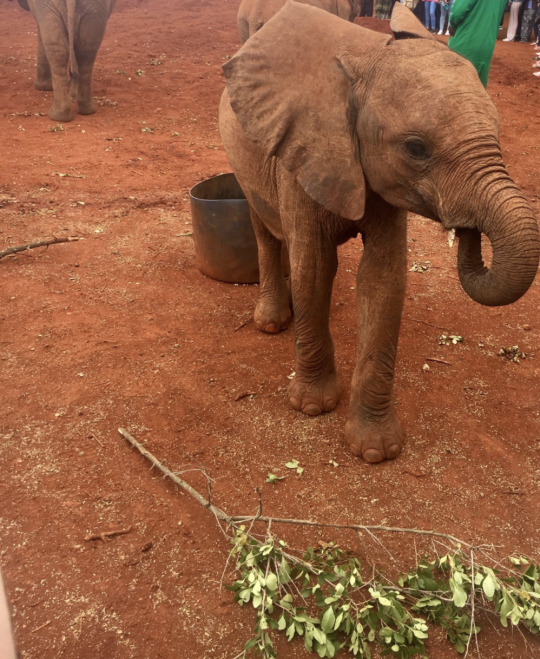
Figure 3. Nairobi Elephant Orphanage. Personal Photo.
#HowCanWeSustainWildSpeciesAndTheEcosystemServicesTheyProvide?
We can, and should, sustain wild species and their “ecosystem services by establishing and enforcing national environmental laws and international treaties and by creating and protecting wildlife sanctuaries” (Miller and Spoolman 2016, 211). One of the most effective international treaties is the Convention on International Species of Wild Fauna and Flora (CITES), which is signed by 181 countries and protects endangered species. However, as common with international treaties and laws respecting the environment, the results have been limited by lack of enforcement. Additionally, violators of the treaty are rarely punished severely, which leaves little to no consequence for violation. In the United States, the Endangered Species Act of 1973 helps identify and protect endangered species, then implement the recovery of such species. The act has been successful thus far in both protecting and recovering many species. However, certain aspects of it are difficult to implement due to a lack of manpower, such as the confiscation of shipments of endangered or threatened species. There have been countless efforts to weaken the ESA through budgeting; critics assume the act prioritizes the welfare of other species aside from humans. Others would contend that the act is not strong enough, and requires more funding, greater emphasis on recovery and protection of the habitats of threatened species.
Some other ways humans sustain wild species is through seed banks, botanical gardens, wildlife farms, zoos and aquariums. Something the book fails to mention is how many of these resources have been used purely for entertainment purposes, rather than education purposes, without enough attention to protection and reintroduction of the species on display to their natural habitats. Specifically, zoos and aquariums have been documented for their mistreatment of animals and robbery from their natural habitats. While these assets can be used as forces for good in educating the public, they must behave in ethical ways that do not disrupt the natural order, and rather contribute to sustaining it.
Overall, we should be following the precautionary principle, which suggests that when there is evidence of potential harm on human environmental health, measures should be taken to prevent said harm, regardless of if the scientific evidence is incomplete. Science is an ever-evolving field, and should be respected as such.
#WhatAreTheMajorThreatsToForestEcosystems?
The major threats to forest ecosystems are unsustainable cutting and burning of forests along with climate change. The ecosystem services forests provide have greater economic value than that of their products (paper, wood, raw material).

Figure 4. Forests’ important ecosystem and economic services (Miller and Spoolman 2016, 223).
Forests also maintain human health, through supplying blueprints for modern medicine.
Different types of forests exist: old-growth, second-growth and commercial. Old-growth or primary forests are the most biodiverse and natural. Second-growth forests develop after trees have already been removed by human activity. Commercial forests, or tree plantations/farms, are highly managed, highly homogenous, and regularly clear-cut for industrial products. Commercial forests exist mostly for human purpose, and support very little wildlife.
Clear cutting is the least sustainable, yet most cost efficient form of cutting. It can destroy ecosystems through soil erosion and runoff, and contributes to global warming and climate change. More sustainable methods, such as selective cutting and strip cutting leave much of the forest intact, or leave time for regeneration.
Two types of fires can affect forest ecosystems, and not always in a bad way. Surface fires tend to burn only what lies on the forest floor: dead leaves, seedlings and small trees. Most mature trees survive and most animals escape. Surface fires burn away flammable material which could build up to cause more destruction, provide nutrients trapped in the slowly decomposing floor matter, release seeds, stimulate germination, and help control disease and destructive insects. The other type of fire is a crown fire, which travels at the top of the trees and burns them entirely. Crown fires occur in forests that have not experienced surface fires for too long. Crown fires can become wildfires, and have increasingly in recent years due to climate change. Climate change creates hotter and drier conditions in the forests, which cause longer fire seasons. Humans have also moved to forests, and suppress small fires, which lets debris build up.
Deforestation is major environmental issue, and if we continue on the current path, about 40% of the world’s remaining forests will be converted for human use (agriculture, extraction) in the next two decades. It is necessary that the general public, especially destructive corporations, recognize the long-term harmful environmental effects of deforestation outweigh the short-term economic benefits. This reliance is both economically and environmentally unsustainable.
#HowCanWeManageAndSustainForests?
We can, and should, manage and sustain forests through emphasis on the economic value of their ecosystem services, ending subsidies that expedite their destruction, protection of old-growth forests, sustainable harvesting and planting of trees. A big problem outlined in the book was that of local communities destroying forests, specifically in Haiti (Miller and Spoolman 2016, 234). These communities cut trees down for survival before they are able to grow to maturity. With the population rising, this problem is expected to worsen. However, the book fails to mention that many of these communities are left with no other option for survival. I think that the global community has an obligation to help provide other options to these communities. Additionally, I think by outlining this as a case study, the book underplays the much larger role that developed countries’ demands have on forests.
Our consumption and demand for products from forests play a big role in the destruction of forests. We can use our purchasing power to reduce the demand for such behavior by purchasing alternatives to tree products, such as bamboo or rice based products or FSC certified products. Additionally, to reduce waste, we can try to reuse more durable products in our daily lives.
One solution for more sustainable management of forests is through debt-for-nature swaps, wherein countries protect forest areas in return for foreign aid or debt relief. Likewise, conservation concessions produce similar results, but private organizations pay for the preservation. Governments should also be responsible for outlawing illegal logging and ending subsidies that support such activities. Reforestation also plays a huge role in sustainability by recovering destroyed forests. This was proven in the Green Belt movement in Kenya, which replenished forests and their ecosystem services. As a result, forty other African countries have adopted this method.
#HowCanWeManageAndSustainGrasslands?
By controlling the amount and distribution of grazing livestock and restoring degraded grasslands, we can sustainably manage grasslands (Miller and Spoolman 2016, 237). Grasslands make up ¼ of earth’s land surface, and provide many important ecosystem services, which we are responsible for maintaining. Grasslands are a sustainable feeding ground, since they are highly renewable, if only the top parts of the blades are consumed. However, too often these areas are overgrazed to the point where their roots are destroyed. To avoid overgrazing, humans must not exceed the carrying capacity of a given area.
#HowCanWeSustainTerrestrialBiodiversityAndEcosystemServices?
To sustain terrestrial biodiversity and ecosystem services, we should establish and protect wilderness areas, parks, and nature preserves; identify and protect highly threatened biological hotspots; and protect ecosystem services, restore ecosystems and share areas which we currently dominate. Currently only 6% of the land surface is protected from harmful human activity; 94% of the surface has been lent to human use. A big reason any land is protected at all in the United States is thanks to President Theodore Roosevelt, who proposed we leave the earth as we found it. However, as the human population grows, this becomes increasingly difficult as the demand for natural resources to sustain that population increases accordingly. Climate change coincides with these issues and only worsens their consequences. When protecting land, we must ensure that the areas do not become too popular, and therefore destroyed by the human footprint. A major theme throughout these chapters in the idea that though the desire for conservation and preservation are legitimate, the enforcement of such ideas is difficult and ineffective. This is true of buffer zones in nature reserves, wherein people can extract resources from a certain portion of the reserve, without harming the inner core. The inner core grows smaller and smaller as enforcement is lax. In order to protect areas of biodiversity and their services, it is important to recognize other social issues that contribute to the problem, and create societies that value and prioritize the sustainability of the natural world.
Let’s look to Costa Rica as a shining example of sustainability excellence. Though it has experienced immense losses of forest cover, Costa Rica still exists as a biodiversity hub. Its biodiversity can be attributed to the #blessed geographic location between two oceans with both coastal and mountain regions, and to the government’s conservation commitment. The government has removed harmful subsidies, and instead implements ones which benefit landowners who maintain, restore and manage forests under 10-15 year agreements. Within thirty years, forests came to cover 50% of Costa Rica’s land. Additionally, the government established megareserves, with the goal of sustainability of biodiversity, rather than the goal of sustainability of the human population. Costa Rica does use the buffer zone approach, which has implemented the win-win principle of sustainability, as local communities have been involved with managing reserve areas. This success is due to the strong support and enforcement of the government, and the respect of the land by people who live there. Costa Rica employs young people in the community to play an essential role in the reforestation movement, which is a tool for education and engagement. Though Costa Rica has become an attraction for ecotourism, as with other reserves, their attraction must be balanced, since their priority is sustainability of the natural world.
Word Count: 2430 Words
Question: How can the alternative sustainable options for consumers be made more accessible to all groups?
Works Cited
GeoBeats. “Global Wildlife Population Declined By 50% In Last 40 Years.” n.d. Dailymotion video, 1:29. Posted 2015. https://www.dailymotion.com/video/x26ybub Hodge, Channon. 2019. “Orphaned Elephants Get New Life in Kenya.” Accessed March 5, 2020. https://www.cnn.com/travel/article/elephant-orphanage-nairobi-kenya/index.html Miller, G. Tyler, and Scott E. Spoolman. 2016. Living in the Environment: Nineteenth Edition, 193-249. Canada: Cengage Learning. Ronson, Jaqueline. 2016. “'BLACK MIRROR’ KILLER BEE DRONES ARE COMING FOR YOU IRL.” Accessed March 5, 2020. https://www.inverse.com/article/22678-black-mirror-robot-bee-drones
0 notes
Text
Assignment 8 Final Draft: How has invasive crap muddied our waters and food system?

Figure 1. Tweet about Coronavirus by Sunny Randhawa. (@SunnyRandhawa, March 17, 2020).
“With every drop of water you drink, with every breath you take, you are connected to the sea, no matter where on Earth you live.” -Sylvia Earl (Miller and Spoolman 2016, 253).
#WhatAreTheMajorThreatsToAquaticBiodiversityAndEcosystemServices?
Major threats to aquatic species and their economic and ecosystem services include loss of habitat, invasive species, pollution, climate change, and overexploitation (HIPPCO). Basically, humans are the most major threat to aquatic biodiversity and ecosystem services. We know very little about aquatic biodiversity and how to protect it.
But here’s what we do know:
The largest amount of biodiversity exists around coral reefs, in estuaries and on the deep-ocean floor.
Biodiversity is greater near the coasts than in the open sea due to the larger variety of coastal producers and habitats.
Biodiversity is higher in the lower regions of the ocean due to more habitats and food sources from the ocean floor.
As mentioned above, and many times before, humans tend to only make things worse. We have destroyed much of earth’s aquatic ecosystems, degraded coastal sea-grass beds through coastal development, and built dams in freshwater zones. Some scientists believe we have entered the sixth mass extinction, as fossil records have shown than coral reefs were lost in the past five mass extinctions, and they are being degraded and lost now as well, because of us! Humans produce unnaturally high CO2 emissions which are absorbed by the ocean, and result in ocean acidification. We transport invasive species (purposely and accidentally) on cargo ships through globalized trade. These species can destroy entire ecosystems. In addition, 80% of the world’s people live along or near coastal areas, which puts massive pressure on the coastal zones. This pressure is seen in the form of runoff from pesticides on our lawns, and from toxic pollutants from industrial and urban areas. Not to mention the plastic we rely on never breaks down and often ends up in our oceans, breaking down incompletely to small particles, which fish and other organisms mistake for food. We then eat these fish, and therefore what they have eaten ends up in our systems too. We eat so much fish, in fact, that 87% of the world’s commercial fisheries have been exploited and overfished.
I apologize on behalf of the human population, and also for being a part of the problem in many ways.
#HowCanWeProtectAndSustainMarineBiodiversity?
We can protect and sustain marine biodiversity through laws and economic incentives, marine reserves and community-based integrated coastal management.
Easier said than done. Protecting marine biodiversity is difficult due to the expanding human ecological footprint and fishprint (how much fish we consume), the existing damage to earth’s bodies of water, the human outlook on the oceans as an inexhaustible resource, and the tragedy of the commons. These obstacles prove how difficult it can be to get the entire world on board with enforcing and complying with sustainability. Even when nations do support it, their punishment for sustainability violations are often inadequate.
To protect and sustain marine biodiversity, we must restore degraded areas but also prevent the degradation from happening in the first place. Prevention is less expensive and more effective than restoration. Part of the restoration and prevention efforts will come from coastal communities and their everyday choices of waste generation and chemicals they put on their lawns. One strategy coming to light in coastal communities is integrated coastal management, in which “fishers, business owners, developers, scientists, citizens, and politicians” … “identify shared problems and goals in their use of marine resources” (Miller and Spoolman 2016, 271). This idea engages different sectors of society in assigning responsibility for the protection and sustainability of natural resources.
#HowShouldWeManageAndSustainMarineFisheries?
We should manage and sustain marine fisheries through monitoring populations, cooperative fisheries management, reduction of fishing subsidies and conscious consumer choices in buying sustainable seafood.
These methods prove yet again easier said than done. Monitoring populations of fish is difficult because the growth rate estimations are not consistent or accurate. Additionally, harvesting a species at a certain so-called “sustainable level” can affect the populations of other marine species. As with biodiversity, it is difficult to get groups of nations to cooperate in planning and managing marine fisheries, so there is a large reliance on communities to cooperate. Current subsidies encourage overfishing because they support a high output economy, but subsidies should be provided to responsible fisheries who focus on quality over quantity. Finally, consumer choice is a powerful tool that each of us holds. We should look for Marine Stewardship Council certified fish in order to make sustainable choices.

Figure 2. Ways to Manage Fisheries More Sustainably and Protect Marine Biodiversity (Miller and Spoolman 2016, 272).
#HowShouldWeProtectAndSustainWetlands?
We should protect and sustain wetlands by restoring those that have been degraded while focusing on efforts to protect those untouched. Wetlands provide many irreplaceable ecosystem and economic services. For too long, people have drained, filled in or covered over wetlands for agriculture to adapt to expanding populations. Some laws exist to protect wetlands, however there are constant efforts by land developers to weaken these protections. Solutions such as mitigation banking–which allows for the destruction of existing wetlands at the cost of restoration, creation or enhancement of another wetland–have proven to be ineffective, and ecologists suggest it only be used as a “last resort” (Miller and Spoolman 2016, 273).
#HowShouldWeProtectAndSustainFreshwaterLakesRiversAndFisheries?
We should protect and sustain freshwater lakes, rivers and fisheries by protecting their watersheds and halting harmful human activity. Lakes and streams get many key nutrients from their neighboring ecosystems, generated into bodies of water by rain storms or melting snow. These bodies of water, or watersheds, must be protected to avoid contamination of the larger bodies of water. This can and should happen through laws, economic incentives and restoration efforts.
#WhatShouldBeOurPrioritiesForSustainingAquaticBiodiversity?
Our priorities for sustaining aquatic biodiversity should be mapping and protecting hotspots, creating large, protected marine reserves, protecting freshwater ecosystems, and restoring degraded wetlands. These priorities will be possible through the cooperation of scientists, engineers, businesses, government leaders and consumers.
#WhyIsGoodNutritionImportant?
Good nutrition is important because it prevents people from problems of malnutrition or even heart disease and high cholesterol. In less-developed countries, people suffer from a lack of food, while people in more-developed countries suffer from too much food. Both suffer since the nutrients aren’t present. This lack of nutrients can weaken people, making them more susceptible to disease and hinder their normal physical and mental capacities and development. The United States is one of the most overweight and obese countries, and as a result our healthcare and lost productivity costs are about $2 trillion per year–“more than the combined annual global costs of war, terrorism and armed violence” (Miller and Spoolman 2016, 287).
The greatest obstacles to providing adequate, nutritious food to the world’s population are poverty, war, bad weather and climate change. Poverty prevents people from being able to afford the foods that meet their basic nutritional needs; they lack food security. Bad weather and climate change make these foods less available and more expensive.

Figure 3. The poor cannot afford to eat meat and in order to survive, eat further down the food chain on a diet of grain (Miller and Spoolman 2016, 285).
The book doesn’t touch on this, but it is also a tragedy because many of the world’s most impoverished groups have such a great relationship with cultural traditions involving food. This is tragic for a few reasons:
Much of the world’s food is not prepared, raised, or grown traditionally anymore, which affects its flavor and accessibility.
It is devastating when people lack the access to nutritious food to which they have forged strong relations with.
Some of the cultural traditions either involve less nutritious foods or the eating of foods that are not accepted my western (colonizing) cultures.
#HowIsFoodProduced?
Food is produced through both high and low input agriculture to accommodate the increasing global demand for food. Only a few of natures’ mammals and fish provide a large majority of the world’s sources of protein. This food specialization puts croplands in a vulnerable position of depletion of certain crops which feed these populations. If those certain crops become depleted by natural disasters or climate change, we’re essentially screwed.
Three major technological advancements have led to the increase in global food production:
The development of irrigation
Synthetic fertilizers
Synthetic pesticides
High-input agriculture uses large amounts of financial and natural capital, along with pesticides. The goal of such agriculture is to increase the yield of each crop. In contrast, low-input agriculture focuses on human capital and produces only enough crops to feed the families of the farms, and maybe some left over to sell for profit. Traditional low-input farmers capitalize on polyculture, in which various crops are planted in the same plot of land and mature at different times. This method provides food year-round and protects the topsoil from erosion and weeds.

Figure 4. Major differences between industrialized and organic agriculture (Miller and Spoolman 2016, 289).
Recently, organic agriculture has been on the rise. By law, a label of 100% organic (or USDA certified) means that a product has been produced only by organic methods with all organic ingredients. Those without certification but still labeled organic must contain at least 95% organic ingredients. Those labeled “made with organic ingredients” must have at least 70% organic ingredients. Anything else, such as “natural,” is likely a greenwashing marketing ploy.
Two green revolutions have taken place to create the food production system we rely on now. The first green revolution occurred between 1950 and 1970 and dramatically raised crop yields in more-developed countries. In the second green revolution, beginning in 1967, fast growing crops were introduced in less-developed countries. This allowed more food to be produced with less land to protect biodiversity. An important factor of these revolutions has been farm subsidies, most of which have gone to corporate farming operations for corn, wheat, soybeans and cotton on an industrial scale. On such farms, an average US farmer now feeds 129 people on the same land they could once only feed 19. As a result, Americans spend the lowest percentage of their disposable income on food. However, the cheap price at the grocery store does not include the hidden environmental costs of such industrial agriculture.
Along with the green revolutions came the gene revolutions. The first gene revolution improved varieties of crops, but crossbreeding took a long time to cultivate. The second gene revolution is currently using faster genetic engineering to develop genetically modified strains of crops and livestock animals. They use gene splicing to alter the genetic material of an organism, resulting in genetically modified organisms (GMOs). Though there are potential benefits to GMOs, scientists believe that there is not enough information about the long term environmental and health effects of them.
Food is produced based on demand. As a country’s income grows, so does their demand for meat, which is fed by grain. This combination of increased demands put a strain on the land, as it is fought for by agriculture and urban development. This struggle can lead a country to rely heavily on crop imports, like we do now. Fisheries and aquaculture are also major food producing systems. The farming of carnivorous species, such as salmon and shrimp, are growing rapidly, and are unnaturally fed on the oils and meals produced from other fish and their wastes (gross). The industrialization of food production has been made possible by fossil fuels. Fossil fuels are used to “run farm machinery and fishing vessels, to pump irrigation water for crops, and to produce synthetic pesticides and synthetic inorganic fertilizers. Fossil fuels are also used to process food and transport it long distances within and between countries” (Miller and Spoolman 2016, 294).
#WhatAreTheEnvironmentalEffectsOfIndustrializedFoodProduction?
The environmental effects of industrialized food production include, but are not limited to, soil erosion, degradation, desertification, irrigation water shortage, air and water pollution, climate change and loss of biodiversity.

Figure 5. Food production has a number of harmful environmental effects (Miller and Spoolman 2016, 294).
#HowCanWeProtectCropsFromPestsMoreSustainably?
We can protect crops from pests more sustainably but cutting our pesticide use and using a mix of cultivation techniques, biological pest controls and small amounts of selected pesticides if necessary.
Our current method of layering natural land with chemicals and pesticides that kill pests upsets the natural balance of the populations and ecosystems. Some plants actually naturally produce chemicals to ward off predators. Scientists have mimicked nature in creating biopesticides similar to the natural ones to kill pests.
The pest control revolution began with DDT in 1939, the first second-generation pesticide. However, Rachel Carson sounded the alarm on DDT in 1962, which led to stricter controls on pesticides.

Figure 6. Use of synthetic pesticides: advantages and disadvantages (Miller and Spoolman 2016, 304).
By existing, pesticides disrupt the laws of nature. This was seen in 1955, when the WHO sprayed the island of Sabah with Dieldrin (similar to DDT) in order to kill malaria-carrying mosquitos. Though it almost completely eliminated the disease, the pesticide killed other insects as well, and their predators, lizards, died after bingeing on dieldrin-contaminated insects. Then cats began to die from feeding on the lizards. Without cats, the rat population skyrocketed, threatening the population with sylvatic plague. WHO flew in healthy cats to control the rats, but then the villager’s roofs began caving in, because a specific caterpillar species also began to thrive on the leaves that made up the roofs, as its insect predators were also killed by Dieldrin. These types of unintended consequences are important to consider when using pesticides; the whole ecosystem can be unnaturally affected.
Alternatives to pesticides are important, and the EPA found in 2014 that such dangerous pesticides actually failed to “provide negligible benefits” to crop production in most situations (Miller and Spoolman 2016, 306). These findings are disputed by the pesticide industry. One alternative that can be used is biological controls, which involves using natural predators, parasites, bacteria and viruses to control pests. This option is difficult to mass-produce and can be slow-acting. Additionally, farmers can use ecological controls by practicing polyculture to provide habitats for the predators of pests in their fields. Another option is cultivation controls, in which farmers plant different crops in the same plots in intervals to starve pests or cause them to be eaten by natural predators. Finally, integrated pest management (IPM) is a program wherein each crop and its pests are evaluated as parts of an ecosystem. The goal of IPM is to reduce crop damage to an economically tolerable level with a low use of pesticides. However, it takes a lot of time and knowledge to implement.
The EPA, the FDA and the USDA regulate the use of pesticides under the Federal Insecticide, Fungicide and Rodenticide Act (FIFRA). Again, it has not been well enforced, and congress has not provided sufficient funds to evaluate pesticides for toxicity.
#HowCanWeProduceFoodMoreSustainably?
We can produce food more sustainably by using resources more efficiently, decreasing the harmful effects of industrialized food production, and eliminating harmful government subsidies. Step one is to conserve topsoil, because once it is depleted, it is an extremely costly resource to restore. Naturally, it takes hundreds of years to form. We must also restore the soil that has been damaged. Farmers can do this by using organic fertilizer. Additionally, we must reduce soil salinization and desertification, which is costly. This is done on a large scale through reduction of population growth, overgrazing, deforestation and destructive forms of planting and irrigation in dryland areas. We also should work toward decreasing the human contribution to climate change. This includes producing and consuming meat and dairy more sustainably, as meat consumption is the largest factor in the growing ecological footprints of more-developed nations. Farms should begin making the shift to completely organic, which will provide 30% more jobs than the current nonorganic system (Miller and Spoolman 2016, 313). With sustainable agriculture comes sustainable aquaculture, which will require fundamental changes for both producers and consumers. Consumers must use their power of choice to purchase fish that feed on vegetation (tilapia, carp, catfish), and then producers will increasingly produce those fish, rather than feeding carnivorous fish for a high yield.

Figure 7. More sustainable, low-input food production (Miller and Spoolman 2016, 314).
#HowCanWeImproveFoodSecurity?
“We can improve food security by reducing poverty and chronic malnutrition, producing food more sustainably, relying on locally grown food and cutting food waste” (Miller and Spoolman 2016, 316). Governments can control food prices by setting a limit on price, which would benefit consumers. They also can provide subsidies to farmers, which support organic and sustainable farming practices. Since the government rarely does this however, private corporations step in to provide microloans to impoverished communities, and use other methods to develop local food production and distribution systems. By buying local, consumers can support local economies and farmers. This reduces fossil fuel energy costs for producers, as well as the emissions from transporting and storing food over long distances. We also could grow our own food, which has been successful as urban schools and universities. Students have access to fresh produce and also learn about where their food comes from and how to grow more sustainably.
#Albatross
In the Albatross film, Midway Island is showcased. It lied more than 2000 miles away from the nearest continent. Dead birds on this island are pictured with plastic pieces in their stomachs: plastics we use everyday, plastics they’ve mistaken for food. The birds are seen dying as a result of this toxicity in their systems. They are surrounded by trash, and we are asked “do we have the courage to face the realities of our time? And allow ourselves to feel deeply enough that it transforms us, and our future?” (Jordan n.d., 2:27).
Overall, humans are the problem, and we certainly have a responsibility to forge the solutions through slowing our population growth, stopping our wasteful use of food and resources and implementing ecological solutions in all sectors of society. Food sustains our bodies, our hearts and our minds, so we have a responsibility to sustain the environments that have served us. Doing so, will demand a change in value systems and mindsets.
Word Count: ~3000 Words
Question: How can we help people understand how dire the issues in the most constructive way to drive habit change?
Works Cited
Jordan, Chris. n.d. “Albatross.” Accessed March 26, 2020. Video, 3:49.
Miller, G. Tyler, and Scott E. Spoolman. 2016. Living in the Environment: Nineteenth Edition, 253-318. Canada: Cengage Learning.
0 notes
Text
Assignment 8 First Draft: How has invasive crap muddied our waters and food system?
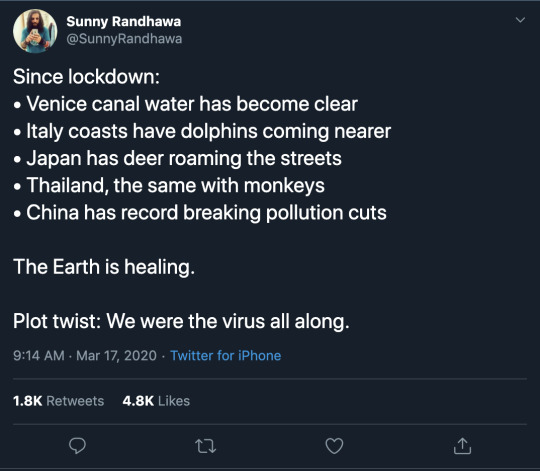
Figure 1. Tweet about Coronavirus by Sunny Randhawa. (@SunnyRandhawa, March 17, 2020).
“With every drop of water you drink, with every breath you take, you are connected to the sea, no matter where on Earth you live.” -Sylvia Earl (Miller and Spoolman 2016, 253).
#WhatAreTheMajorThreatsToAquaticBiodiversityAndEcosystemServices?
Major threats to aquatic species and their economic and ecosystem services include loss of habitat, invasive species, pollution, climate change, and overexploitation (HIPPCO). These threats are only exacerbated by the seemingly endless growth of the human population. Basically, humans are the major threat to aquatic biodiversity and ecosystem services. Most of our planet is water, and we have explored less than 5% of the earth’s oceans; we know very little about aquatic biodiversity.
Three general patterns occur within aquatic biodiversity (from what we do know).
The largest amount of biodiversity exists around coral reefs, in estuaries and on the deep-ocean floor.
Biodiversity is greater near the coasts than in the open sea due to the larger variety of coastal producers and habitats.
Biodiversity is higher in the lower regions of the ocean due to more habitats and food sources from the ocean floor.
As mentioned above, and many times before, humans tend to only make things worse. We have destroyed much of earth’s aquatic ecosystems, degraded coastal sea-grass beds through coastal development, and built dams in freshwater zones. Some scientists believe we have entered the sixth mass extinction, as fossil records have shown than coral reefs were lost in the past five mass extinctions, and they are being degraded and lost now as well. Humans also produce unnaturally high CO2 emissions which are absorbed by the ocean, and result in ocean acidification. We also transport invasive species (purposely and accidentally) on cargo ships through globalized trade. These species can destroy entire ecosystems. In addition, 80% of the world’s people live along or near coastal areas, which puts massive pressure on the coastal zones. This pressure is seen in the form of runoff from pesticides on our lawns, and from toxic pollutants from industrial and urban areas. Not to mention the plastic we rely on never breaks down and often ends up in our oceans, breaking down incompletely to small particles, which fish and other organisms mistake for food. We then eat these fish, and therefore what they have eaten ends up in our systems too. We eat so much fish, in fact, that 87% of the world’s commercial fisheries have been exploited and overfished.
#HowCanWeProtectAndSustainMarineBiodiversity?
We can protect and sustain marine biodiversity through laws and economic incentives, marine reserves and community-based integrated coastal management. Easier said than done. Protecting marine biodiversity is difficult due to the expanding human ecological footprint and fishprint, the existing damage to earth’s bodies of water, the human outlook on the oceans as an inexhaustible resource, and the tragedy of the commons. These obstacles outline how difficult it can be to get the entire world on board with enforcing and complying with sustainability. Even when nations do support it, their punishment for sustainability violations are often inadequate.
To protect and sustain marine biodiversity, we must restore degraded areas but also prevent the degradation from happening in the first place. Prevention is less expensive and more effective than restoration. Part of the restoration and prevention efforts will come from coastal communities and their everyday choices of waste generation and chemicals they put on their lawns. One strategy coming to light in coastal communities is integrated coastal management, in which “fishers, business owners, developers, scientists, citizens, and politicians” … “identify shared problems and goals in their use of marine resources” (Miller and Spoolman 2016, 271). This idea engages different sectors of society in assigning responsibility for the protection and sustainability of natural resources.
#HowShouldWeManageAndSustainMarineFisheries?
We should manage and sustain marine fisheries through monitoring populations, cooperative fisheries management, reduction of fishing subsidies and conscious consumer choices in buying sustainable seafood.
These methods prove yet again easier said than done. Monitoring populations of fish is difficult because the growth rate estimations are not consistent or accurate. Additionally, harvesting a species at a certain so-called “sustainable level” can affect the populations of other marine species. As with biodiversity, it is difficult to get groups of nations to cooperate in planning and managing marine fisheries, so there is a large reliance on communities to cooperate. Current subsidies encourage overfishing because they support a high output economy, but subsidies should be provided to responsible fisheries who focus on quality over quantity. Finally, consumer choice is a powerful tool that each of us holds. We should look for Marine Stewardship Council certified fish in order to make sustainable choices.

Figure 2. Ways to Manage Fisheries More Sustainably and Protect Marine Biodiversity (Miller and Spoolman 2016, 272).
#HowShouldWeProtectAndSustainWetlands?
We should protect and sustain wetlands by restoring those that have been degraded while focusing on efforts to protect those untouched. Wetlands provide many irreplaceable ecosystem and economic services. For too long, people have drained, filled in or covered over wetlands for agriculture to adapt to expanding populations. Some laws exist to protect wetlands, however there are constant efforts by land developers to weaken these protections. Solutions such as mitigation banking–which allows for the destruction of existing wetlands at the cost of restoration, creation or enhancement of another wetland–have proven to be ineffective, and ecologists suggest it only be used as a “last resort” (Miller and Spoolman 2016, 273).
#HowShouldWeProtectAndSustainFreshwaterLakesRiversAndFisheries?
We should protect and sustain freshwater lakes, rivers and fisheries by protecting their watersheds and halting harmful human activity. Lakes and streams get many key nutrients from their neighboring ecosystems, generated into bodies of water by rain storms or melting snow. These bodies of water, or watersheds, must be protected to avoid contamination of the larger bodies of water. This can and should happen through laws, economic incentives and restoration efforts.
#WhatShouldBeOurPrioritiesForSustainingAquaticBiodiversity?
Our priorities for sustaining aquatic biodiversity should be mapping and protecting hotspots, creating large, protected marine reserves, protecting freshwater ecosystems, and restoring degraded wetlands. These priorities will be possible through the cooperation of scientists, engineers, businesses, government leaders and consumers.
#WhyIsGoodNutritionImportant?
Good nutrition is important because it prevents people from problems of malnutrition or even heart disease and high cholesterol. In less-developed countries, people suffer from a lack of food, while people in more-developed countries suffer from too much food. Either way, both suffer, since the nutrients aren’t present. This lack of nutrients can weaken people, making them more susceptible to disease and hinder their normal physical and mental capacities and development. The United States is one of the most overweight and obese countries, and as a result our healthcare and lost productivity costs are about $2 trillion per year–”more than the combined annual global costs of war, terrorism and armed violence” (Miller and Spoolman 2016, 287).
The greatest obstacles to providing adequate, nutritious food to the world’s population are poverty, war, bad weather and climate change. Poverty prevents people from being able to afford the foods that meet their basic nutritional needs; they lack food security. Bad weather and climate change make these foods less available and more expensive.
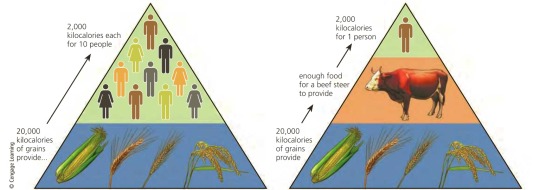
Figure 3. The poor cannot afford to eat meat and in order to survive, eat further down the food chain on a diet of grain (Miller and Spoolman 2016, 285).
#HowIsFoodProduced?
Food is produced through both high and low input agriculture to accommodate the increasing global demand for food. Only a few of natures’ mammals and fish provide a large majority of the world’s sources of protein. This food specialization puts croplands in a vulnerable position of depletion of certain crops which feed these populations. If those certain crops become depleted by natural disasters or climate change, we’re essentially screwed.
Three major technological advancements have led to the increase in global food production:
The development of irrigation
Synthetic fertilizers
Synthetic pesticides
High-input agriculture uses large amounts of financial and natural capital, along with pesticides. The goal of such agriculture is to increase the yield of each crop. In contrast, low-input agriculture focuses on human capital and produces only enough crops to feed the families of the farms, and maybe some left over to sell for profit. Traditional low-input farmers capitalize on polyculture, in which various crops are planted in the same plot of land and mature at different times. This method provides food year-round and protects the topsoil from erosion and weeds.

Figure 4. Major differences between industrialized and organic agriculture (Miller and Spoolman 2016, 289).
Recently, organic agriculture has been on the rise. By law, a label of 100% organic (or USDA certified) means that a product has been produced only by organic methods with all organic ingredients. Those without certification but still labeled organic must contain at least 95% organic ingredients. Those labeled “made with organic ingredients” must have at least 70% organic ingredients. Anything else, such as “natural,” is likely a greenwashing marketing ploy.
Two green revolutions have taken place to provide the food production system we rely on now. The first green revolution occurred between 1950 and 1970 and dramatically raised crop yields in more-developed countries. In the second green revolution, beginning in 1967, fast growing crops were introduced in less-developed countries. This allowed more food to be produced with less land to protect biodiversity. An important factor of these revolutions has been farm subsidies, most of which have gone to corporate farming operations for corn, wheat, soybeans and cotton on an industrial scale. On such farms, an average US farmer now feeds 129 people on the same land they could one only feed 19. As a result, Americans spend the lowest percentage of their disposable income on food. However, the cheap price at the grocery store does not include the hidden environmental costs of such industrial agriculture.
Along with the green revolutions came the gene revolutions. The first gene revolution improved varieties of crops, but crossbreeding took a long time to cultivate. The second gene revolution is currently using faster genetic engineering to develop genetically modified strains of crops and livestock animals. They use gene splicing to alter the genetic material of an organism, resulting in genetically modified organisms (GMOs). Though there are potential benefits to GMOs, scientists believe that there is not enough information about the long term environmental and health effects of them.
Food is produced based on demand. As a country’s income grows, so does their demand for meat, which is fed by grain. This combination of increased demands put a strain on the land, as it is fought for by agriculture and urban development. This struggle can lead a country to rely heavily on crop imports, like we do now. Fisheries and aquaculture are also major food producing systems. The farming of carnivorous species, such as salmon and shrimp, are growing rapidly, and are unnaturally fed on the oils and meals produced from other fish and their wastes (gross). The industrialization of food production has been made possible by fossil fuels. Fossil fuels are used to “run farm machinery and fishing vessels, to pump irrigation water for crops, and to produce synthetic pesticides and synthetic inorganic fertilizers. Fossil fuels are also used to process food and transport it long distances within and between countries” (Miller and Spoolman 2016, 294).
#WhatAreTheEnvironmentalEffectsOfIndustrializedFoodProduction?
The environmental effects of industrialized food production include, but are not limited to, soil erosion, degradation, desertification, irrigation water shortage, air and water pollution, climate change and loss of biodiversity.
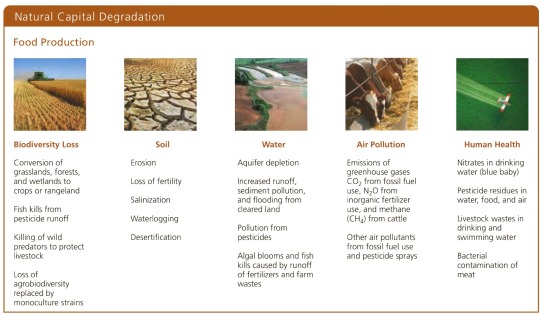
Figure 5. Food production has a number of harmful environmental effects (Miller and Spoolman 2016, 294).
#HowCanWeProtectCropsFromPestsMoreSustainably?
We can protect crops from pests more sustainably but cutting our pesticide use and using a mix of cultivation techniques, biological pest controls and small amounts of selected pesticides if necessary.
Our current method of layering natural land with chemicals and pesticides that kill pests upsets the natural balance of the populations and ecosystems. Some plants actually naturally produce chemicals to ward off predators. Scientists have mimicked nature in creating biopesticides similar to the natural ones to kill pests.
The pest control revolution began with DDT in 1939, the first second-generation pesticide. However, Rachel Carson sounded the alarm on DDT in 1962, which led to stricter controls on pesticides.
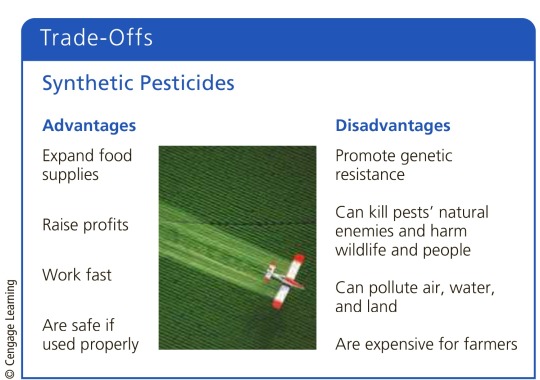
Figure 6. Use of synthetic pesticides: advantages and disadvantages (Miller and Spoolman 2016, 304).
By existing, pesticides disrupt the laws of nature. This was seen in 1955, when the WHO sprayed the island of Sabah with Dieldrin (similar to DDT) in order to kill malaria-carrying mosquitos. Though it almost completely eliminated the disease, the pesticide killed other insects as well, and their predators, lizards, died after bingeing on dieldrin-contaminated insects. Then cats began to die from feeding on the lizards. Without cats, the rat population skyrocketed, threatening the population with sylvatic plague. WHO flew in healthy cats to control the rats, but then the villager’s roofs began caving in, because a specific caterpillar species also began to thrive on the leaves that made up the roofs, as it’s insect predators were also killed by Dieldrin. These types of unintended consequences are important to consider when using pesticides; the whole ecosystem can be unnaturally affected.
Alternatives to pesticides are important, and the EPA found in 2014 that such dangerous pesticides actually failed to “provide negligible benefits” to crop production in most situations (Miller and Spoolman 2016, 306). These findings are disputed by the pesticide industry. One alternative that can be used is biological controls, which involves using natural predators, parasites, bacteria and viruses to control pests. This option is difficult to mass-produce and can be slow-acting. Additionally, farmers can use ecological controls by practicing polyculture to provide habitats for the predators of pests in their fields. Another option is cultivation controls, in which farmers plant different crops in the same plots in intervals to starve pests or cause them to be eaten by natural predators. Finally, integrated pest management (IPM) is a program wherein each crop and its pests are evaluated as parts of an ecosystem. The goal of IPM is to reduce crop damage to an economically tolerable level with a low use of pesticides. However, it takes a lot of time and knowledge to implement.
The EPA, the FDA and the USDA regulate the use of pesticides under the Federal Insecticide, Fungicide and Rodenticide Act (FIFRA). Again, it has not been well enforced, and congress has not provided sufficient funds to evaluate pesticides for toxicity.
#HowCanWeProduceFoodMoreSustainably?
We can produce food more sustainably by using resources more efficiently, decreasing the harmful effects of industrialized food production, and eliminating harmful government subsidies. Step one is to conserve topsoil, because once it is depleted, it is an extremely costly resource to restore. Naturally, it takes hundreds of years to form. We must also restore the soil that has been damaged. Farmers can do this by using organic fertilizer. Additionally, we must reduce soil salinization and desertification, which is costly. This is done on a large scale through reduction of population growth, overgrazing, deforestation and destructive forms of planting and irrigation in dryland areas. We also should work toward decreasing the human contribution to climate change. This includes producing and consuming meat and dairy more sustainably, as meat consumption is the largest factor in the growing ecological footprints of more-developed nations. Farms should begin making the shift to completely organic, which will provide 30% more jobs than the current nonorganic system (Miller and Spoolman 2016, 313). With sustainable agriculture comes sustainable aquaculture, which will require fundamental changes for both producers and consumers. Consumers must use their power of choice to purchase fish that feed on vegetation (tilapia, carp, catfish), and then producers will increasingly produce those fish, rather than feeding carnivorous fish for a high yield.
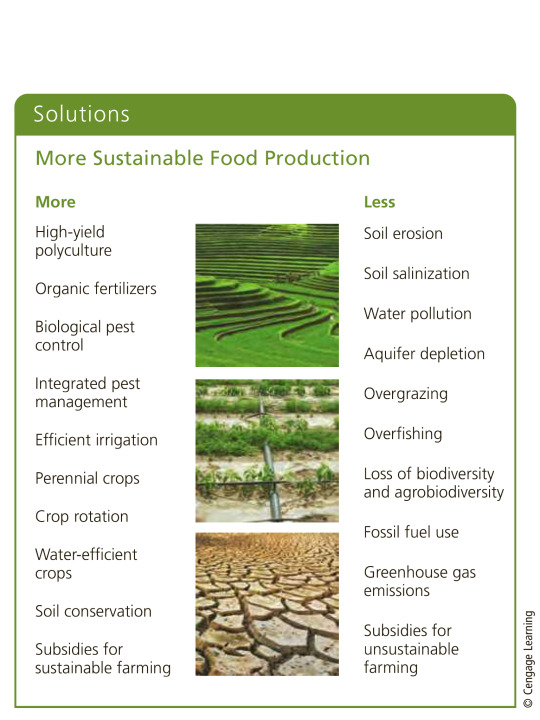
Figure 7. More sustainable, low-input food production (Miller and Spoolman 2016, 314).

Figure 8. Ways to promote more sustainable food production (Miller and Spoolman 2016, 316).
#HowCanWeImproveFoodSecurity?
“We can improve food security by reducing poverty and chronic malnutrition, producing food more sustainably, relying on locally grown food and cutting food waste” (Miller and Spoolman 2016, 316). Governments can control food prices by setting a limit on price, which would benefit consumers. They also can provide subsidies to farmers, which support organic and sustainable farming practices. Since the government rarely does this however, private corporations step in to provide microloans to impoverished communities, and use other methods to develop local food production and distribution systems. By buying local, consumers can support local economies and farmers. This reduces fossil fuel energy costs for producers, as well as the emissions from transporting and storing food over long distances. We also could grow our own food, which has been successful as urban schools and universities. Students have access to fresh produce and also learn about where their food comes from and how to grow more sustainably.
Overall, humans are the problem, and we certainly have a responsibility to forge the solutions through slowing our population growth, stopping our wasteful use of food and resources and implementing ecological solutions in all sectors of society.
Word Count: 2815 Words
Question: How can we help people understand how dire the issues int he most constructive way to drive habit change?
Works Cited
Miller, G. Tyler, and Scott E. Spoolman. 2016. Living in the Environment: Nineteenth Edition, 253-318. Canada: Cengage Learning.
0 notes
Text
Midterm Practicum Progress Report
I have always wanted to get involved with environmental initiatives on campus, but never motivated myself to do so, as I wasn’t sure of the change they were actually making. This semester, I have tried out a few clubs to see where I could have the biggest impact. I have begun to attend meetings for SEAJ (Students For Environmental Awareness and Justice) and Social Innovation Collaboratory’s Climate Impact Assessment. Personally, I definitely prefer the latter, as I am learning how to perform an impact assessment, which I think is increasingly important for multiple sectors of society to have performed. In SEAJ, we mostly talk about current events, which though I find interesting, I’m often less motivated to attend meetings when I have a lot of work to do for my classes. The Social Innovation Collaboratory, however, allows me to be involved remotely, even if I cannot attend meetings for some reason.
Through the Climate Impact Assessment and conversations in the Social Innovation Collaboratory, I have already learned how Fordham University is guilty of greenwashing. Looking at Fordham’s Sustainability Plan, I am a bit uncomfortable with the reasoning Fordham provides for pursuing sustainability at all. They place it under the responsibility of being a Jesuit University, but personally, I think that takes power away from the cause. However, it could be argued that the ends of sustainability justifies whatever means it takes to get to that point. Overall, Fordham’s proof of sustainability is quite vague, and I have a hard time understanding how they have any sort of certification in clean energy in the state of New York. Most of their data in the plan is from 2015, which is no longer relevant in our increasingly dangerous climate crisis. Fordham claims to be implementing renewable energy initiatives, but still has yet to do so. They claim to have completed two strategic LED relamping initiatives in 2015, but it is not clear where these took place on the campuses. Additionally, while Fordham does recycle on campus, I know from personal experience that it is not a real priority. In the dorms for example, there are weeks where every bin is filled with a black bag, which means that the contents of that bin will not be recycled. Additionally, Fordham takes little responsibility in educating their students on how to recycle properly, and so there is a small chance that what we are putting in the bins will actually be recycled on a state or national level. On top of that, recycling is not the best option toward sustainability due to the immense amount of energy needed to actually recycle products, so Fordham’s efforts should be positioned toward reuse and zero-waste instead. Fordham claims to have a few LEED certified buildings, but only a portion of those claimed buildings actually have the LEED plaque on them, which leads me to assume that the certification may not be accurate. In addition, not nearly enough of the buildings on campus are aimed at achieving this goal. Only new buildings are built to these standards, and the new McGinley has come at the cost of native trees on campus, which have yet to be replaced. Transportation is a sector which makes my blood boil at Fordham. Everyday gas-powered cars circulate the campus, polluting our beautiful grounds. Additionally, the ram vans claim to run on “biodiesel,” but diesel has been proven time and time again to be an unsustainable fuel. Ram vans can also often be seen filling up at the local gas station on Fordham Road, so putting a green recycling symbol on each ram van seems a bit oxymoronic. The last three sectors of the sustainability plan are all summarized in single, vague sentences, stating Fordham’s commitment to sustainability, without any real plans or initiatives in place to pursue that commitment (Fordham University, n.d.).
Thus far, the Climate Impact Assessment as part of the Social Innovation Collaboratory has been an educational tool for me that I am excited to be a part of. I am currently working on the Campus Engagement sector of the assessment, and I hope that one day we will be able to confidently check off all of the boxes of the STARS assessment.
Word Count: 703 Words
Works Cited
Fordham University. n.d. “Sustainability at Fordham.” Accessed March 8, 2020. https://www.fordham.edu/info/23673/sustainability_at_fordham
0 notes
Text
Assignment 7 First Draft: Are We Responsible For Sustaining the Environment and it’s Services?
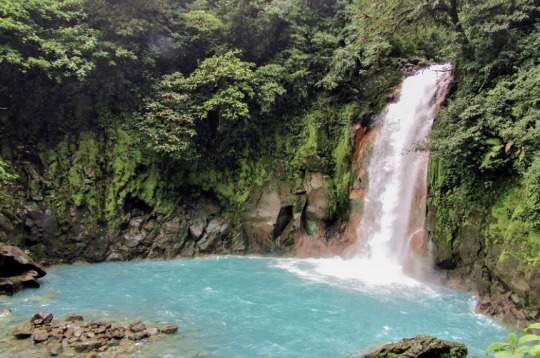
Figure 1. Costa Rica (Van Fleet 2019).
Short answer: Yes. Here’s why.
“The natural world is everywhere disappearing before our eyes–cut to pieces, mowed down, plowed under, gobbled up, replaced by human artifacts” -Edward O. Wilson (Miller and Spoolman 2016, 193).
#WhatRoleDoHumansPlayInTheLossOfSpeciesAndEcosystemServices?
The natural extinction rate of a species is known as the background extinction rate. On the other hand, the extinction of many species in a short time frame is referred to as a mass extinction. The causes of such an extinction are unclear, but likely can be attributed to changing environmental conditions to which species have been unable to adapt. Some species are affected more than others; freshwater vertebrates have been affected most in recent years (Geobeats 2015). While mass extinctions are devastating to the existing life on earth, they also allow new life to emerge. We can see these types of changes happening now as a result of climate change–anthropogenic climate change. In the past 40 years, the global wildlife population has declined by 40%. This decline is directly correlated with a rise in human population and therefore consumption, habitat construction and unsustainable human destruction (Geobeats 2015). “The first animal species to go are the big, the slow, the tasty, and those with valuable parts such as tusks and skins” (Miller and Spoolman 2016, 196). This quote outlines the responsibility that humans have to prevent the decline of other species. In this century, it is estimated that the extinction rate will rise to 10,000 times the background rate due to human activity. This estimation suggests that we are entering earth’s sixth mass extinction: the end of the world as we know it.
#WhyShouldWeTryToSustainWildSpeciesAndTheEcosystemServicesTheyProvide?
Honeybees are a vital species in human survival. Now, that is not to say that nature exists only to serve us, but if we cannot appreciate the vital position they hold in their ecosystem, we should at least be able to recognize what they can do for us. This way, we will be motivated to protect them, which is the most important end. Honeybees perform the act of pollination, which enables flowers to produce seeds and fruit (which we enjoy and survive on!). “Honeybees pollinate about 71% of vegetable and fruit crops that provide 90% of the world’s food and a third of the U.S. food supply” (Miller and Spoolman 2016, 192). This vital species is very difficult to mimic, as seen in a episode of black mirror.

Figure 2. Black Mirror Killer. Bee Drones. Apparently Harvard Engineers are working on this phenomenon in real life, “RoboBees.” Terrifying. (Ronson 2016).
The world’s human societies are dangerously dependent on honeybees, and without them, we may collapse. Their communities are experiencing Colony Collapse Disorder, wherein honeybees leave the community and hives die. Some specific human causes of CCD are pesticides stored in hives, stress from transport of hives, and reliance on unnatural high fructose corn syrup. Humans must stop manipulating these communities to our advantage to prevent complete collapse.
We should avoid accelerating the extinction of wild species, like honeybees, due to the ecosystem and economic services they provide. The economic and environmental costs of losing such vital species would be insurmountable. On a more basic basis, in line with my life-centered worldview, every species has the right to life, regardless of their purpose to the human species.
#HowDoHumansAccelerateSpeciesExtinctionAndDegradeOfEcosystemServices?
Humans are a very destructive species. We live where we want to, eat what we want to, purchase what we want to, and travel how we want to regardless of the burdens imposed on other species. We are an invasive species; we degrade natural habitat, pollute the biosphere, overexploit the resources we rely on, all while contributing to a global climate change we refuse to acknowledge to try to fix. The acronym HIPPCO accurately portrays the way human existence accelerates species extinction and degrades ecosystem services.
“HIPPCO: Habitat destruction, degradation and fragmentation; Invasive (nonnative) species; Population growth and increasing use of resources; Pollution; Climate Change; and Overexploitation” (Miller and Spoolman 2016, 198).
Our assumption that we are conquerors of a world that exists to serve us is damaging in unsustainable and irreparable ways.
An example of human domination is the illegal killing, capturing and selling of wild species that is all too commonplace. This is very common with African Savannah elephants due to their valuable ivory tusks. I would argue that the ivory is of much more value to the elephants themselves, as they cannot survive without it. In Nairobi, Kenya, this poaching has historically been a rampant issue, and has left many baby elephants orphaned. As a result, The Sheldrick Wildlife Trust’s elephant orphanage has taken in these babies to raise them and protect them until adulthood (Hodge 2019). This is the type of action humans are responsible for taking as a result of too many years of mistreatment.
In 2017, I was lucky enough to visit this orphanage, where I was told that the baby elephants needed to be protected from predators, since their parents had been killed by poachers. This was the human management of the elephant population which Kenya holds so dear.

Figure 3. Nairobi Elephant Orphanage. Personal Photo.
#HowCanWeSustainWildSpeciesAndTheEcosystemServicesTheyProvide?
We can, and should, sustain wild species and their “ecosystem services by establishing and enforcing national environmental laws and international treaties and by creating and protecting wildlife sanctuaries” (Miller and Spoolman 2016, 211). One of the most effective international treaties is the Convention on International Species of Wild Fauna and Flora (CITES), which is signed by 181 countries and protects endangered species. However, as common with international treaties and laws respecting the environment, the results have been limited by lack of enforcement. Additionally, violators of the treaty are rarely punished severely, which leaves little to no consequence for violation. In the United States, the Endangered Species Act of 1973 helps identify and protect endangered species, then implement the recovery of such species. The act has been successful thus far in both protecting and recovering many species. However, certain aspects of it are difficult to implement due to a lack of manpower, such as the confiscation of shipments of endangered or threatened species. There have been countless efforts to weaken the ESA through budgeting; critics assume the act prioritizes the welfare of other species aside from humans. Others would contend that the act is not strong enough, and requires more funding, greater emphasis on recovery and protection of the habitats of threatened species.
Some other ways humans sustain wild species is through seed banks, botanical gardens, wildlife farms, zoos and aquariums. Something the book fails to mention is how many of these resources have been used purely for entertainment purposes, rather than education purposes, without enough attention to protection and reintroduction of the species on display to their natural habitats. Specifically, zoos and aquariums have been documented for their mistreatment of animals and robbery from their natural habitats. While these assets can be used as forces for good in educating the public, they must behave in ethical ways that do not disrupt the natural order, and rather contribute to sustaining it.
Overall, we should be following the precautionary principle, which suggests that when there is evidence of potential harm on human environmental health, measures should be taken to prevent said harm, regardless of if the scientific evidence is incomplete. Science is an ever-evolving field, and should be respected as such.
#WhatAreTheMajorThreatsToForestEcosystems?
The major threats to forest ecosystems are unsustainable cutting and burning of forests along with climate change. The ecosystem services forests provide have greater economic value than that of their products (paper, wood, raw material).
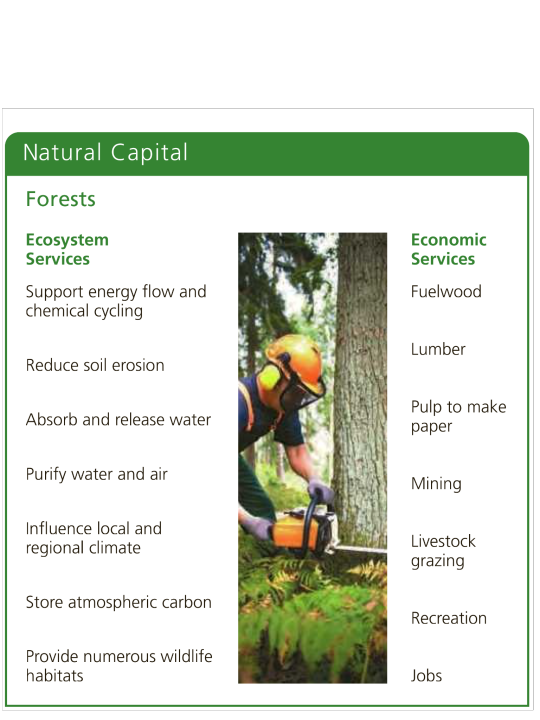
Figure 4. Forests’ important ecosystem and economic services (Miller and Spoolman 2016, 223).
Forests also maintain human health, through supplying blueprints for modern medicine.
Different types of forests exist: old-growth, second-growth and commercial. Old-growth or primary forests are the most biodiverse and natural. Second-growth forests develop after trees have already been removed by human activity. Commercial forests, or tree plantations/farms, are highly managed, highly homogenous, and regularly clear-cut for industrial products. Commercial forests exist mostly for human purpose, and support very little wildlife.
Clear cutting is the least sustainable, yet most cost efficient form of cutting. It can destroy ecosystems through soil erosion and runoff, and contributes to global warming and climate change. More sustainable methods, such as selective cutting and strip cutting leave much of the forest intact, or leave time for regeneration.
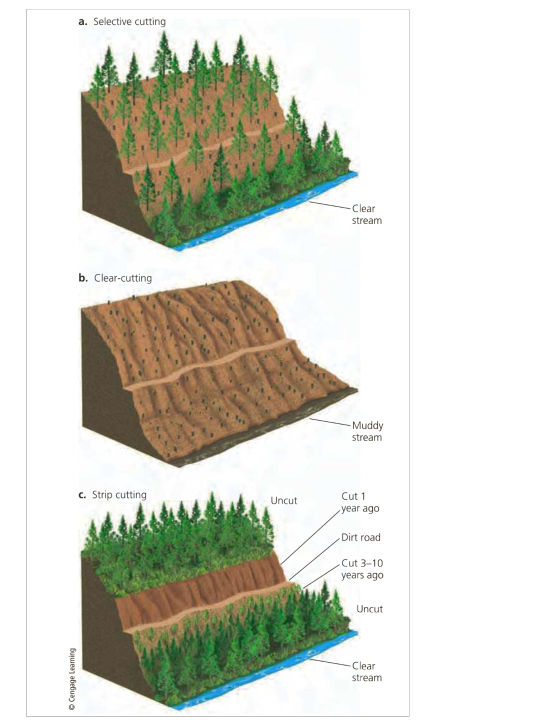
Figure 5. Three Major Ways to Harvest Trees (Miller and Spoolman 2016, 226).
Two types of fires can affect forest ecosystems, and not always in a bad way. Surface fires tend to burn only what lies on the forest floor: dead leaves, seedlings and small trees. Most mature trees survive and most animals escape. Surface fires burn away flammable material which could build up to cause more destruction, provide nutrients trapped in the slowly decomposing floor matter, release seeds, stimulate germination, and help control disease and destructive insects. The other type of fire is a crown fire, which travels at the top of the trees and burns them entirely. Crown fires occur in forests that have not experienced surface fires for too long. Crown fires can become wildfires, and have increasingly in recent years due to climate change. Climate change creates hotter and drier conditions in the forests, which cause longer fire seasons. Humans have also moved to forests, and suppress small fires, which lets debris build up.
Deforestation is major environmental issue, and if we continue on the current path, about 40% of the world’s remaining forests will be converted for human use (agriculture, extraction) in the next two decades. It is necessary that the general public, especially destructive corporations, recognize the long-term harmful environmental effects of deforestation outweigh the short-term economic benefits. This reliance is both economically and environmentally unsustainable.
#HowCanWeManageAndSustainForests?
We can, and should, manage and sustain forests through emphasis on the economic value of their ecosystem services, ending subsidies that expedite their destruction, protection of old-growth forests, sustainable harvesting and planting of trees. A big problem outlined in the book was that of local communities destroying forests, specifically in Haiti (Miller and Spoolman 2016, 234). These communities cut trees down for survival before they are able to grow to maturity. With the population rising, this problem is expected to worsen. However, the book fails to mention that many of these communities are left with no other option for survival. I think that the global community has an obligation to help provide other options to these communities. Additionally, I think by outlining this as a case study, the book underplays the much larger role that developed countries’ demands have on forests.
Our consumption and demand for products from forests play a big role in the destruction of forests. We can use our purchasing power to reduce the demand for such behavior by purchasing alternatives to tree products, such as bamboo or rice based products or FSC certified products. Additionally, to reduce waste, we can try to reuse more durable products in our daily lives.
One solution for more sustainable management of forests is through debt-for-nature swaps, wherein countries protect forest areas in return for foreign aid or debt relief. Likewise, conservation concessions produce similar results, but private organizations pay for the preservation. Governments should also be responsible for outlawing illegal logging and ending subsidies that support such activities. Reforestation also plays a huge role in sustainability by recovering destroyed forests. This was proven in the Green Belt movement in Kenya, which replenished forests and their ecosystem services. As a result, forty other African countries have adopted this method.
#HowCanWeManageAndSustainGrasslands?
By controlling the amount and distribution of grazing livestock and restoring degraded grasslands, we can sustainably manage grasslands (Miller and Spoolman 2016, 237). Grasslands make up ¼ of earth's land surface, and provide many important ecosystem services, which we are responsible for maintaining. Grasslands are a sustainable feeding ground, since they are highly renewable, if only the top parts of the blades are consumed. However, too often these areas are overgrazed to the point where their roots are destroyed. To avoid overgrazing, humans must not exceed the carrying capacity of a given area.
#HowCanWeSustainTerrestrialBiodiversityAndEcosystemServices?
To sustain terrestrial biodiversity and ecosystem services, we should establish and protect wilderness areas, parks, and nature preserves; identify and protect highly threatened biological hotspots; and protect ecosystem services, restore ecosystems and share areas which we currently dominate. Currently only 6% of the land surface is protected from harmful human activity; 94% of the surface has been lent to human use. A big reason any land is protected at all in the United States is thanks to President Theodore Roosevelt, who proposed we leave the earth as we found it. However, as the human population grows, this becomes increasingly difficult as the demand for natural resources to sustain that population increases accordingly. Climate change coincides with these issues and only worsens their consequences. When protecting land, we must ensure that the areas do not become too popular, and therefore destroyed by the human footprint. A major theme throughout these chapters in the idea that though the desire for conservation and preservation are legitimate, the enforcement of such ideas is difficult and ineffective. This is true of buffer zones in nature reserves, wherein people can extract resources from a certain portion of the reserve, without harming the inner core. The inner core grows smaller and smaller as enforcement is lax. In order to protect areas of biodiversity and their services, it is important to recognize other social issues that contribute to the problem, and create societies that value and prioritize the sustainability of the natural world.
Let’s look to Costa Rica as a shining example of sustainability excellence. Though it has experienced immense losses of forest cover, Costa Rica still exists as a biodiversity hub. It’s biodiversity can be attributed to the #blessed geographic location between two oceans with both coastal and mountain regions, and to the government’s conservation commitment. The government has removed harmful subsidies, and instead implements ones which benefit landowners who maintain, restore and manage forests under 10-15 year agreements. Within thirty years, forests came to cover 50% of Costa Rica’s land. Additionally, the government established megareserves, with the goal of sustainability of biodiversity, rather than the goal of sustainability of the human population. Costa Rica does use the buffer zone approach, which has implemented the win-win principle of sustainability, as local communities have been involved with managing reserve areas. This success is due to the strong support and enforcement of the government, and the respect of the land by people who live there. Costa Rica employs young people in the community to play an essential role in the reforestation movement, which is a tool for education and engagement. Though Costa Rica has become an attraction for ecotourism, as with other reserves, their attraction must be balanced, since their priority is sustainability of the natural world.
Word Count: 2430 Words
Question: How can the alternative sustainable options for consumers be made more accessible to all groups?
Works Cited
GeoBeats. “Global Wildlife Population Declined By 50% In Last 40 Years.” n.d. Dailymotion video, 1:29. Posted 2015. https://www.dailymotion.com/video/x26ybub Hodge, Channon. 2019. “Orphaned Elephants Get New Life in Kenya.” Accessed March 5, 2020. https://www.cnn.com/travel/article/elephant-orphanage-nairobi-kenya/index.html Miller, G. Tyler, and Scott E. Spoolman. 2016. Living in the Environment: Nineteenth Edition, 193-249. Canada: Cengage Learning. Ronson, Jaqueline. 2016. “'BLACK MIRROR' KILLER BEE DRONES ARE COMING FOR YOU IRL.” Accessed March 5, 2020. https://www.inverse.com/article/22678-black-mirror-robot-bee-drones
0 notes
Text
Assignment 6 Final Draft:How can the responsibility for population control be balanced between more and less developed nations?

Figure 1. “Depicts 320,000 light bulbs, equal to the number of kilowatt hours of electricity wasted in the United States every minute from inefficient residential electricity usage (inefficient wiring, computers in sleep mode, etc.)” (Jordan 2008a).
“Either we limit our population growth or the natural world will do it for us” -Sir David Attenborough (Miller and Spoolman 2016, 119). Maybe the coronavirus is nature’s cry for help...
The world population is approaching 8 billion people (Worldometer 2020). As the population grows, we use more of the earth’s natural resources, our ecological footprints expand and degrade the natural capital that keeps us alive and supports our lifestyles and economies. Three major factors contributed to our oversized population:
Emergence of early and modern agriculture which increased food production
Additional tech helped humans expand into almost all of the world’s climate zones and habitats
Death rates dropped sharply with improved sanitation and health care (antibiotics and vaccines)
It’s unclear how many people the earth can sustain, but there has been rapid population growth in the past 200 years. The world’s population is unevenly distributed between the global north and south, with less-developed nations containing more people. The current view is that we have already exceeded some of the limits of population growth. This is clear in our extreme degradation of the environment.

Figure 2. “Depicts 28,000 42-gallon barrels, the amount of oil consumed in the United States every two minutes (equal to the flow of a medium-sized river)” … “Statistics can feel abstract and anesthetizing, making it difficult to connect with and make meaning” (Jordan 2008b). Chris Jordan has an interesting and effective approach to making meaning out of numbers.
However, our economic view has not come to agree with this. Our unnatural appetite for endless growth is insatiable. The economy cannot grow forever (New Economics Foundation 2020). This growth-based economy does not even prioritize human quality of life for most people. Instead, it relies on the efficiency of workers as cogs in the corporate machine to benefit the top 1%. If society focused on having a more meaningful life, our value systems would be altered (Koehler 2008). We need to invest in social and natural capital rather than just financial capital. We can follow the Netherlands in their Plenitude economy which focuses on well-being rather than efficiency and expansion. This model suggests we hire more workers who work less to increase the number of people in the workforce along with free time of those workers. Our current model does not support this type of change due to the increasing operational costs of labor (New Dream 2011). The Steady-state model, however, would support this type of change. This model suggests we halt the growth of wealth, population and therefore the economy. It was applied to ecological economics by Herman Daly, who recommended government regulate and implement this mode of economics. Measures already exist which lean towards this model, such as the limiting of consumption through plastic bag bans. A movement which represents the promotion of these types of economies is the Degrowth movement of the 1970s. Their 3 main goals were to:
Reduce the environmental impact of human activity
Redistribute income and wealth both within and between countries
Promote the transition from a materialistic to a convivial and participatory society.
The movement saw the model of sustainable development as an oxymoron, as any form of development was seen as unsustainable (Wikipedia, n.d.A).
The plenitude economy, steady state economy and degrowth movement prioritize the average individual rather than potential stakeholders, and we should use our voting power to vote people into office who advocate for our quality of life.
Educating and Empowering Women to Decrease Population Size
A key factor affecting birth and death rates is the average number of children born to women within a population. There are two types of fertility rates: replacement-level and total. Replacement-level is the average number of children that couples in a population must bear to replace themselves (2.1 children). Total Fertility rate (TFR) is the average number of children born to the childbearing population. TFR must equal replacement-level consistently to halt population growth.
The US population is third largest at over 329,000,000 and still growing due to baby boomers and longer life expectancy, immigration (legal and illegal). There is a net gain of one person every 24 seconds due to one birth every 9 seconds, one death every 11 seconds, and one international migrant every 44 seconds (United States Census Bureau 2020). Immigration has made this country more culturally diverse, which increases economic growth as these people work and start businesses. Migration is also a key factor affecting population, but discouraging immigration is not an adequate solution to the population issue.
The more adequate solutions are through reducing poverty through economic development, elevating the status of women and encouraging family planning. Women tend to have fewer children if they are educated, can control their own fertility, earn an income of their own and live in societies that don’t suppress girls and women. Currently, only about 30% of the world’s girls are enrolled in secondary education. Poor women who cannot read often have an avg of 5-7 children, compared with 2 or fewer children in societies where most women can read. This statistic outlines the global need for all children (regardless of gender) to get at least an elementary school education. As women in less-developed nations take charge of their lives and reproduction, populations will stabilize, human health will be improved, poverty and environmental degradation will be reduced and there will be more access to basic human rights.
In addition to educating women on a basic level, family planning can also aid in lowering TFR. Family planning provides education and clinical services that can help couples choose how many children to have and when to have them. Each dollar spent on family planning saves $10-$16 in health, education and social service costs by preventing unwanted birth. However, in many cultures, males dominate impoverished societies, which leads to early marriage of ⅓ of girls.
Women should be given the tools to limit family size such as access to education and birth control (and contraception), however I do not believe anyone has the right to tell a woman whether or not she can have children. It is important that children are not the only option made available.
Green Cities
Populations are especially dense in cities. More than half of the world’s population resides in urban areas. 3 major trends of urbanization include:
The percentage of urban global population has grown sharply and projected to continue growing
Then numbers and sizes of urban areas are increasing
Poverty is increasingly urbanized, mostly in less developed countries
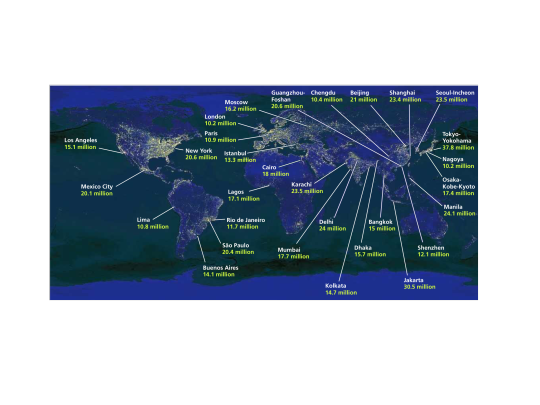
Figure 3. Megacities with 10 million or more people (Miller and Spoolman 2016, 606).
Concentrating people in cities has helped protect biodiversity by reducing destruction and degradation of wildlife habitat. However, older cities have deteriorating services, aging infrastructure and carry beyond their intended capacity. Additionally urban sprawl – the growth of low-density development on the outskirts of cities and towns –has allowed people to live near, but not in cities. This lifestyle degrades natural habitats and forces people to drive almost everywhere. Dependence on motor vehicles for transportation results in high emissions, which contribute to climate change. Some solutions to discourage use of cars have been full-cost pricing of gasoline, tolls, and car sharing initiatives. Mayor Bloomberg tried to implement congestion pricing (a fee on cars entering Manhattan during peak hours) as part of PlaNYC, but it was cancelled due to many complaints from commuters. Additionally, it was criticized because the underlying assumption that people could use mass transit was incorrect; many subways were used to full capacity, and the tracks allowed no more room to add trains (Wikipedia. n.d.B).
The major urban resource and environmental problems in cities include high levels of resource use, waste, pollution and poverty. It is increasingly difficult to maintain sustainability in the face of growing population and higher resource use per person (large ecological footprints).
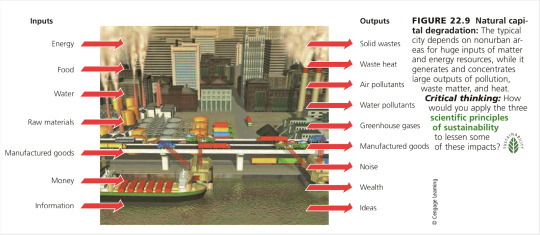
Figure 4. Natural Capital Degradation. (Miller and Spoolman 2016, 610).
People living in cities lack vegetation and green space, and don’t benefit from their ecosystem services (air purification, generation of oxygen, removal of atmospheric CO2, control of soil erosion and wildlife habitat). Pollution can be attributed due to the density and number of people found in cities. Poverty is also common, and impoverished city dwellers are subject to severe air and water pollution. A solution to poverty in Brazil and Peru was legal recognition and titles to land. This applied permanence has allowed impoverished groups to improve their living conditions and eventually become productive working citizens who contributed to tax revenues which pay for government programs which can assist the poor. I would argue, however, this is based on the assumption that all people in poverty have a desire to contribute to a system that has failed to serve them, which I’m not sure is entirely accurate.
Cities can become more sustainable and livable through citywide initiatives and lifestyle changes. If people chose alternative modes of transport, recycled or reused most waste, grew much of their food, protected biodiversity by preserving surrounding land, and generated carbon-neutral energy, we would be on a sustainable track. Cities should exist for people, not cars, and environmental justice must be considered through any sustainability initiative.
I believe cities have the potential to exist as sustainability hubs, due to city dwellers’ lack of reliance on cars. However, they should not be the only places where sustainability and sustainable business is supported. We need to balance the avoidance of urban sprawl with the fact that while people don’t want to live in cities, they tend to be the epicenters of success and flourishing economies.
The question of how social change occurs still remains. If we rely on the government too highly, we may end up with plans that don’t accurately address the problem. On the other hand, relying on grassroots community movements, like Transition Towns, put a large amount of ownness on individual action and self-sufficiency that this economy and society does not support (Wikipedia. n.d.C). The balance of both government and individual action is essential in this movement. Additionally, the global north needs to decrease the size of their carbon footprint, and give back to the communities we have drained of resources for too long.

Figure 5. “Depicts 92,500 agricultural plant seeds, equal to one hundredth of one percent of the number of people in the world today who suffer from malnutrition. To illustrate the entire statistic with 925 million seeds would require ten thousand prints of this image, covering more than eight football fields.” (Jordan, 2011).
Word Count: 2,200 words
Question: Do more-developed countries have a responsibility to aid sustainable development in less-developed countries? How can they balance doing so with the history of colonization?
Works Cited
Jordan, Chris. “Light Bulbs.” 2008. Running The Numbers: An American Self-Portrait. Online Collection. http://www.chrisjordan.com/gallery/rtn/#light-bulbs.
Jordan, Chris. “Oil Barrels.” 2008. Running The Numbers: An American Self-Portrait. Online Collection. http://www.chrisjordan.com/gallery/rtn/#oil-barrels.
Jordan, Chris. “Stone of The Sun.” 2011. Running the Numbers II: Portraits of Global Mass Culture. Online Collection. http://www.chrisjordan.com/gallery/rtn2/#maya.
Koehler, Berrett. “More than Money- What is ‘The Good Life’ Parable.” YouTube video, 3:05. Posted August 2008. https://www.youtube.com/watch?v=k7JlI959slY.
Miller, G. Tyler, and Scott E. Spoolman. 2016. Living in the Environment: Nineteenth Edition, 119-616. Canada: Cengage Learning.
New Dream. “Visualizing a Plenitude Economy.” YouTube video, 4:51. Posted September 2011. https://www.youtube.com/watch?feature=player_embedded&v=HR-YrD_KB0M.
New Economics Foundation. 2010. “The Impossible Hamster.” Vimeo video, 1:10. Posted January 2010. https://vimeo.com/8947526.
United States Census Bureau. 2020. “U.S. and World Population Clock.” Accessed February 26, 2020. https://www.census.gov/popclock/.
Worldometer. 2020. “World Population.” Accessed February 26, 2020. https://www.worldometers.info/world-population/.
Wikipedia. n.d. “Degrowth.” Last modified February 17, 2020. https://en.wikipedia.org/wiki/Degrowth.
Wikipedia. n.d. “PlaNYC.” Last modified November 1, 2019. https://en.wikipedia.org/wiki/PlaNYC
Wikipedia. n.d. “Transition Town.” Last modified December 14, 2019. https://en.wikipedia.org/wiki/Transition_town
0 notes
Text
Assignment 6 First Draft: How can the responsibility for population control be balanced between more and less developed nations?

Figure 1. “Depicts 320,000 light bulbs, equal to the number of kilowatt hours of electricity wasted in the United States every minute from inefficient residential electricity usage (inefficient wiring, computers in sleep mode, etc.)” (Jordan 2008a).
“Either we limit our population growth or the natural world will do it for us” -Sir David Attenborough (Miller and Spoolman 2016, 119).
The world population is approaching 8 billion people (Worldometer 2020). As the population grows, we use more of the earth’s natural resources, our ecological footprints expand and degrade the natural capital that keeps us alive and supports our lifestyles and economies. Three major factors contributed to our oversized population:
Emergence of early and modern agriculture which increased food production
Additional tech helped humans expand into almost all of the world’s climate zones and habitats
Death rates dropped sharply with improved sanitation and health care (antibiotics and vaccines)
It’s unclear how many people the earth can sustain, but there has been rapid population growth in the past 200 years. The world’s population is unevenly distributed between the global north and south, with less-developed nations containing more people. The current view is that we have already exceeded some of the limits of population growth.

Figure 2. “Depicts 28,000 42-gallon barrels, the amount of oil consumed in the United States every two minutes (equal to the flow of a medium-sized river)” ... “Statistics can feel abstract and anesthetizing, making it difficult to connect with and make meaning” (Jordan 2008b)
However, our economic view has not come to agree with this. Our unnatural appetite for endless growth is insatiable. The economy cannot grow forever (New Economics Foundation 2020). This growth-based economy does not even prioritize human quality of life for most people. Instead, it relies on the efficiency of workers as cogs in the corporate machine to benefit the top 1%. If society focused on having a more meaningful life, our value systems would be altered (Koehler 2008). We need to invest in social and natural capital rather than just financial capital. We can follow the Netherlands in their Plenitude economy which focuses on well-being rather than efficiency and expansion. This model suggests we hire more workers who work less to increase the number of people in the workforce along with free time of those workers. Our current model does not support this type of change due to the increasing operational costs of labor (New Dream 2011). The Steady-state model, however, would support this type of change. This model suggests we halt the growth of wealth, population and therefore the economy. It was applied to ecological economics by Herman Daly, who recommended government regulate and implement this mode of economics. Measures already exist which lean towards this model, such as the limiting of consumption through plastic bag bans. A movement which represents the promotion of these types of economies is the Degrowth movement of the 1970s. Their 3 main goals were to:
Reduce the environmental impact of human activity
Redistribute income and wealth both within and between countries
Promote the transition from a materialistic to a convivial and participatory society.
The movement was a bit extreme and saw the model of sustainable development as an oxymoron, as any form of development was seen as unsustainable (Wikipedia, n.d.A).
Educating and Empowering Women to Decrease Population Size
A key factor affecting birth and death rates is the average number of children born to women within a population. There are two types of fertility rates: replacement-level and total. Replacement-level is the average number of children that couples in a population must bear to replace themselves (2.1 children). Total Fertility rate (TFR) is the average number of children born to the childbearing population. TFR must equal replacement-level consistently to halt population growth.
The US population is third largest at over 329,000,000 and still growing due to baby boomers and longer life expectancy, immigration (legal and illegal). There is a net gain of one person every 24 seconds due to one birth every 9 seconds, one death every 11 seconds, and one international migrant every 44 seconds (United States Census Bureau 2020). Immigration has made this country more culturally diverse, which increases economic growth as these people work and start businesses. Migration is also a key factor affecting population, but discouraging immigration is not an adequate solution to the population issue.
The more adequate solutions are through reducing poverty through economic development, elevating the status of women and encouraging family planning. Women tend to have fewer children if they are educated, can control their own fertility, earn an income of their own and live in societies that don’t suppress girls and women. Currently, only about 30% of the world’s girls are enrolled in secondary education. Poor women who cannot read often have an avg of 5-7 children, compared with 2 or fewer children in societies where most women can read. This statistic outlines the global need for all children (regardless of gender) to get at least an elementary school education. As women in less-developed nations take charge of their lives and reproduction, populations will stabilize, human health will be improved, poverty and environmental degradation will be reduced and there will be more access to basic human rights.
In addition to educating women on a basic level, family planning can also aid in lowering TFR. Family planning provides education and clinical services that can help couples choose how many children to have and when to have them. Each dollar spent on family planning saves $10-$16 in health, education and social service costs by preventing unwanted birth. However, in many cultures, males dominate impoverished societies, which leads to early marriage of ⅓ of girls.
Women should be given the tools to limit family size such as access to education and birth control, however I do not believe anyone has the right to tell a woman whether or not she can have children. It is important that children are not the only option made available.
Green Cities
Populations are especially dense in cities. More than half of the world’s population resides in urban areas. 3 major trends of urbanization include:
The percentage of urban global population has grown sharply and projected to continue growing
Then numbers and sizes of urban areas are increasing
Poverty is increasingly urbanized, mostly in less developed countries

Figure 3. Megacities with 10 million or more people (Miller and Spoolman 2016, 606).
Concentrating people in cities has helped protect biodiversity by reducing destruction and degradation of wildlife habitat. However, older cities have deteriorating services, aging infrastructure and carry beyond their intended capacity. Additionally urban sprawl – the growth of low-density development on the outskirts of cities and towns –has allowed people to live near, but not in cities. This lifestyle degrades natural habitats and forces people to drive almost everywhere. Dependence on motor vehicles for transportation results in high emissions, which contribute to climate change. Some solutions to discourage use of cars have been full-cost pricing of gasoline, tolls, and car sharing initiatives. Mayor Bloomberg tried to implement congestion pricing (a fee on cars entering Manhattan during peak hours), but it was cancelled due to many complaints from commuters. Additionally, it was criticised because the underlying assumption that people could use mass transit was incorrect; many subways were used to full capacity, and the tracks allowed no more room to add trains (Wikipedia. n.d.B).
The major urban resource and environmental problems in cities include high levels of resource use, waste, pollution and poverty. It is increasingly difficult to maintain sustainability in the face of growing population and higher resource use per person (large ecological footprints).

Figure 4. Natural Capital Degradation. (Miller and Spoolman 2016, 610).
People living in cities lack vegetation and green space, and don’t benefit from their ecosystem services (air purification, generation of oxygen, removal of atmospheric CO2, control of soil erosion and wildlife habitat). Pollution can be attributed due to the density and number of people found in cities. Poverty is also common, and impoverished city dwellers a subject to severe air and water pollution. A solution to poverty in Brazil and Peru was legal recognition and titles to land. This applied permanence, which allowed impoverished groups to improve their living conditions and eventually become productive working citizens who contributed to tax revenues which pay for government programs which can assist the poor. I would argue, however, this is based on the assumption that all people in poverty have a desire to contribute to a system that has failed to serve them, which I’m not sure is entirely accurate.
Cities can become more sustainable and livable through citywide initiatives and lifestyle changes. If people chose alternative modes of transport, recycled or reused most waste, grew much of their food, protected biodiversity by preserving surrounding land, and generated carbon-neutral energy, we would be on a sustainable track. Cities should exist for people, not cars, and environmental justice must be considered through any sustainability initiative.
The question of how social change occurs still remains. If we rely on the government too highly, we may end up with plans that don’t accurately address the problem. On the other hand, relying on grassroots community movements, like Transition Towns, put a large amount of ownness on individual action and self-sufficiency that this economy and society does not support (Wikipedia. n.d.C). The balance of both government and individual action is essential in this movement. Additionally, the global north needs to decrease the size of their carbon footprint, and give back to the communities we have drained of resources for too long.

Figure 5. “Depicts 92,500 agricultural plant seeds, equal to one hundredth of one percent of the number of people in the world today who suffer from malnutrition. To illustrate the entire statistic with 925 million seeds would require ten thousand prints of this image, covering more than eight football fields.” (Jordan, 2011).
Word Count: 1,429 words
Question: Do more-developed countries have a responsibility to aid sustainable development in less-developed countries? How can they balance doing so with the history of colonization?
Works Cited
Jordan, Chris. “Light Bulbs.” 2008. Running The Numbers: An American Self-Portrait. Online Collection. http://www.chrisjordan.com/gallery/rtn/#light-bulbs.
Jordan, Chris. “Oil Barrels.” 2008. Running The Numbers: An American Self-Portrait. Online Collection. http://www.chrisjordan.com/gallery/rtn/#oil-barrels.
Jordan, Chris. “Stone of The Sun.” 2011. Running the Numbers II: Portraits of Global Mass Culture. Online Collection. http://www.chrisjordan.com/gallery/rtn2/#maya.
Koehler, Berrett. “More than Money- What is ‘The Good Life’ Parable.” YouTube video, 3:05. Posted August 2008. https://www.youtube.com/watch?v=k7JlI959slY.
Miller, G. Tyler, and Scott E. Spoolman. 2016. Living in the Environment: Nineteenth Edition, 119-616. Canada: Cengage Learning.
New Dream. “Visualizing a Plenitude Economy.” YouTube video, 4:51. Posted September 2011. https://www.youtube.com/watch?feature=player_embedded&v=HR-YrD_KB0M.
New Economics Foundation. 2010. “The Impossible Hamster.” Vimeo video, 1:10. Posted January 2010. https://vimeo.com/8947526.
United States Census Bureau. 2020. “U.S. and World Population Clock.” Accessed February 26, 2020. https://www.census.gov/popclock/.
Worldometer. 2020. “World Population.” Accessed February 26, 2020. https://www.worldometers.info/world-population/.
Wikipedia. n.d. “Degrowth.” Last modified February 17, 2020. https://en.wikipedia.org/wiki/Degrowth.
Wikipedia. n.d. “PlaNYC.” Last modified November 1, 2019. https://en.wikipedia.org/wiki/PlaNYC
Wikipedia. n.d. “Transition Town.” Last modified December 14, 2019. https://en.wikipedia.org/wiki/Transition_town
0 notes
Text
Assignment 5 Final Draft: How and Why Should We Change Economic and Environmental Policy?

Figure 1. Tweet by Governor Jay Inslee (@JayInslee, January 30, 2020).
#HowAreEconomicSystemsRelatedToTheBiosphere?
Economic systems are subsystems of the biosphere which rely on natural resources and ecosystem services, according to ecological economists.
#HowCanWeEstimateTheValuesOfNaturalCapitalPollutionControlAndResourceUse?
The value of the biosphere and its services is estimated at “US$16–54 trillion per year, with an average of US$33 trillion per year” (Costanza et. al 1997, 1). This value, which fluctuates with environmental conditions, is up to 3x global GNP. However, since nature is not considered in economic terms, it has little weight in policy decisions. In truth, “the economies of the Earth would grind to a halt without the services of ecological life-support systems, so in one sense their total value to the economy is infinite” (Costanza et.al 1997, 1). One way to value such services is to calculate the cost of the research and technology necessary to replace the services which we already get for free.
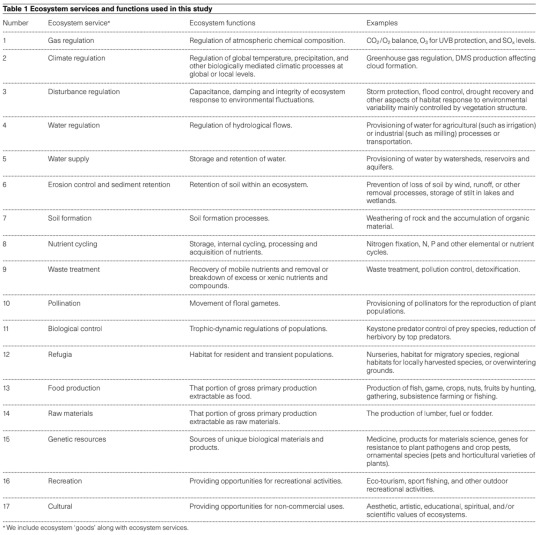
Figure 2. Ecosystem Services (Table 1). (Costanza et. al 1997, 3).
#HowCanWeUseEconomicToolsToDealWithEnvironmentalProblems?
Economics can help with environmental issues through full-cost pricing: including hidden costs (harm to the environment and human health). These costs must be calculated into the consumer price for the transition to a sustainable economy. Business needs to model nature, and economic succession will occur; some industries and businesses will not survive the transition, but new business will appear, which is normal in a capitalist economy. An obstacle to this process is politics and industry corruption. Many harmful businesses have used their power to gain unfair subsidies and tax breaks.
Subsidies can also be beneficial. For example, they could be given to companies who are actively involved in innovation measures to protect the environment. Additionally, green taxes could be taken based on the amount of pollution or waste produced from an industry. This would incentivize business to behave responsibly.

Figure 3. Green Taxes. (Miller and Spoolman 2016, 641).
#HowCanReducingPovertyHelpUsToDealWithEnvironmentalProblems?
Reducing poverty reduces population growth, and therefore resource use and environmental degradation.
Governments, businesses, international lending agencies and wealthy individuals to help reduce poverty by (Miller and Spoolman 2016, 644):
Engaging in a global effort to end malnutrition and infectious diseases
Providing universal primary school education
Giving assistance to developing countries to reduce population growth (family planning and elevation of socioeconomic status of women)
Focusing on reducing carbon footprints
Making investments in infrastructure for sustainable development
Encouraging lending agencies to engage in microlending with poorer clients who want to increase their income
Microfinance would be most efficient if investments were socially implemented into hospitals, schools, and movements which empower communities.
#HowCanWeMakeTheTransitionToMoreEnvironmentallySustainableEconomies?
The current economic system, based on the measure of GDP, ignores environmental impact. A country with a high GDP is considered powerful, but how can a powerful country be one where people and ecosystems suffer? A new scale is necessary for accurate success to be measured, which includes environmental factors. Our priorities for success and survival need to change. A more environmentally sustainable economic system would lower taxes on labor, income and wealth, and raise taxes on environmentally harmful activities. The best long-term solution is a shift from a high to low waste economy.
#WhatIsTheRoleOfTheGovernmentInMakingTheTransitionToMoreSustainableSocieties?
Through policy, government can protect environmental interests and encourage sustainable economic development. The perfect balance between regulation and the free market is difficult; too little can lead to degradation and injustice, and too much can halt innovation.
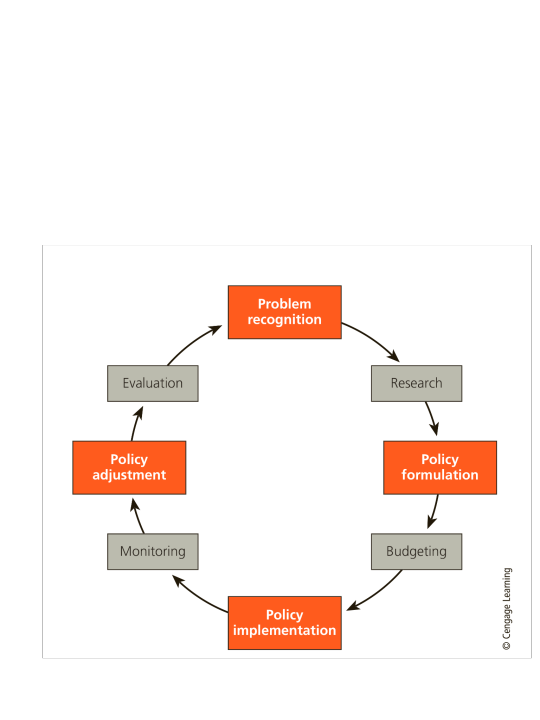
Figure 4. The Policy Life Cycle. (Miller and Spoolman 2016, 658).
#HowIsEnvironmentalPolicyMade?
In the United States, policies are made through enacting laws, funding programs, and writing and enforcing rules with government oversight. Fundamentally, all politics is local. What we do in our local communities provides an example of what we want the world to look like.

Figure 5. Influencing Environmental Policy. (Miller and Spoolman 2016, 663).
The United States is increasingly behaving as a marketplace rather than a community. This is reflected in our politics; we are treated as groups of consumer preferences rather than citizens. According to Ernest Partridge, our leaders– the top 1%– are considered “the oligarchy.” Their ideal citizen is a “worker who produces wealth efficiently, consumes and wastes thoughtlessly and lavishly, and willingly turns over the product of his labor to the oligarchs” (Partridge, 2002). Their citizens are consumers; they are valued in proportion to their wealth.
If we want policy by the people for the people, we must work to restore democracy through the reintroduction of civic education (formal and informal), the breakup of media conglomerates, the restoration of the “fairness doctrine,” and a thorough enactment of campaign reform.
#WhatIsTheRoleOfEnvironmentalLawInDealingWithEnvironmentalProblems?
Environmental law has provided legal protection to the environment since the 1960s. Principles of environmental law include sustainable development, equity, transboundary responsibility, public participation and transparency, precautionary principle, prevention, and the polluter pay principle (Wikipedia, n.d.).
Environmental law is controversial due to the controversy around environmental regulation. Corporations often intentionally hide or distort facts to provoke public confusion. This can be blamed on the cost of regulation and transition to responsible practice.
There are five main types of environmental law which:
Require evaluation of the impacts of certain human activities
Set standards for pollution levels
Set aside/protect certain species, resources, and ecosystems
Screen new substances for safety and set standards
Encourage resource conservation
#WhatAreTheMajorRolesOfEnvironmentalGroups?
Environmental groups believe the current regulation is inadequate to combat injustice and work for “bottom-up political, social, economic and environmental change” (Miller and Spoolman 2016, 669).
#HowCanWeImproveGlobalEnvironmentalSecurity?
“Environmental security is necessary for economic security and is at least as important as national security” (Miller and Spoolman 2016, 671). Without natural capital, human economy would decline and society would collapse.
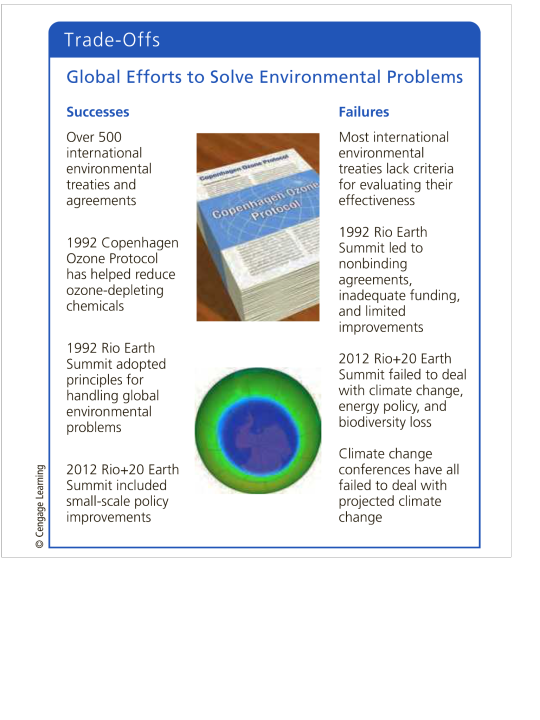
Figure 6. Global Efforts to Solve Environmental Problems. (Miller and Spoolman 2016, 674).
To ensure environmental security, government and business must work together. The transition to a sustainable society requires a large amount of investment capital from profitable corporations. Sustainable (green) business is a fast growing sector and job creator. A sustainable business has minimal negative impact, or a potentially positive effect on the global or local environment, community, society or economy. It strives to meet the triple bottom line: people, planet and profit. “For a business to be truly sustainable, it must sustain not only the necessary environmental resources, but also social resources—including employees, customers (the community), and its reputation” (Wikipedia, n.d.). Corporate Sustainability is achieved through innovation, collaboration, process improvement, sustainability reporting, and greening the supply chain. As environmental awareness grows, a positive correlation exists between environmental and economic performance.
#HowCanWeImplementMoreSustainableAndJustEnvironmentalPolicies?
We should model the Netherlands, Germany and Ecuador. 25 years ago, the Netherlands implemented their green plan called The National Environmental Policy Plan. It sets clear goals for the decline of unsustainable resource use and enforces those goals through a task force of people in industry, government and citizen groups. It “has led to the expansion of organic agriculture, greater reliance on bicycles and more ecologically sound housing developments” (Miller and Spoolman 2016, 675). Germany uses feed-in-tariffs to incentivize renewable energy production. This system has allowed for sustainable growth of renewable energy independent of the market economy (Miller and Spoolman 2016, 630). In Ecuador, rights were given to nature as a result of political, economic and social factors. Ecuador's experience with Chevron oil extraction and the failure of that extraction-based economy led to neoliberal reforms and the election of President Rafael Correa. Correa implemented “Buen Vivir,” which means good living focused on social, environmental, and spiritual wealth. This idea had strong indigenous influence (Wikipedia, n.d.). Though these countries set models for how the world should respond to the crisis we face, the law needs to be coherent and consistent among nations to avoid exploitation globally.
From these readings, it becomes increasingly clear that economics and environmental policy must work hand in hand to drive widespread environmental change.
Word Count: ~1190 words
Question: Is there a body that exists currently that can enforce global environmental law?
Works Cited
Costanza, Robert et. al. 1997. “The Value of the World’s Ecosystem Services and Natural Capital.” Nature, May 15, 1997.
https://drive.google.com/file/d/0BzKbjVLpnX0RRERLVGVvV2dZSWM/view
Inslee, Jay (@JayInslee). 2020. “‘Like the effects of global warming, the economic case for addressing climate change should become increasingly obvious.’ Exactly. When we act on climate change, we’re acting to protect our environment, ourselves, and our economy.” Tweet, January 30, 2020. https://twitter.com/jayinslee/status/1222931892690800641?s=11
Miller, G. Tyler, and Scott E. Spoolman. 2016. Living in the Environment: Nineteenth Edition, 680-698. Canada: Cengage Learning.
Partridge, Ernest. 2002. “Consumer or Citizen?” Accessed February 20, 2020.
http://gadfly.igc.org/politics/left/consumer.htm
Wikipedia. n.d. “Environmental Law.” Last modified February 19, 2020. Accessed February 20, 2020. https://en.wikipedia.org/wiki/Environmental_law
Wikipedia. n.d. “Sustainable Business.” Last modified on January 10, 2020. Accessed February 20, 2020. https://en.wikipedia.org/wiki/Sustainable_business
0 notes
Text
Assignment 5 First Draft: How and Why Should we Change Economic and Environmental Policy?

(@JayInslee, January 30, 2020).
#HowAreEconomicSystemsRelatedToTheBiosphere?
Economic systems are subsystems of the biosphere which rely on natural resources and ecosystem services.
#HowCanWeEstimateTheValuesOfNaturalCapitalPollutionControlAndResourceUse?
The value of the biosphere and its services is estimated at “US$16–54 trillion per year, with an average of US$33 trillion per year” (Costanza et. al 1997, 1). This value, which fluctuates with environmental conditions, is up to 3x global GNP. However, since nature is not traditionally considered in economic terms, it has little weight in policy decisions. In truth, “the economies of the Earth would grind to a halt without the services of ecological life-support systems, so in one sense their total value to the economy is infinite” (Costanza et.al 1997, 1). One way to value such services is to calculate the cost of the research and technology necessary to replace the services which we already get for free.
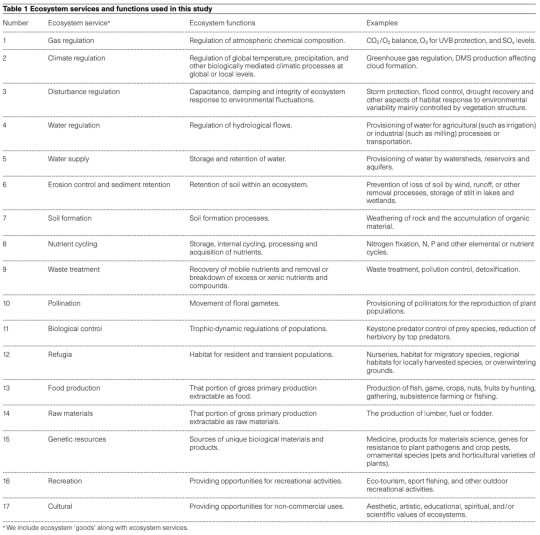
Figure 1. Ecosystem Services (Table 1). (Costanza et. al 1997, 3).
#HowCanWeUseEconomicToolsToDealWithEnvironmentalProblems?
Economics can help with environmental issues through full-cost pricing, including hidden costs (harm to the environment and human health). These costs must be calculated into the consumer price for the transition to a sustainable economy. This is easier said than done. Business needs to model nature, and economic succession will occur; some industries and businesses will not survive the transition. But new business will appear, which is normal in a capitalist economy. An obstacle to this process is politics and industry corruption. Many harmful businesses have used their power to gain unfair subsidies and tax breaks.
Subsidies can also be beneficial. For example, they could be given to companies who are actively involved in innovation measures to protect the environment. Additionally, green taxes could be taken based on the amount of pollution or waste produced from an industry. This would incentivize business to behave responsibly.

Figure 2. Green Taxes. (Miller and Spoolman 2016, 641).
#HowCanReducingPovertyHelpUsToDealWithEnvironmentalProblems?
Reducing poverty reduces population growth, and therefore resource use and environmental degradation.
Governments, businesses, international lending agencies and wealthy individuals to help reduce poverty by (Miller and Spoolman 2016, 644):
Engaging in a global effort to end malnutrition and infectious diseases
Providing universal primary school education
Giving assistance to developing countries to reduce population growth (family planning and elevation of socioeconomic status of women)
Focusing on reducing carbon footprints
Making investments in infrastructure for sustainable development
Encouraging lending agencies to engage in microlending with poorer clients who want to increase their income
#HowCanWeMakeTheTransitionToMoreEnvironmentallySustainableEconomies?
The current economic system, based on the measure of GDP, ignores environmental impact. A country with a high GDP is considered powerful, but how can a powerful country be one where people and ecosystems suffer? A new scale is necessary for accurate success to be measured, which includes environmental factors. Our priorities for success and survival need to change. A more environmentally sustainable economic system would lower taxes on labor, income and wealth, and raise taxes on environmentally harmful activities. The best long-term solution is a shift from a high to low waste economy.
#WhatIsTheRoleOfTheGovernmentInMakingTheTransitionToMoreSustainableSocieties?
Through policy, government can protect environmental interests and encourage sustainable economic development. The perfect balance between regulation and the free market is difficult; too little can lead to degradation and injustice, and too much can halt innovation. Alongside government, business can serve the environmental and public interest. Sustainable (green) business is a fast growing sector and job creator.
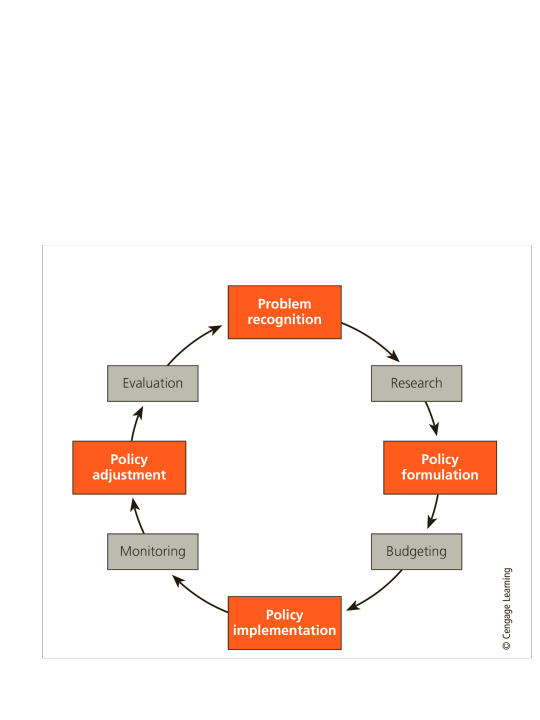
Figure 3. The Policy Life Cycle. (Miller and Spoolman 2016, 658).
#HowIsEnvironmentalPolicyMade?
In the United States, policies are made through enacting laws, funding programs, and writing and enforcing rules with government oversight.
Figure 24.5. How individuals, companies and environmental organizations interact with the branches of the U.S. Government to form environmental policy. (Miller and Spoolman 2016, 660).
Fundamentally, all politics is local. What we do in our local communities provides an example of what we want the world to look like.
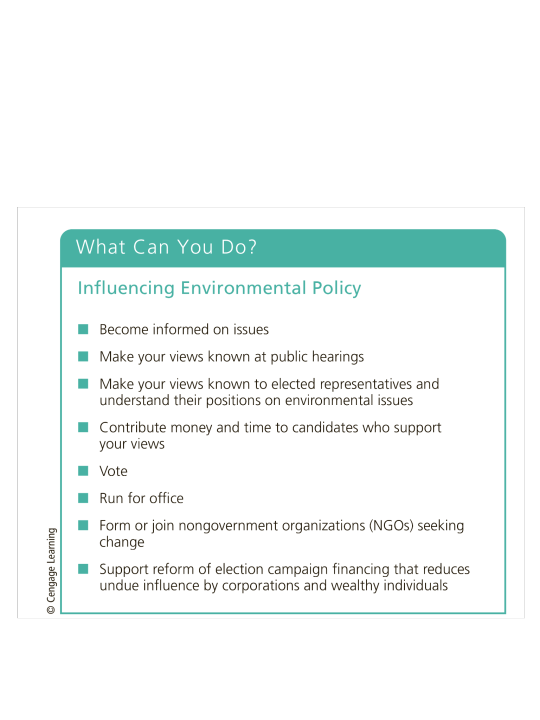
Figure 4. Influencing Environmental Policy. (Miller and Spoolman 2016, 663).
The United States is increasingly behaving as a marketplace rather than a community. This is reflected in our politics; we are treated as groups of consumer preferences rather than citizens. According to Ernest Partridge, our leaders– the top 1%– are considered “the oligarchy.” Their ideal citizen is a “worker who produces wealth efficiently, consumes and wastes thoughtlessly and lavishly, and willingly turns over the product of his labor to the oligarchs” (Partridge, 2002). Their citizens are consumers; they are not created equal and are valued in proportion to their wealth.
If we want policy by the people for the people, we must work to restore democracy through the reintroduction of civic education (formal and informal), the breakup of media conglomerates, the restoration of the “fairness doctrine,” and a thorough enactment of campaign reform.
#WhatIsTheRoleOfEnvironmentalLawInDealingWithEnvironmentalProblems?
Environmental law provides legal protection to the environment. Its strong influence on natural resource laws occured in the 1960s. Principles of environmental law include sustainable development, equity, transboundary responsibility, public participation and transparency, precautionary principle, prevention, and the polluter pay principle (Wikipedia, n.d.).
Environmental law is controversial due to the controversy around environmental regulation. Corporations often intentionally hide or distort facts to provoke public confusion. This can be blamed on the cost of regulation and transition to responsible practice.
There are five main types of environmental law which:
Require evaluation of the impacts of certain human activities
Set standards for pollution levels
Set aside/protect certain species, resources, and ecosystems
Screen new substances for safety and set standards
Encourage resource conservation
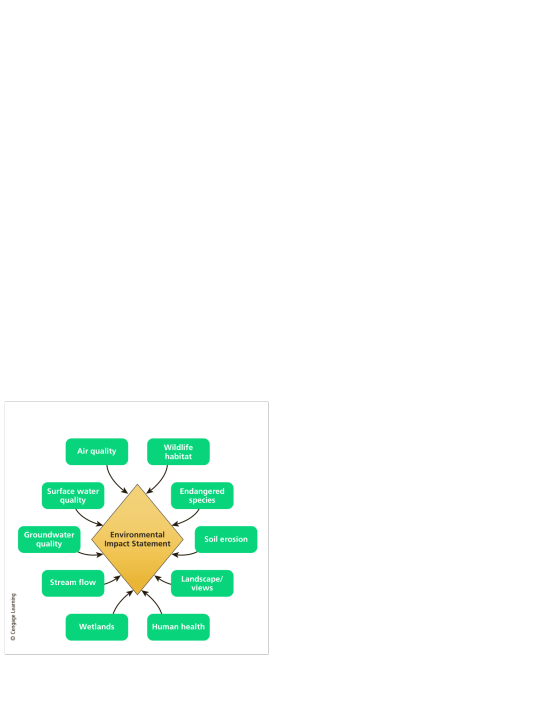
Figure 5. The Environmental Impact Statement “is aimed at minimizing the environmental impact of major projects” (Miller and Spoolman 2016, 666).
#WhatAreTheMajorRolesOfEnvironmentalGroups?
Environmental groups believe the current regulation is inadequate to combat injustice. These groups work for “bottom-up political, social, economic and environmental change” (Miller and Spoolman 2016, 669).
#HowCanWeImproveGlobalEnvironmentalSecurity?
“Environmental security is necessary for economic security and is at least as important as national security” (Miller and Spoolman 2016, 671). Without natural capital, human economy would decline and society would collapse.
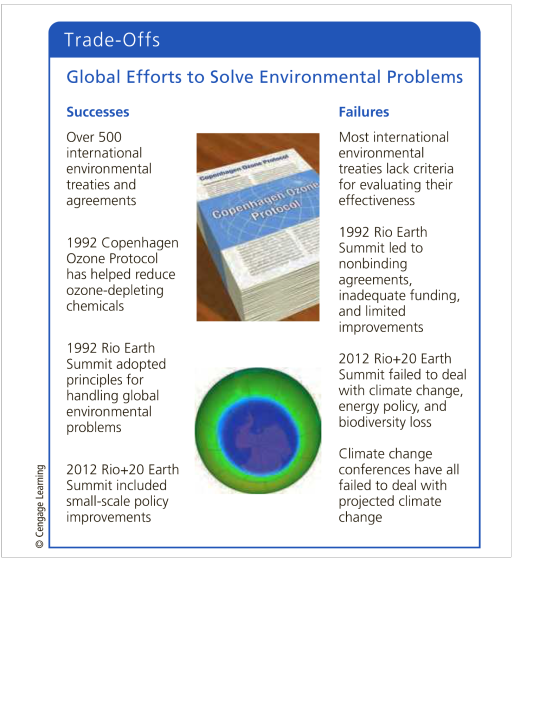
Figure 6. Global Efforts to Solve Environmental Problems. (Miller and Spoolman 2016, 674).
To ensure environmental security, government and business must work together. The transition to a sustainable society requires a large amount of investment capital from profitable corporations. This is where sustainable business comes in. A sustainable business has minimal negative impact, or a potentially positive effect on the global or local environment, community, society or economy. It strives to meet the triple bottom line: people, planet and profit. “For a business to be truly sustainable, it must sustain not only the necessary environmental resources, but also social resources—including employees, customers (the community), and its reputation” (Wikipedia, n.d.). Corporate Sustainability is achieved through innovation, collaboration, process improvement, sustainability reporting, and greening the supply chain. As environmental awareness grows, a positive correlation exists between environmental and economic performance.
#HowCanWeImplementMoreSustainableAndJustEnvironmentalPolicies?
We should model the Netherlands, Germany and Ecuador. 25 years ago, the Netherlands implemented their green plan called The National Environmental Policy Plan. It sets clear goals for the decline of unsustainable resource use and enforces those goals through a task force of people in industry, government and citizen groups. It “has led to the expansion of organic agriculture, greater reliance on bicycles and more ecologically sound housing developments” (Miller and Spoolman 2016, 675). Germany uses feed-in-tariffs to incentivize renewable energy production. This system has allowed for sustainable growth of renewable energy independent of the market economy (Miller and Spoolman 2016, 630). In Ecuador, rights were given to nature as a result of political, economic and social factors. Ecuador's experience with Chevron oil extraction and the failure of that extraction-based economy led to neoliberal reforms and the election of President Rafael Correa. Correa implemented “Buen Vivir,” which means good living focused on social, environmental, and spiritual wealth. This idea had strong indigenous influence (Wikipedia, n.d.). Though these countries set models for how the world should respond to the crisis we face, the law needs to be coherent and consistent among nations to avoid exploitation globally.
Word Count: ~1190 words (not including citations and figures)
Question: Is there a body that exists currently that can enforce global environmental law?
Works Cited
Costanza, Robert et. al. 1997. “The Value of the World’s Ecosystem Services and Natural Capital.” Nature, May 15, 1997.
https://drive.google.com/file/d/0BzKbjVLpnX0RRERLVGVvV2dZSWM/view
Inslee, Jay (@JayInslee). 2020. “‘Like the effects of global warming, the economic case for addressing climate change should become increasingly obvious.’ Exactly. When we act on climate change, we’re acting to protect our environment, ourselves, and our economy.” Tweet, January 30, 2020. https://twitter.com/jayinslee/status/1222931892690800641?s=11
Miller, G. Tyler, and Scott E. Spoolman. 2016. Living in the Environment: Nineteenth Edition, 680-698. Canada: Cengage Learning.
Partridge, Ernest. 2002. “Consumer or Citizen?” Accessed February 20, 2020.
http://gadfly.igc.org/politics/left/consumer.htm
Wikipedia. n.d. “Environmental Law.” Last modified February 19, 2020. Accessed February 20, 2020. https://en.wikipedia.org/wiki/Environmental_law
Wikipedia. n.d. “Sustainable Business.” Last modified on January 10, 2020. Accessed February 20, 2020. https://en.wikipedia.org/wiki/Sustainable_business
0 notes